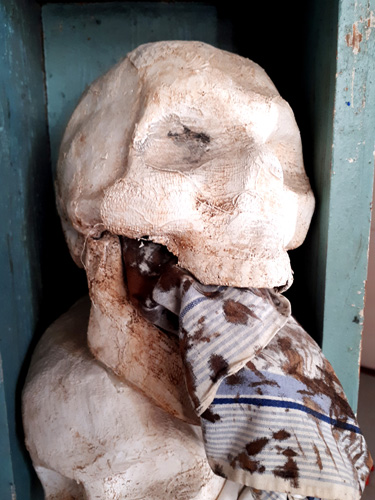
b a c k to group15november.com // to interment.de
Retrospective
(An alphapictonumeric text)
Written by Péter Farkas
Translated by Timea Balogh
(and Éva Zsizsmann until “The Pieces of the Exhibition”)
The translation was checked and proofread by Fabian Farkas, Alastair MacLennan
and Brian Patterson
/Some images enlarge when the cursor hovers above them/

It was exactly sixteen years later, at the flea market in Klettenberg, that he first thought about writing Josef's story. Another twelve years passed, and still all he knew was that Josef's story was that of an exhibition. Over the previous twenty-eight years, he had written more than 15,448 words of fragmented notes. It is an astonishing feat if we consider his remarks written shortly before this text: "I don't remember when I became mute. Was it when Cain slayed Abel? Certainly long before, probably before I started speaking, trapped in one of the cataclysmic wells of being for the past ten, hundred or a thousand years. I've only been able to stutter or remain silent since. It is the scripted or oral variant of this silence that I consider literature, how I try to write or pull myself through the stages of speechlessness or aphasia, dragging my numb limbs, like a cripple who's fallen out of his wheelchair. Of course, there are other kinds of literature too, but I'm not good at other kinds; as I am not capable of entertaining and I have never wanted to teach. I am not showing off as a tragic character—there is no tragedy here. Tragedy means that even when things can go another way, they end in catastrophe. Tragedy is for entertaining ourselves and others anyway, and, as I have mentioned, I am not an entertainer. What I do have, however, what everyone is fated to have, is drama. Literature that has its origins in stuttering or speechlessness is dramatic in nature, and the fate behind it is also dramatic. I had intimations about this by the end of the eighties already, but—as I see it now—the intimations had not yet consolidated into knowledge, and so I could not recognize or accept my capabilities and limitations. Or, put self-ironically, I was in the pre-romantic stage of my life. That was when Josef appeared as part of my day to day. It was a restless, dangerous period, hysterical and self-destructive…" It was indeed a dramatic period. Writing became impossible for him again, and his every day turned into a struggle of life and death in the most existential sense. He fled to the downstairs apartment and hid among the frozen walls in his poison-green ski suit, for days. "I could neither live nor kill myself," he read. But he went on living, while slaying himself every hour. Others unconsciously but undeniably sustained his existence, as they did not know about his many deaths. That's when Josef visited him for the first time. He himself was not otherwise a particularly interesting figure. The core of him was incredibly boring, as he considered everything with tired disinterest; he usually directed his inner life toward pointless and aimless hysteria. As for his outward appearance, he certainly had some strange features: his green ski suit, for instance, which people often pictured when he came to mind, and which qualified him as an interesting figure. Josef was totally loaded— "chemically speaking," as he later put it. He hardly spoke any German. They understood each other, either despite, or because of that. They sat around in the freezing cold apartment for a while, and then he asked Josef what he's doing. "There are three of us," Josef said with a kind smile. "Mary, Yorick, and me," he added. "And you perform together?" he asked. "No", Josef said, "we don't perform". Sixteen years later (September 18th, 2005, at 9:35 am—he'd never been so exact in his notes before), at the Klettenberg flea market, he leaned against the lid of a trash can and wrote about the conversation in a more sober state, declaring that this was the first time he thought about writing Josef's story. This statement, as it stands, is not actually true, but we won't get into the details of this now.
For once, there was a parking spot in front of the house, but he had to reverse slightly to fit into the tight space between the two cars. He turned off the engine, pulled the key out of the ignition, grabbed his cell from the car seat, but did not get out of the car right away. Dreamily he stared at the gate of the house, which was just at eye-level, and for a moment he had the feeling that he was standing in front of him, on the middle step. He smiled at his own triviality; little did he know yet the existential role that step would come to play in his life. He got out of his car and first went to the downstairs apartment, without any apparent goal. Once he was inside, he decided to take the dirty sheets upstairs. He mechanically pulled off the duvet covers and pillowcases. He wrapped them all in a single sheet and was about to leave when he noticed a handwritten note on the table. He recognized that it was Josef's handwriting from the letters, which were always hastily scrawled onto the paper rather than written with care. He put down the bundle and picked up the paper. Based on the first few lines, he did not expect the letter would eventually address someone personally. After the letter, which covered about two-thirds of the page, Josef had written a coda: "If you have time and energy, finish it. I have to go."
On the first morning, he went down to invite them upstairs for breakfast. He did not yet know that such things were not possible. He tapped the doorbell as a signal and opened the door to the apartment with his key. Inside, he stopped at the door leading into the room, calling out to them cautiously, but there was no answer. He thought they might still be sleeping and went into the room with the balcony, opening to the right. This room was divided by a roughly two-meter-high wallpapered wall. This divider did not reach the ceiling, so there was about a meter and a half of wall that was visible of the inner room beyond the divider. This was where they later hung portraits of the late Ulrike Meinhof, Andreas Baader, and other corpses. Josef probably did not recognize the pictures when B.N. hung them directly under the ceiling. He only looked at the black and white photo of Ulrike Meinhof, slightly tilting his head as if trying to figure out what the half-closed, far-gazing eyes were looking at. When he later recalled the scene, it seemed to him that Josef was likely not aware that he was looking at the portrait of a dead person. He lodged Josef and the others behind the dividing wall, and this was where he entered after a brief, unanswered hello, but there was no one there. He raised his eyes from the empty mattress and glimpsed the armless, black doll leaning lopsidedly against the opposite wall. (Strangely, one of the dolls in Conception Disorders—Mary, the biblical one in this case—would also later be missing both her hands.)
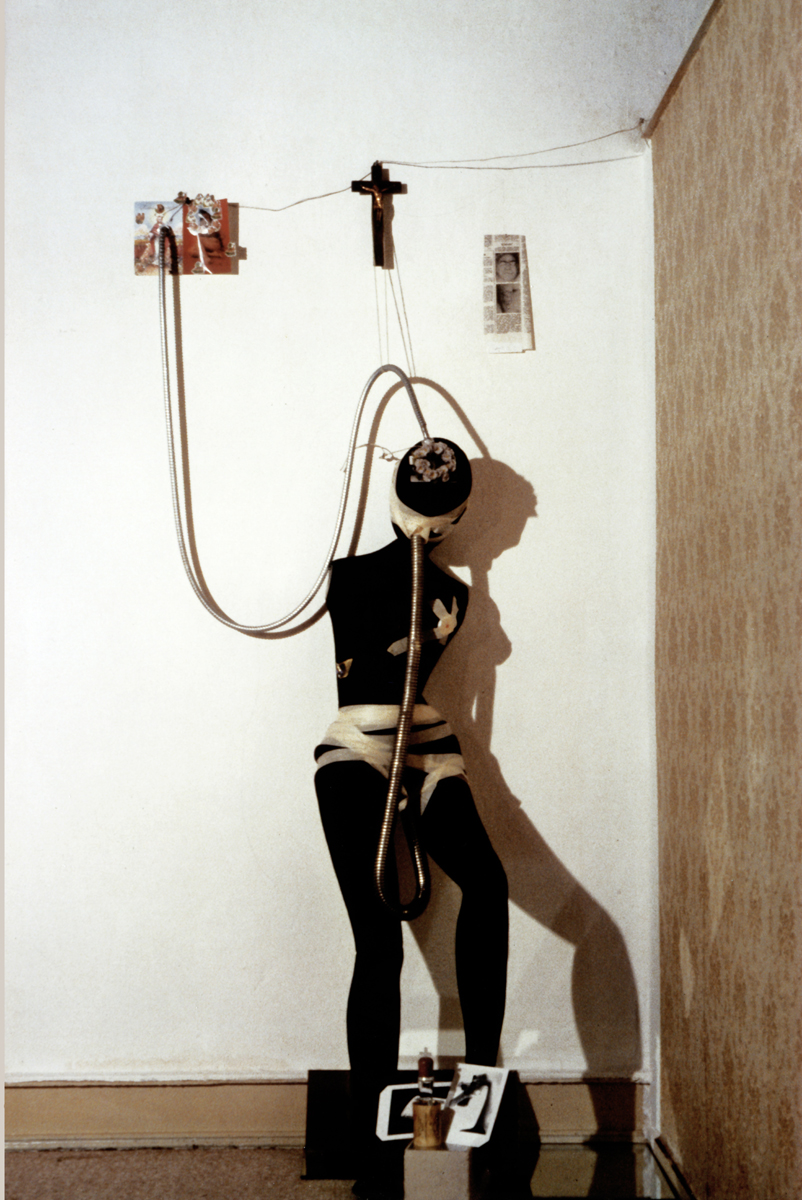
In all probability, none of them thought, at that time, that their encounter would lead to an exhibition. Therefore, they likely made the installation of objects found in the downstairs apartment spontaneously, for their own fun. "As I examine the photos of the installation," he wrote in his notes sixteen or seventeen years later, "I discover several objects and props that were put in their 'final' place only later. The cross above the doll's head becomes the third variation of Mein Gott fixed to a book cover (the Christ, removed from the first variation, is later nailed facing the cross; he also lost one of his outstretched plaster arms during packing, when it hit the edge of a wooden box and broke off). The kitschy Easter card tied to the half-naked, squinting hologram-woman to the left of it also became independent; the stone block at the doll's feet displays some found polaroids that would later end up in the White Book, just opposite the photo of the pregnant Mary. On the other side, next to each other, are two photos facing different directions: an embryo, still covered, and a hand inserting a cartridge into a revolver with precision and the word 'Doppelmord' written above it."

The only remaining photo
of the installation clearly shows the tape placed on the doll at the level of
its heart. It was used to fix a large coin-sized gadget playing a tune on the
doll's breast. He'd taken it out of a teddy bear he'd fished out of a dumpster,
long before Josef's arrival. 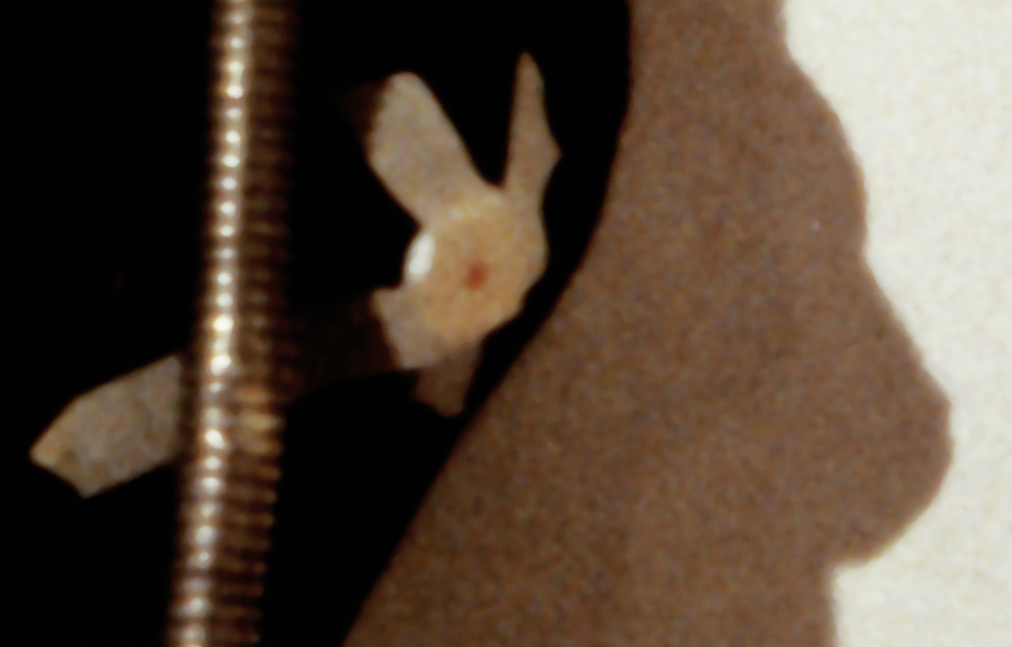 "Heart transplant," he thought, while pushing the doll's breast, as
he was curious to see if the gadget was still working. Oddly enough,
he has spent a large portion of his days during
the past ten years doing his office tasks seated in front of the wall where
the doll stood. That's what he should be doing now, instead of looking
at the photo taken twenty-eight years ago, the metal-covered plastic tube coiling
upwards from between the doll's legs
"Heart transplant," he thought, while pushing the doll's breast, as
he was curious to see if the gadget was still working. Oddly enough,
he has spent a large portion of his days during
the past ten years doing his office tasks seated in front of the wall where
the doll stood. That's what he should be doing now, instead of looking
at the photo taken twenty-eight years ago, the metal-covered plastic tube coiling
upwards from between the doll's legs 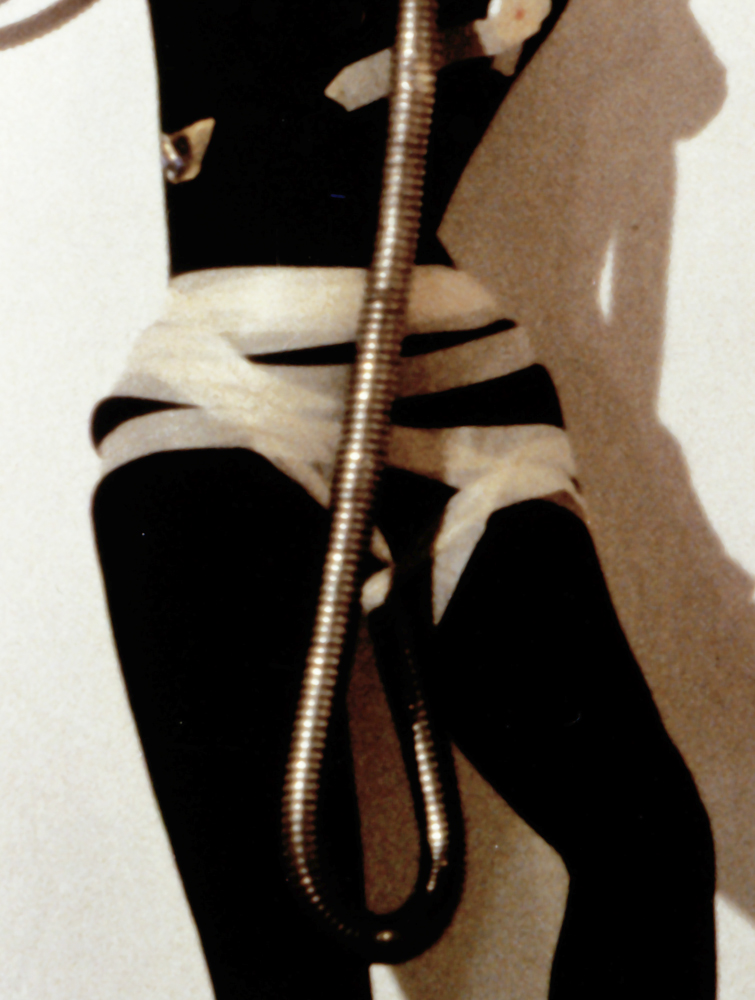 ,
fixed around the mouth of the faceless head and reemerging at the top of the
skull, meandering up to Jesus' heart.
,
fixed around the mouth of the faceless head and reemerging at the top of the
skull, meandering up to Jesus' heart.
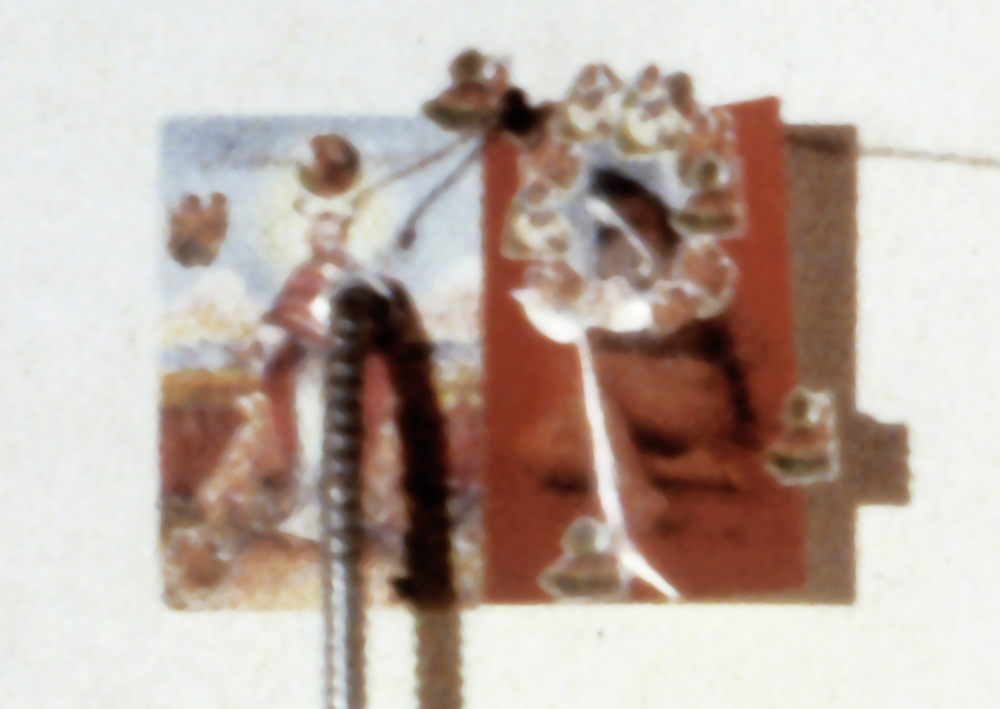
The inscription on the envelope containing the photo probably referred to this: "Gotteszirkulation". When he found the photo-series entitled Josef Drops His Seed in the estate, he was surprised to discover that Josef masturbated on, or with, this doll five years before their encounter, several continents away. Perhaps the sense of touch seen in the picture made him recall the unpleasant feel of the doll. It was covered in a rough, thin, black layer of sponge that over time fell off in flakes, as if some strange cutaneous disease had attacked it. It had an unpleasant, filthy feel to the touch. That's obviously why he eventually threw it out, and because of its structural integrity, of course, as it was impossible to stand it up without it falling over from the slightest movement.
He examines the faces—the
three, oval-framed pictures on the back of the poster—and tries to trace, from
these three faces, what happened in the downstairs apartment. 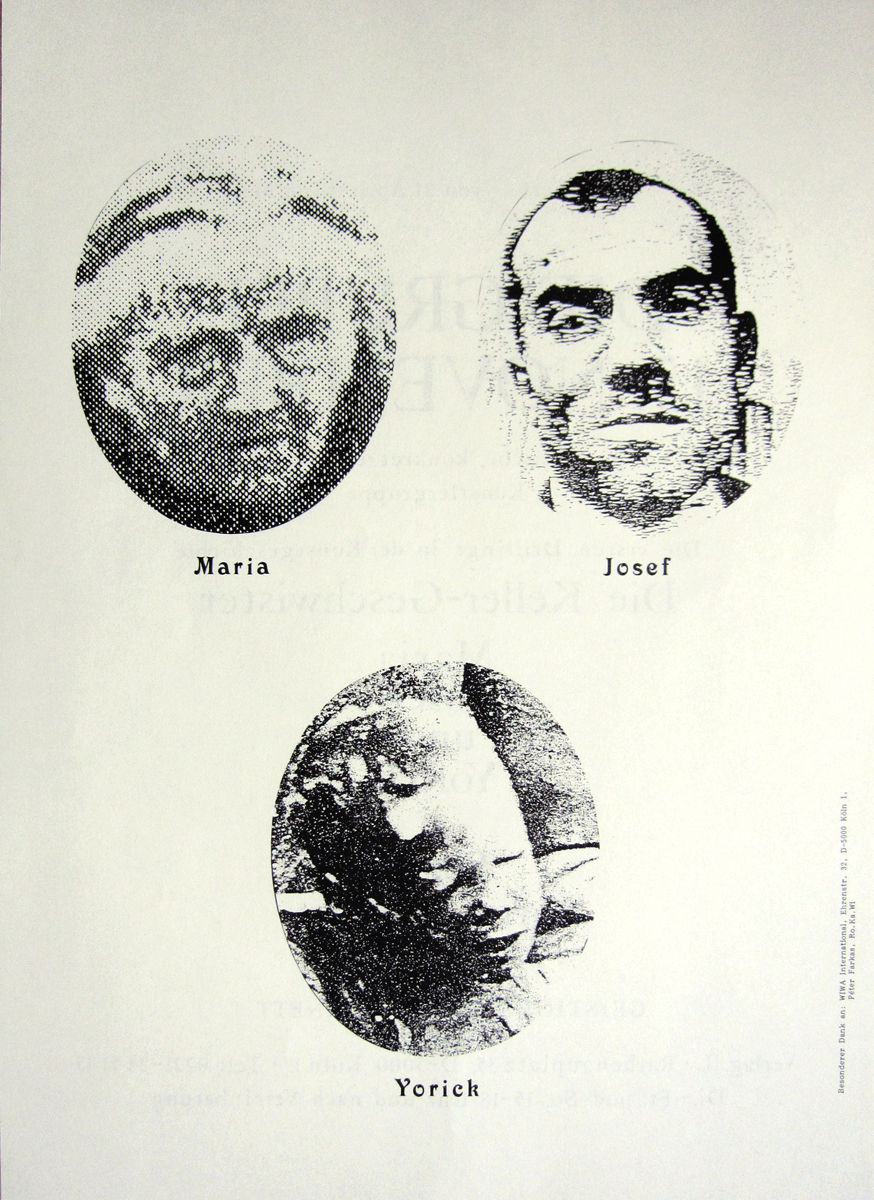 Josef borrowed his face from a Woyzeck, Luigi Lucheni, Sissi's murderer. Josef
probably had not known Lucheni's life story. He just wanted to buy something
from the tobacco shop at the house next door, leafed through the latest issue
of Der Spiegel on the counter before him while waiting for his change,
and had caught sight of Lucheni's picture. He bought the journal absentmindedly,
and when they were looking for motifs for the poster, he took it out, found
the picture, and said, "this will do". What did he see in it? What
did he see in it of himself? The madman? The barbarian? The time-bomb? The assassin?
Woyzeck? The murderer, for whom the act of murder is freedom, freeing oneself
from society? The eternal loser? Who knows for certain the moment he gains consciousness
that he has no chance in life and never will? He saw the face often over the
years, while arranging the material: the scornful, sideways look, the relentless
stubbornness of the lines in his face, the brutal simplicity of the skull, as
if it was cut out of a log by a hatchet.
Josef borrowed his face from a Woyzeck, Luigi Lucheni, Sissi's murderer. Josef
probably had not known Lucheni's life story. He just wanted to buy something
from the tobacco shop at the house next door, leafed through the latest issue
of Der Spiegel on the counter before him while waiting for his change,
and had caught sight of Lucheni's picture. He bought the journal absentmindedly,
and when they were looking for motifs for the poster, he took it out, found
the picture, and said, "this will do". What did he see in it? What
did he see in it of himself? The madman? The barbarian? The time-bomb? The assassin?
Woyzeck? The murderer, for whom the act of murder is freedom, freeing oneself
from society? The eternal loser? Who knows for certain the moment he gains consciousness
that he has no chance in life and never will? He saw the face often over the
years, while arranging the material: the scornful, sideways look, the relentless
stubbornness of the lines in his face, the brutal simplicity of the skull, as
if it was cut out of a log by a hatchet.
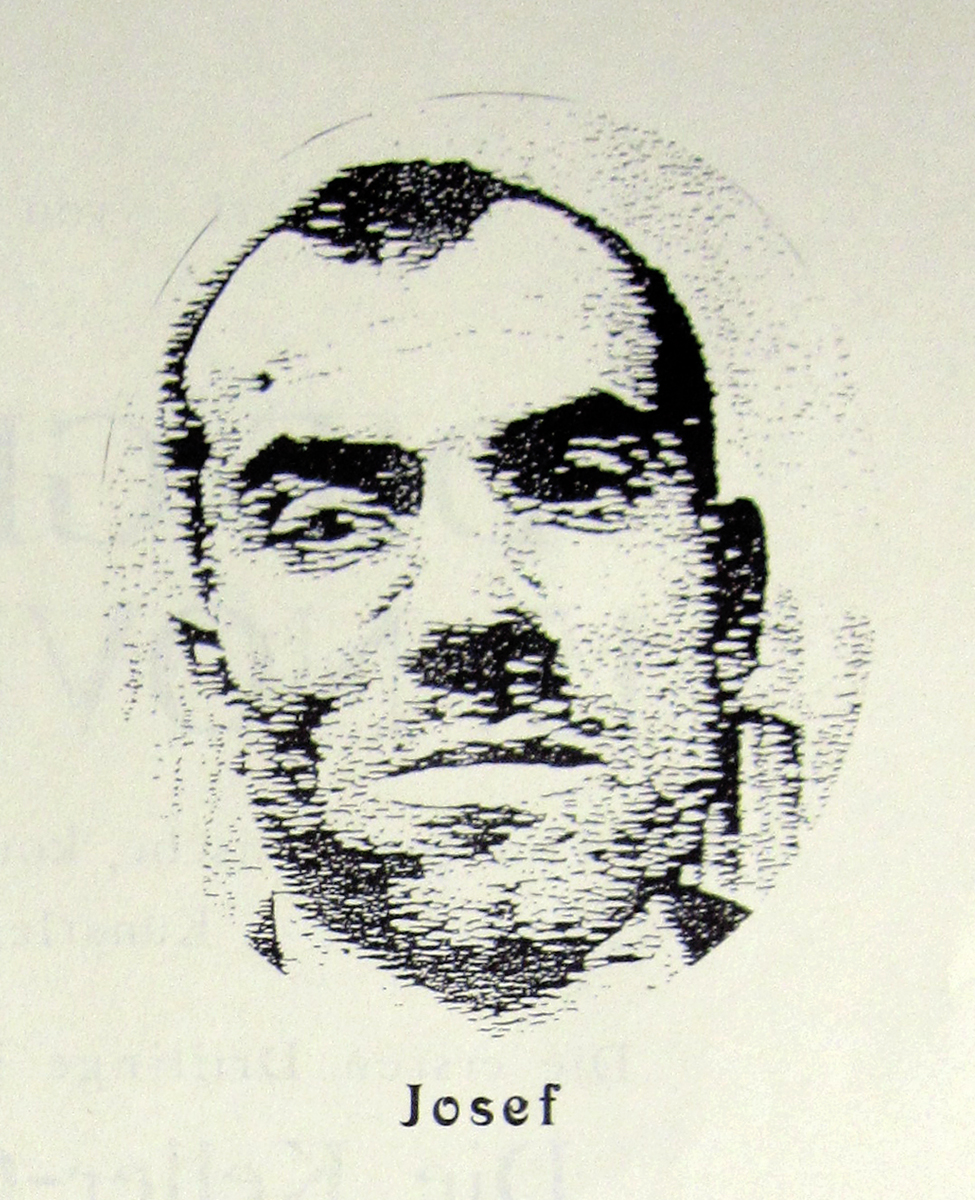
He knew all three faces
well. The girl, the mother and the old woman. The four intertwined hands  and the bombed, decomposing city behind them. He often thought this was the
only thing he knew, because this is what he carried in his genes. Were he to
let his cells ripen, they could reproduce nothing but this. Everything was about
them—the smoke, the soot, and the smell pervaded everything, relentlessly blocking
doors, windows, body crevices and the fallopian tube. This is why he was in
love with K, why he stole her pregnancy photos from the upstairs apartment,
keeping her torn scraps of paper in a jar with a lid. He pasted these pieces
into the White Book, as if shrapnel had exploded on the white pages.
Finally, he chose the face of the old woman fleeing, the almost apologetically
broken face looking into the objective lens of the camera, like a tired little
girl. Only the mother turns around—she's certainly the one capable of losing
the most. They were a few hundred meters away from the boulevard when the old
woman asked her daughter, stumbling among the charred bodies, "Tell me,
mother, where did all these niggers come from?"
and the bombed, decomposing city behind them. He often thought this was the
only thing he knew, because this is what he carried in his genes. Were he to
let his cells ripen, they could reproduce nothing but this. Everything was about
them—the smoke, the soot, and the smell pervaded everything, relentlessly blocking
doors, windows, body crevices and the fallopian tube. This is why he was in
love with K, why he stole her pregnancy photos from the upstairs apartment,
keeping her torn scraps of paper in a jar with a lid. He pasted these pieces
into the White Book, as if shrapnel had exploded on the white pages.
Finally, he chose the face of the old woman fleeing, the almost apologetically
broken face looking into the objective lens of the camera, like a tired little
girl. Only the mother turns around—she's certainly the one capable of losing
the most. They were a few hundred meters away from the boulevard when the old
woman asked her daughter, stumbling among the charred bodies, "Tell me,
mother, where did all these niggers come from?"
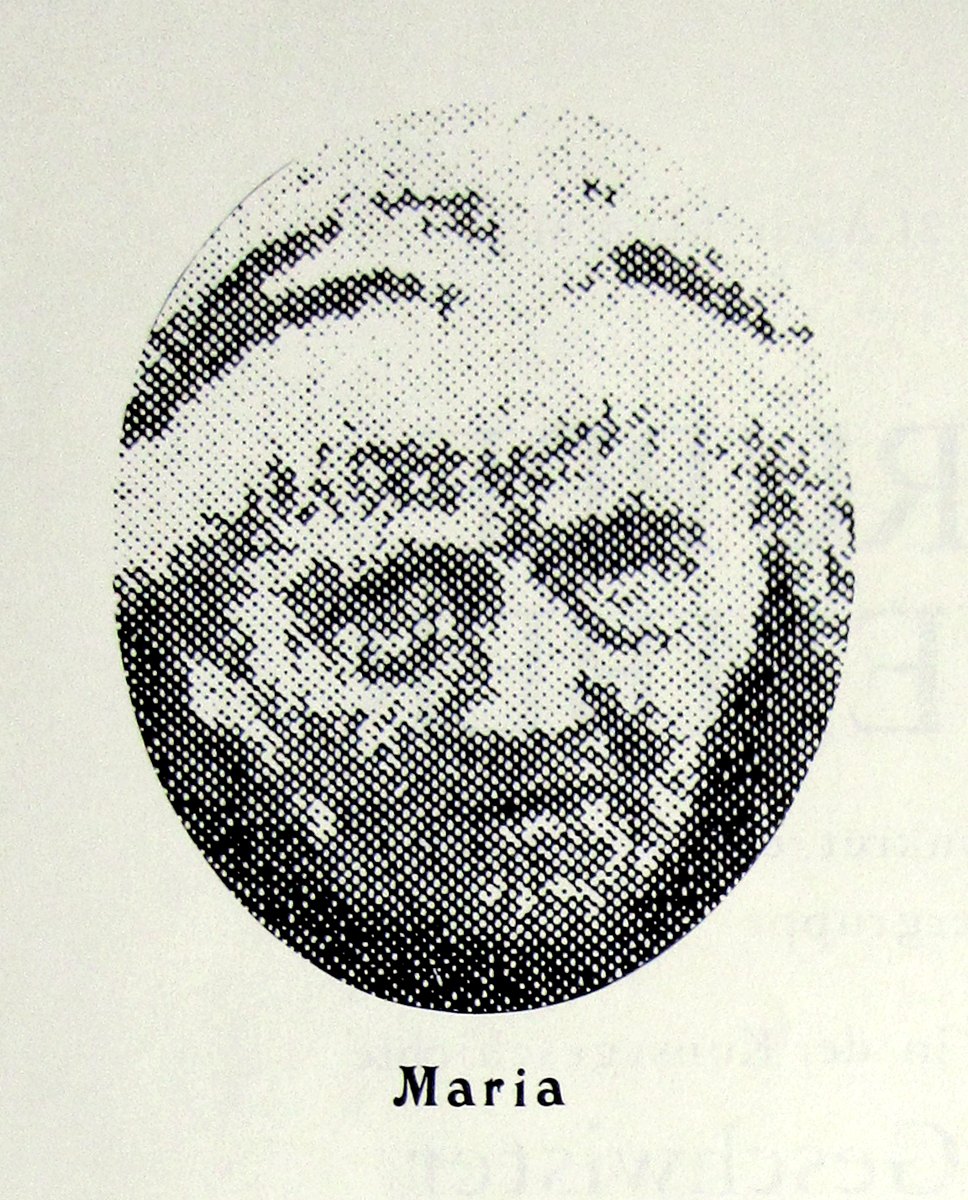
The last time he met up with Mary was in Potsdam. That is, if her presence can be considered meeting up with her. End of the world, an apocalyptic scene, as in a Tarkovsky film. The soil and air were toxic, demolished buildings everywhere. He was probably looking for a motif for the light-sensitive walls of the White House, or just wandering in the otherwise closed zone. It was a long, tall, one-part, single-floor building of uncertain function, like an abandoned industrial barn. Its narrow windows were shattered, the gates broken open, some of the openings dark and empty. As he entered one of them, a thick, net-like greyness surrounded him, almost touchable, like loose cotton bales. All sorts of unidentifiable rubble were around him, and heavy, dusty air. At first, he thought he heard his own steps, but then he had the impression that they lasted a few seconds longer than his own. He stopped, listened, but the synchronicity was nearly perfect. A part of the building may have creaked, or the attraction of the pervasive look reached him. In any case, he suddenly raised his head and caught a glimpse of a lynx standing almost directly in front of him, though quite a bit higher, on a narrow metal girder. Its legs were motionless, caught between two steps, its body stretched out long and thin, and its ears flattened tight against its head. The animal stood as a statue, high above, with yellow eyes blinking like lasers, wedged deeply into its pupils. At that moment, he knew for certain it was Mary. He did not turn his gaze, but slowly backed out of the building.
Yorick's portrait appears
as a section of the triptych Boys, and in the two golden boxes as well.
In the days after the opening of the exhibition he spent quite a lot of time
in the downstairs apartment as a lonely attendant. He started his service by
walking through the rooms and looking at the exhibited pieces. He would spend
more time in front of the Holodomor still life, in the "Eastern" wing
of I Love Status Quo, where the source of Yorick's portrait could also
be seen, and tried to imagine the circumstances of the taking of this photo:
the surroundings, the characters, the photographer as he arranges a scene that
does not normally exist—the way he finds the cannibals in Ukraine at the beginning
of the 1930s, scouts for a proper location, arranges or perhaps has someone
arrange the remnants on the table, waits for the proper light, sets up his equipment,
gives instructions to those two utterly strange creatures, and then takes
the photo  .Why
did the cannibals comply? For money? Surely not, as they could not get anything
with it. Probably for food. But then why did they let the photographer live?
Why didn't they butcher him? Why didn't they eat him? These days, I am more
interested in the old woman than I am in the child whose face Josef carved out
for Yorick's portrait. The woman's face. She has no eyes—
.Why
did the cannibals comply? For money? Surely not, as they could not get anything
with it. Probably for food. But then why did they let the photographer live?
Why didn't they butcher him? Why didn't they eat him? These days, I am more
interested in the old woman than I am in the child whose face Josef carved out
for Yorick's portrait. The woman's face. She has no eyes—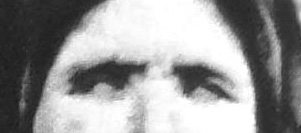 just like how the Goddess of War will have no eyes. Did they realize this then?
Did he realize it then? Or did he just spot the half-devoured child, the body
still alive in its gestures and movements, the suffering spread through the
face, not being able to turn his eyes away from him, from himself? Because it's
not the other's body, not the other's face. The miserable clown of suffering.
Yorick.
just like how the Goddess of War will have no eyes. Did they realize this then?
Did he realize it then? Or did he just spot the half-devoured child, the body
still alive in its gestures and movements, the suffering spread through the
face, not being able to turn his eyes away from him, from himself? Because it's
not the other's body, not the other's face. The miserable clown of suffering.
Yorick.
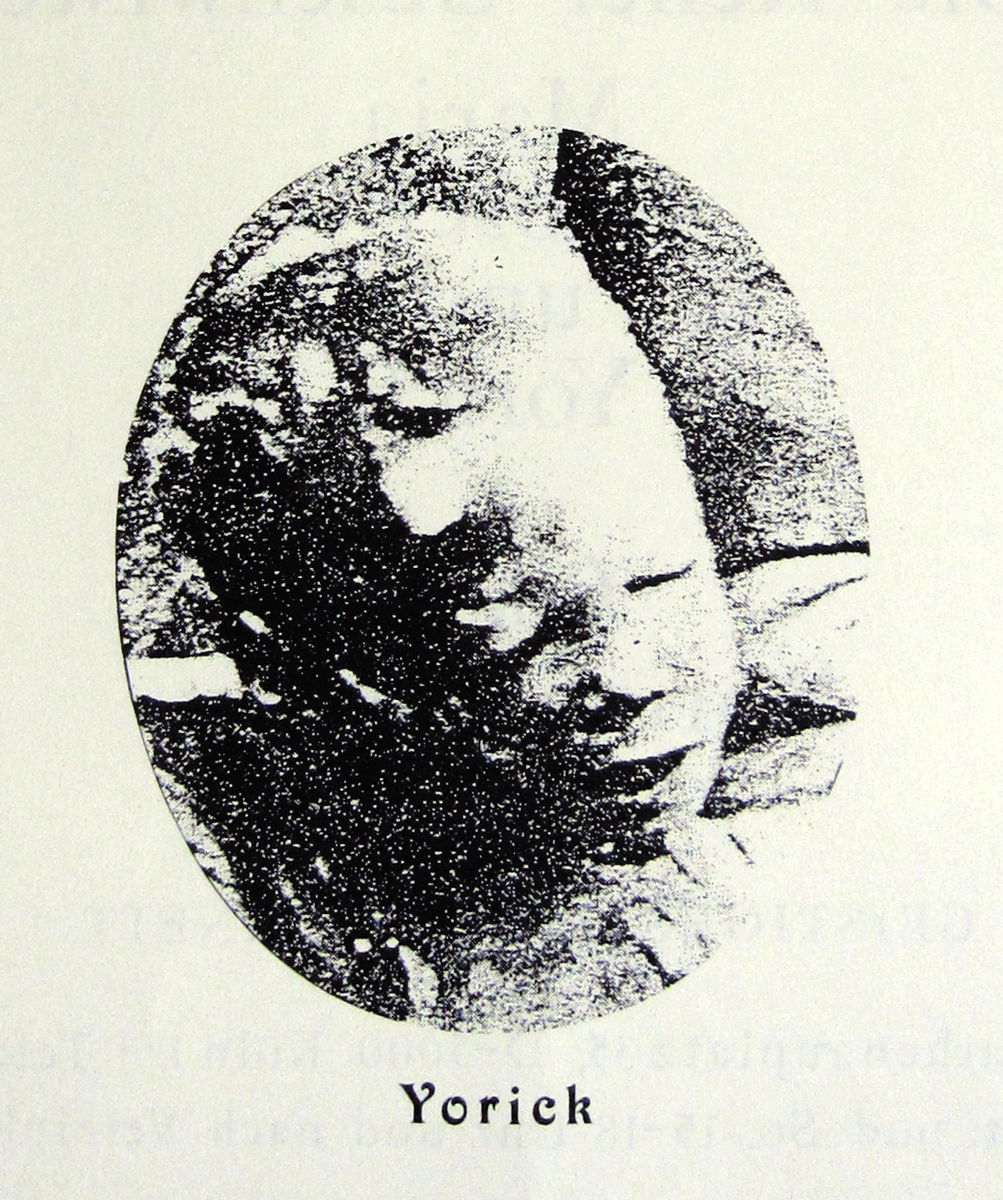
The three of them and the three portraits. Three identical pictures, faces, people—just like the exhibited objects. They speak with the same pitch, the same voice. Different text-images with the same meaning. "These three faces to help trace what happened in the downstairs apartment. Is it simply ruthlessness, or is there also mercy? And if so, who can benefit from it?" he once wrote on a piece of paper. The text on the poster is: "The Humane Gesellschaft für Geistige Nekrophilie presents Die Gruppe 15. November, from April 21st to May 8th. This is a post-Gothic, concrete expressionist art group. Art history's first triplets. The Keller siblings. Mary, Josef, and Yorick. Guest: Boris Nieslony. Spiritual Cabinet of Curiosities I, Verlag IL, Rathenauplatz 35, 5000 Cologne 1, Tel: 0221-245115, Tuesday to Friday and Sunday from 3-6pm, and by appointment."
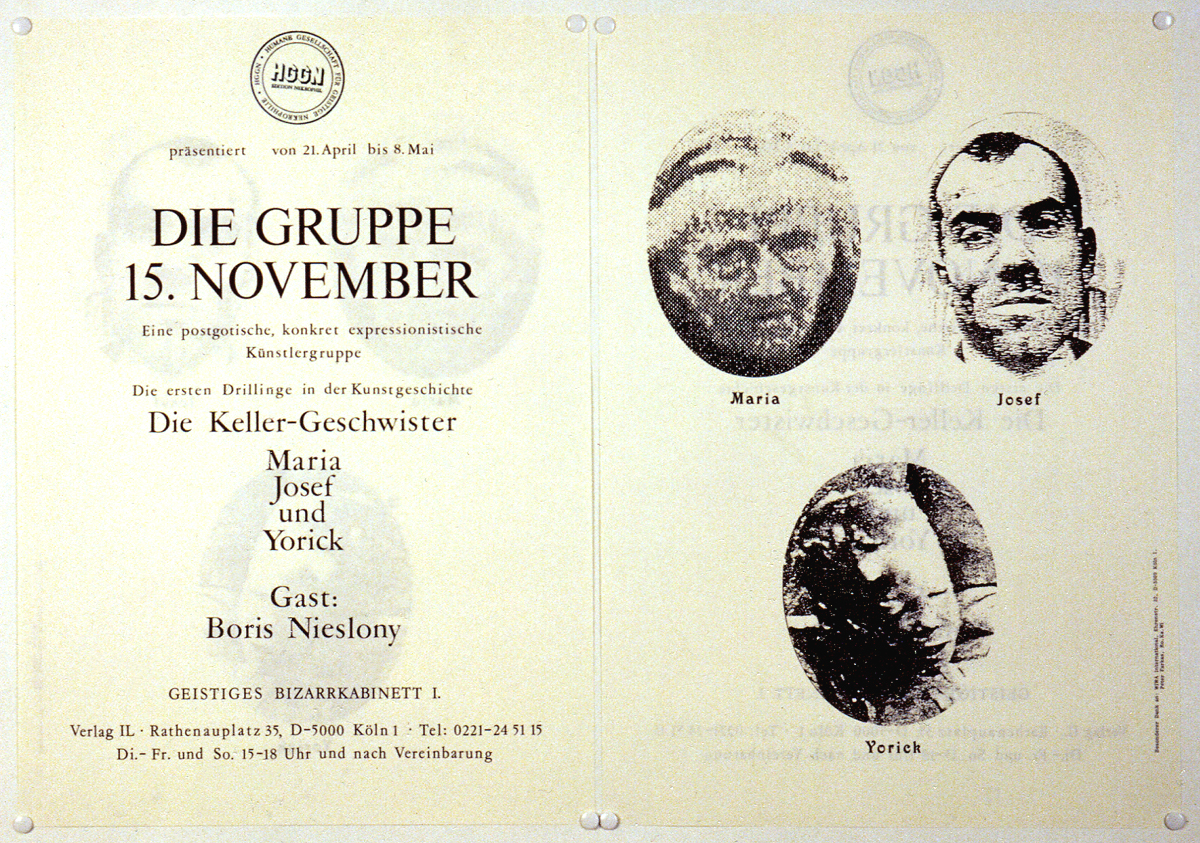
The house 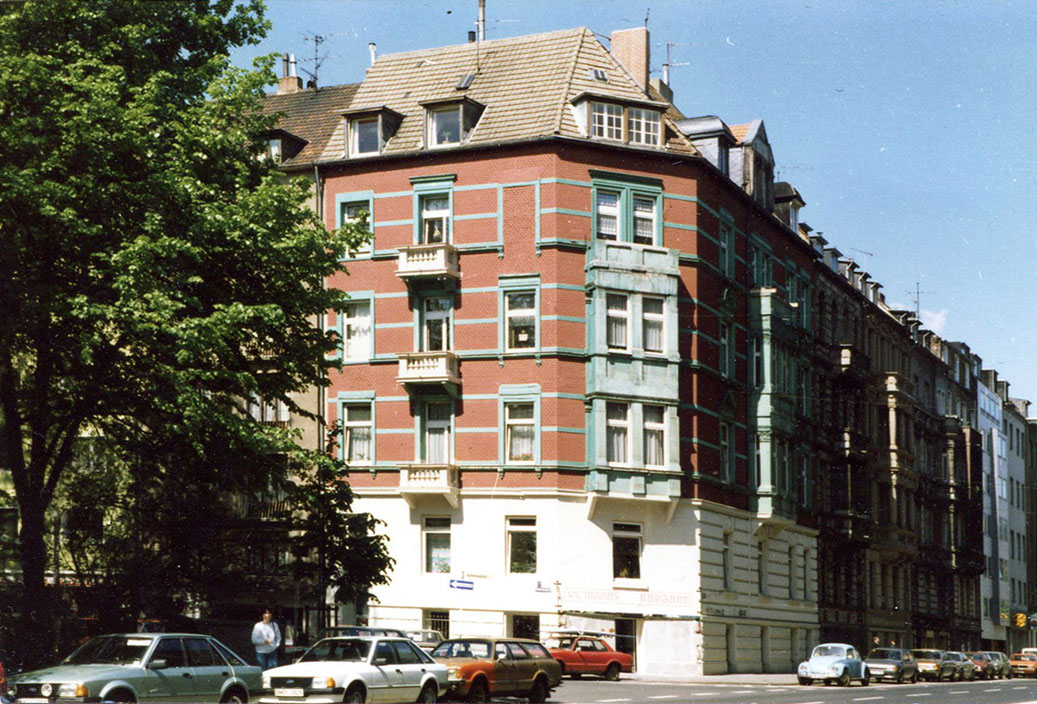 .
The space and time of his being, from which he will, at some point, be unable
to leave—without even being there. There was a time when he often thought that,
while it would have been unlikely, Josef may have been referring to this in
that last message he'd left on the desk. Who would he have been writing to?
.
The space and time of his being, from which he will, at some point, be unable
to leave—without even being there. There was a time when he often thought that,
while it would have been unlikely, Josef may have been referring to this in
that last message he'd left on the desk. Who would he have been writing to?
The
pieces of the exhibition that can be catalogued, if we enter the room from
the foyer and walk to the left (Josef had not decided on a direction, but the
exhibition's whole concept unquestionably follows this order):
1. Tierdenkmal – Pet Memorial
2. Versamte / Versäumte Ahnen – Mis-se(e)d Ancestors
3. Kulturornamentik I – Culture Ornamentation I
4. I Love Status Quo
5. Heldendenkmal – Heroic Memorial
6. Jungs – Boys
7. Katyn / Totentaufe I. - Katyn / Dead Christening I.
8. Kulturornamentik II. und Der zum Schweigen gebrachte Krieg (Foto) – Culture
Ornamentation II and the Silenced War
9. Wunderkisten - Magical Boxes (Gold Boxes)
- Guten Appetit - Morgen Kinder wird's was geben (Jukebox) / Bon Appetit – Tomorrow,
Children, Something Will Be (Jukebox)
- Bon Appétit (Abendmahl) / Bon Appétit (Last Supper)
- Babyfalle (Jukebox) / Babytrap (Jukebox)
10. Denkmal der deutschen Wunder – The German (Economic) Miracle Memorial
Boris Nieslony's installations:
Ofen – Oven (Furnace); o.T. - (Aufenthaltsgenehmigung/Residence Permit); Aus
der Einrichtung XIII (From the Institution XIII)
Pet Memorial. "I can only think in terms of one idea," Josef said once, "the idea of the Holocaust. This is the only thing, the only mystery, that truly interests me. If it can be explained, then mankind can be explained." During the time they stayed here, the BSE (Mad Cow Disease) hysteria was at its peak. Every night, bonfires raged on peoples' TV screens, as if they were electric fireplaces. The picture of the pet memorial bonfire is from one of those bonfires. Turned upside-down, it's a medieval battle image. Horse hooves, clouds of smoke, instead of clouds of dust, bonfire.
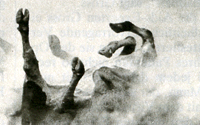
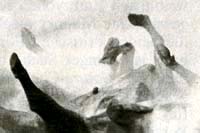
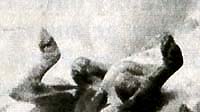
Furnace and oven in German: Ofen. They do not have different words for the two appliances. What had perhaps compelled him to exclusively use silver spray paint that's used for furnaces, was the close proximity of the exhibited piece to a furnace that had been turned into an oven. The first thing he sprayed with it was a picture purchased from a dollar store with a roaring stag on it. The embossed metal image was in a fake oak metal frame. Oak, Eiche; furnace and Ofen, Goethe and Schiller. But definitely not Heine. He worked like altar builders. "To build the altars of kind, hardworking people, that's my goal," he once said. "To photograph into wide exposed mass graves, like they do into exposed cunts, and to hang these up in place of woodland-patterned wall coverings. Pious kitchens would show a much cozier face then. The crackle of the fires in the fireplaces would sound much homelier. Nicht wahr?" he asked. Then he wrote in his notebook: "I compose while playing." Silver Age.
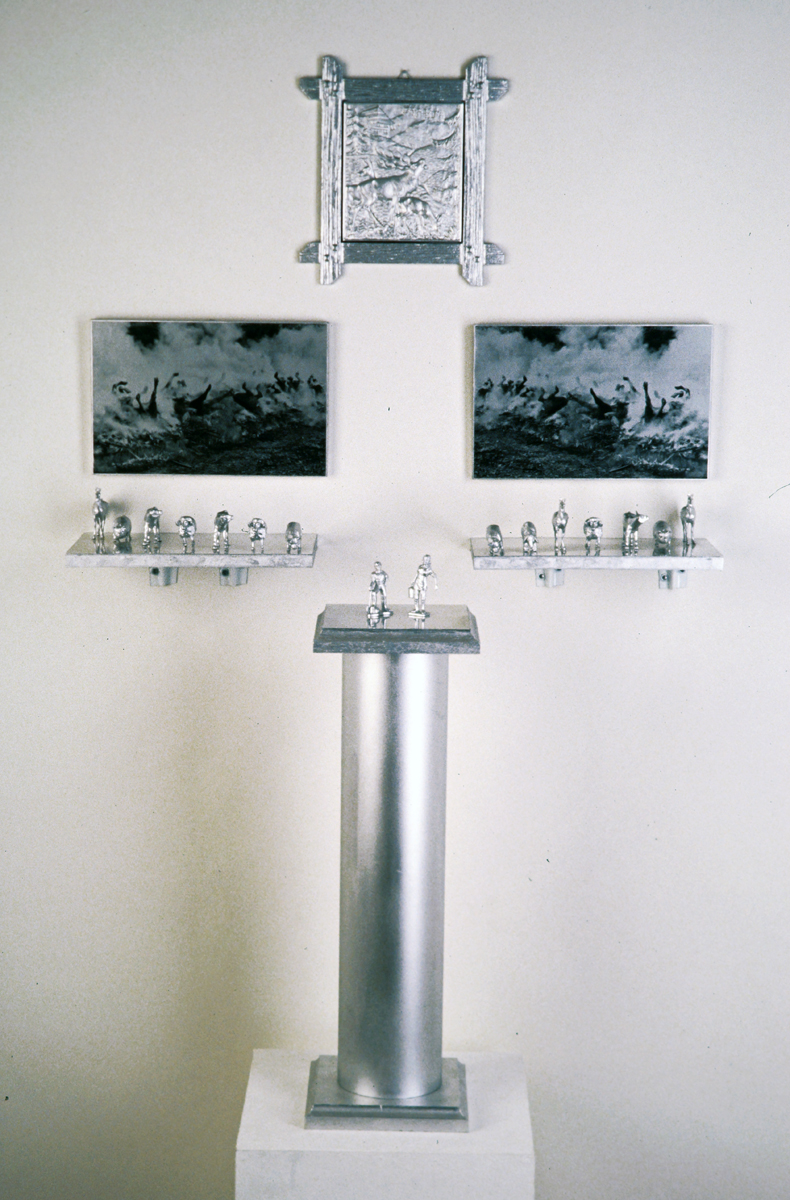
Culture Ornamentation I. As it were, he combined his Pet Memorial and Mis-se(e)d Ancestors installations above the inlay iron furnace furnished by Boris Nieslony. This furnace eventually led him to Paul Celan, to the Mirabeau Bridge, to the Rag and Cloth Mountains. The cloud: smoke; the movement: rigidity; the dust: ash. Human Holocaust, animal holocaust. Reality's kitsch. Banal, trivial, and industrially mass murderous. He considered those who lived in civilization to be inherently racist and racially supremacist. Only then is one capable of consistently and industrially murdering millions of living beings. By fire, bone crusher, gas. That one sometimes does this to one's own species he explained with cannibalistic tendencies. The ornamentation pictured twenty-six slaughtered fowl drawn onto poles. The two cuffed thighs hung from above, the wings open from below; not far below where the head had been severed, a stream of air struck the body from a hole about the same size as the missing head. Serialism is the basic criterion for murder. "Think about it," he said, "man is the only one who murders."

Iron Oven. Ofen aus Eisen. Feuerofen. All B. had said was not to run the heat at night, because he needed to use the furnace the following day. That following day, he brought over the necessary accessories and, like a handyman, built them into the inlay. The women standing in line burned onto the foil, the slides put into plastic frames, scaly claws that gouged into the film. Then he stood up the slide projector in front of the furnace and shone the light into the inlay, beyond the ash-collecting space, onto the naked women waiting their turn. Finally, he affixed the petrified lead heart above the furnace, put his tools away, closed his toolbox, and left. He never built another fire in the furnace. Every afternoon at opening time, he turned on the slide projector lamp, and looked into the inlay from above, through the predacious claws. Smeared, featureless faces.
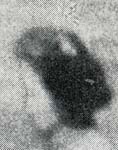
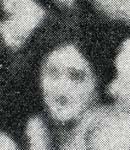
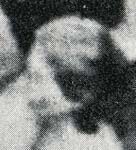
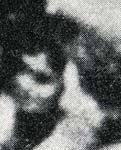
His eyes always landed on the same figure. She stood a little farther back, in the middle of the line, perhaps moving about a bit, and tried to peek over the shoulder of the woman standing before her. What was she curious about? She probably already knew everything, knew precisely what was going on at the front of the line, and what would be waiting for her when she got there. Because, from where she was, a little before the middle of the line, there was little doubt she'd get there.

He took apart the furnace fourteen years later and had it taken away. He needed to take it apart so that he could carry it down the stairs. He put the parts in a small pile on the edge of the sidewalk, so that the iron dealer could park his semi-truck beside it. The whole thing happened at lightning speed. With a handheld remote, the driver directed the arm of a small crane that stretched out from inside the back of the semi. It fell from high above onto the pile with a sudden motion, scooping it up and transporting it to the back of the semi. A few minutes later, only the pile's faint, rusty outline communicated that once, not long ago, there was something there that, from now on, is certainly not there anymore. They took it away. Wurde abgeholt.
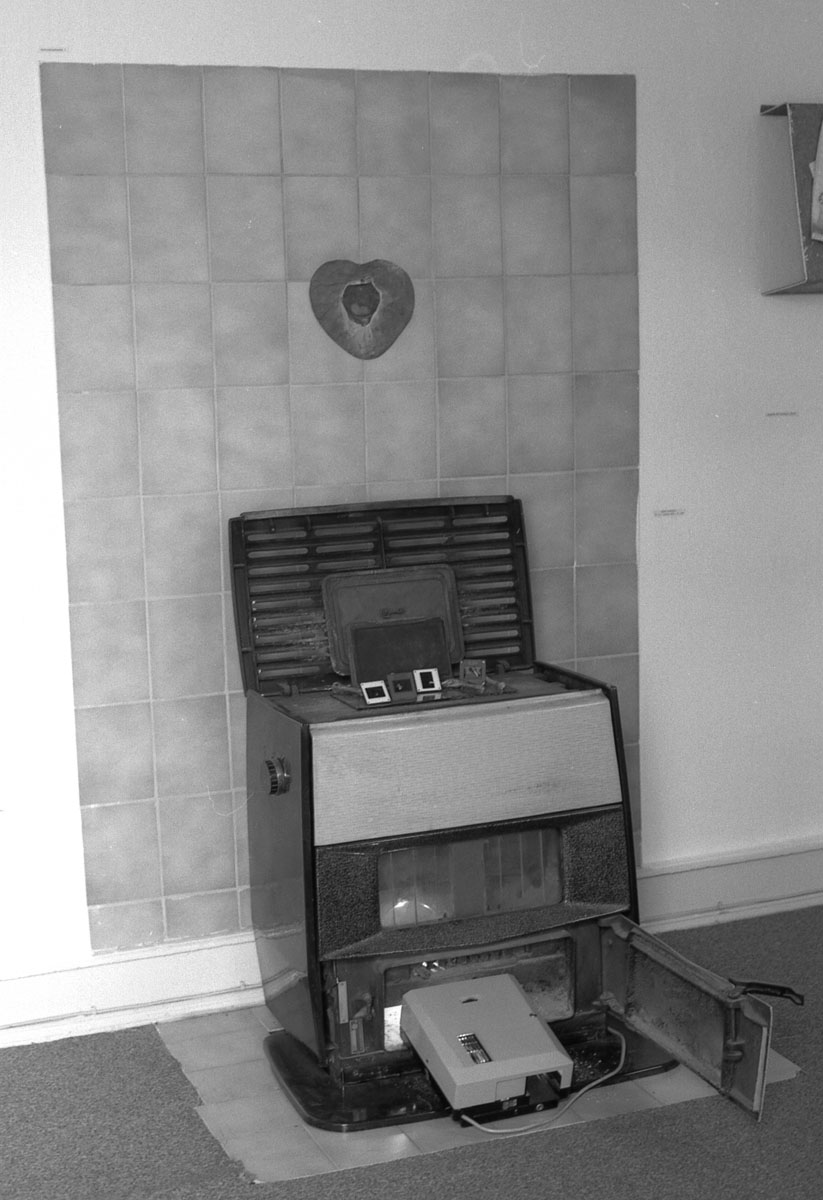
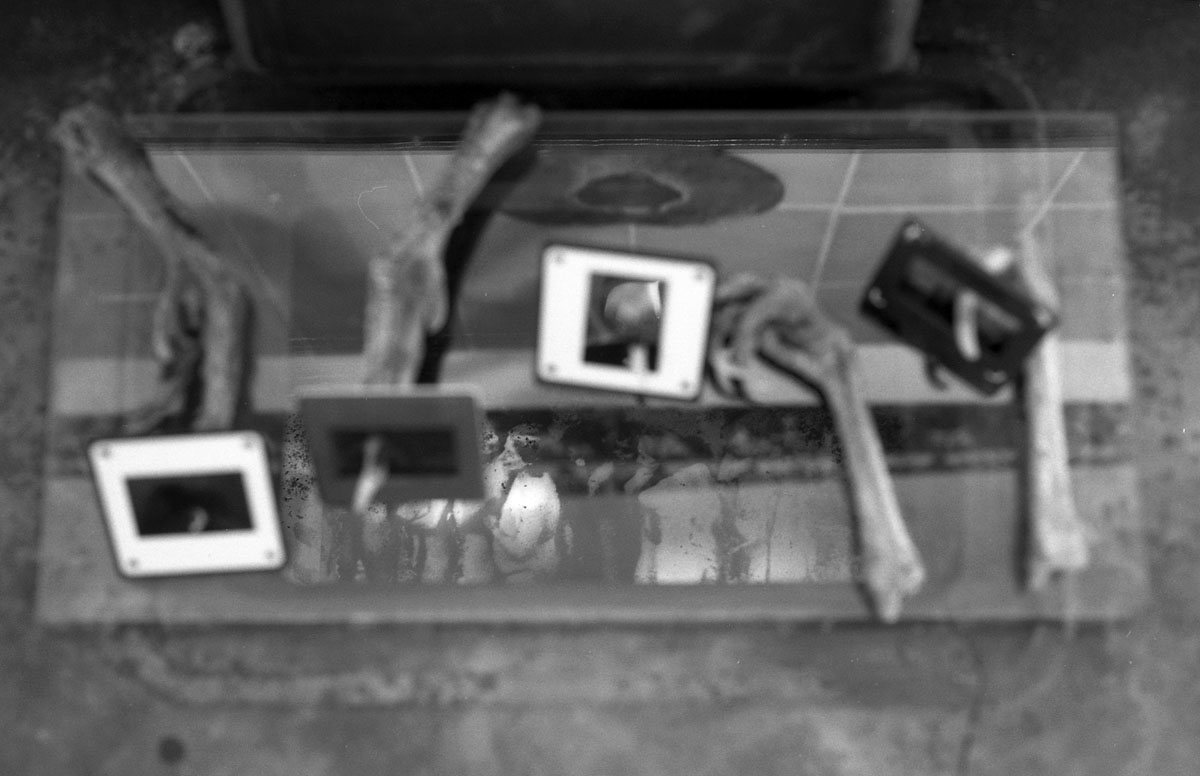
Mis-se(e)d
Ancestors (Versamte / Versäumte Ahnen). In the original title, the word
"seed" (Samen) is just as present as absent (versäumen). For lack
of a better word, this is why I translate it as Mis-se(e)d Ancestors.
The carrier surface is galvanized tin. Brutality, bestiality. Slaughterhouse,
massacre, carnage. On the tin surface kitchen table: carved up animals, disemboweled
carp on Christmas morning, Jesus's birthday. Bloody, slimy, slobbery water.
Terry cloth towel. One day, he laid four carefully folded terry cloth hand towels
on top of one another beside the mattress and gave one to Mary after every act.
Mary wiped herself thoroughly and gave the towel back to Josef. Josef then glued
the colored paper angels to these. 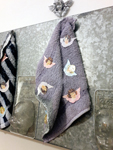 He bought the clear plastic child head moulds
He bought the clear plastic child head moulds 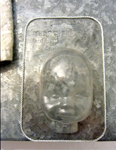 from the toy store next to the Cathedral, the empty, silver landscape picture
frame from a Turkish or Arab dollar store. He was impressed by the depth of
the frame's glimmering, black throat. Deep throat.
from the toy store next to the Cathedral, the empty, silver landscape picture
frame from a Turkish or Arab dollar store. He was impressed by the depth of
the frame's glimmering, black throat. Deep throat.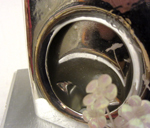
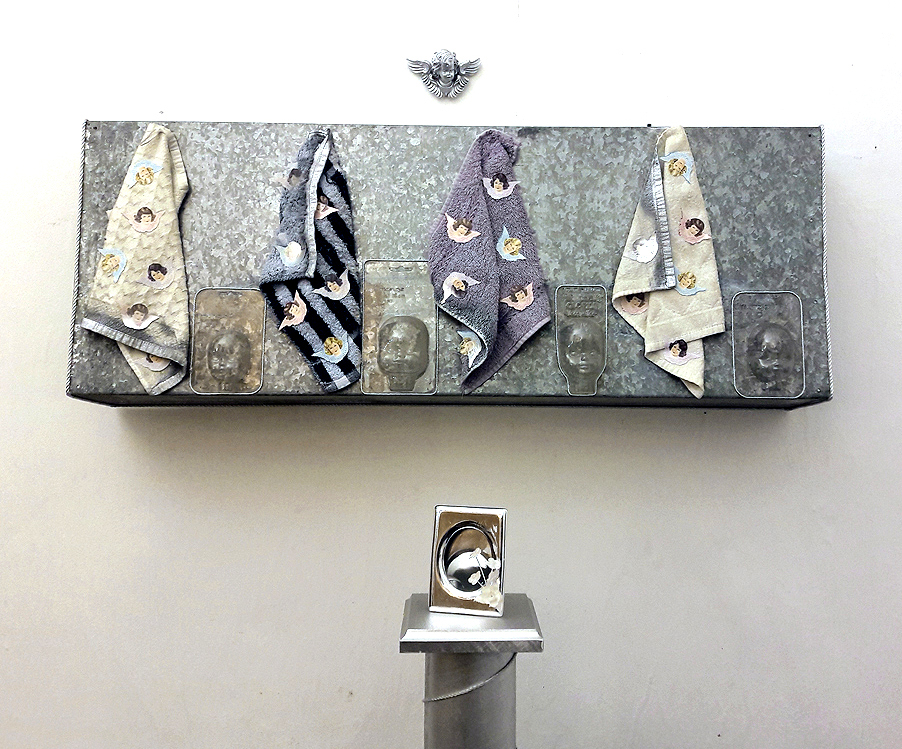
I
Love Status Quo. He came by car late in the afternoon from Südstadt. Not
down the Ring Road, but the avenue that ran parallel to it, where one could
only drive relatively slowly down the one lane that ran between the cars parked
on either side. He had noticed, from afar, how there was a black spot on the
inner part of the road, close to a parked car. He slowed down. It was a black,
box-like object. There was no traffic; he stopped, opened the car door halfway,
and leaned out. It was an unmarked VHS tape that had fallen out of its box.
He picked it up and kept driving. They immediately knew from the title what
was coming. A little bored, they watched the rather unimaginative scenes that
came after one another. Suddenly he yelled: "Stop! Stop!" He wasn't
sure what his warning meant. He froze the image and gave him the TV remote.
He rewound the scene at least three times. And he watched the never-ending flood
with the same perplexity, every time. "It's incredible how much cum can
leave a well-fed man's body," he said, and then took a picture of the screen
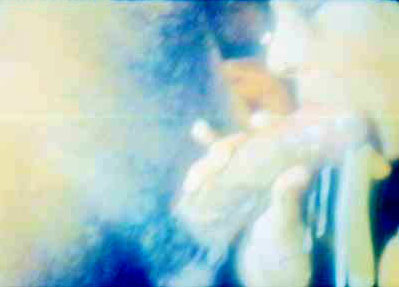 . This became the
third picture, after Holodomor and Jalta. In the fourth picture, he worked with
a stand-in. He was averse to being photographed. "Ich bin ein frommer Jude",
he said, laughing. The typographically accurate Coca-Cola label sewn into the
black and white striped sock is not visible in the picture. The status quo is
the unity of status quo ante and status quo bellum.
. This became the
third picture, after Holodomor and Jalta. In the fourth picture, he worked with
a stand-in. He was averse to being photographed. "Ich bin ein frommer Jude",
he said, laughing. The typographically accurate Coca-Cola label sewn into the
black and white striped sock is not visible in the picture. The status quo is
the unity of status quo ante and status quo bellum.
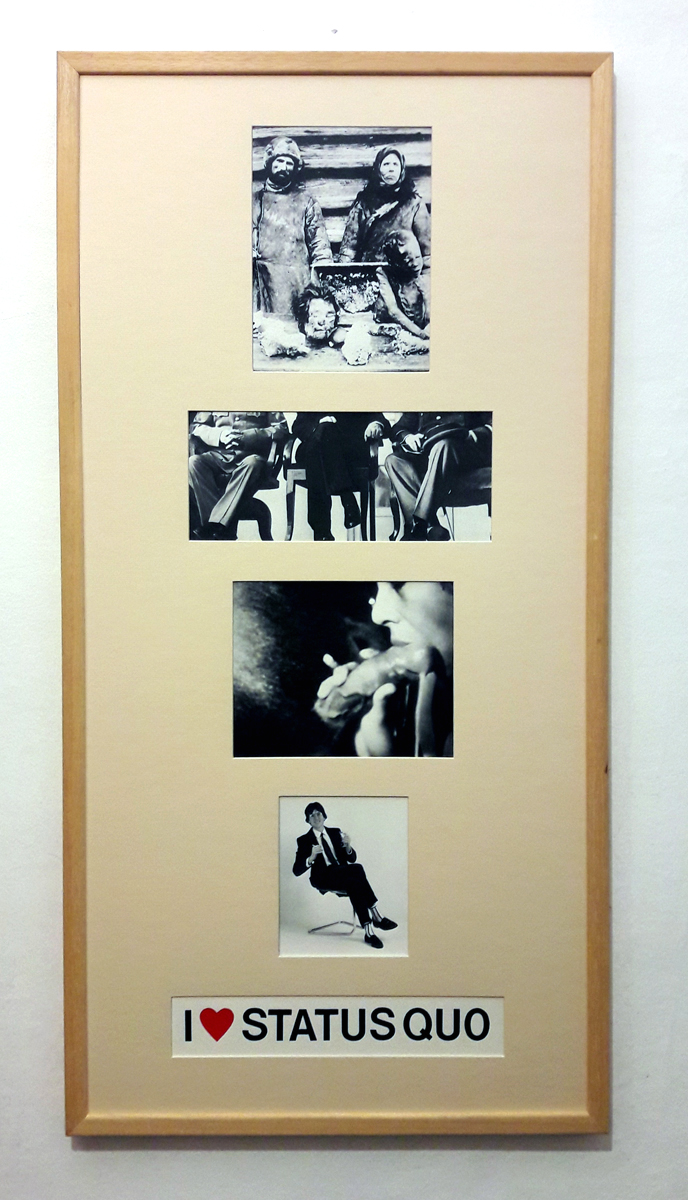
Heroic Memorial. One night, when they were saying goodbye to each other after finishing working, Josef asked him for a porcelain equestrian statue. "A soldier on a horse, or something like that," he said. The next morning, he checked out all the suburban flea markets and indeed found a meter-and-a-half tall, snow white statue. He could not determine with absolute certainty what kind of man was sitting on it; his clothes could have just as easily been a folk costume as a uniform. A gloomy, dark-skinned old woman had sold it to him for a surprisingly cheap price, despite the statue's size and workmanship. He brought it to Josef right away, who picked it up, curiously inspected it, turned it this way and that, then suddenly dropped it. The statue broke into large chunks on the hardwood floor. Josef bent down and said: "Now it's good."
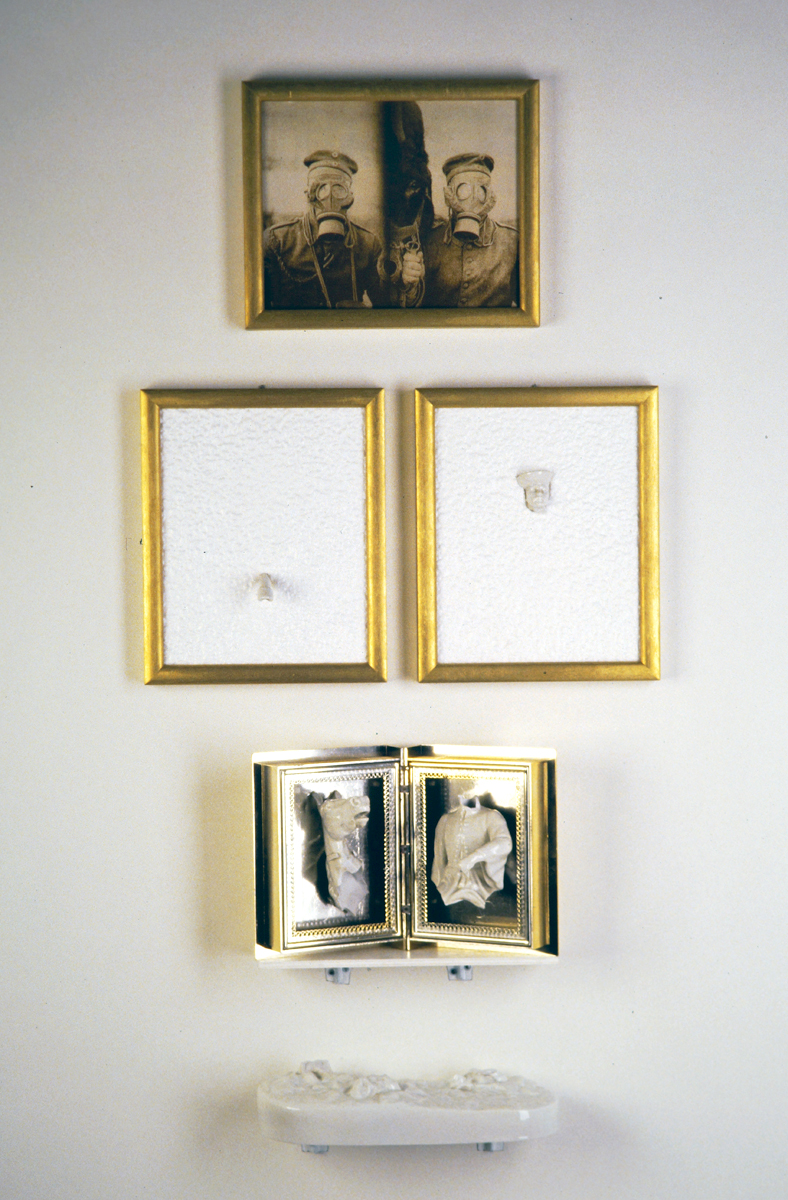
The three-headed chimaera at the very top. Below it, Styrofoam burned by glue. Like the iron of a lightbulb presses into the flesh. Two stubs in the burnt ditches, white on white. Two porcelain torsos in the gold box opened up as an altar. Relics. Freaks born of the war, hybrids of a degenerated existence. "Think about it, only man murders."
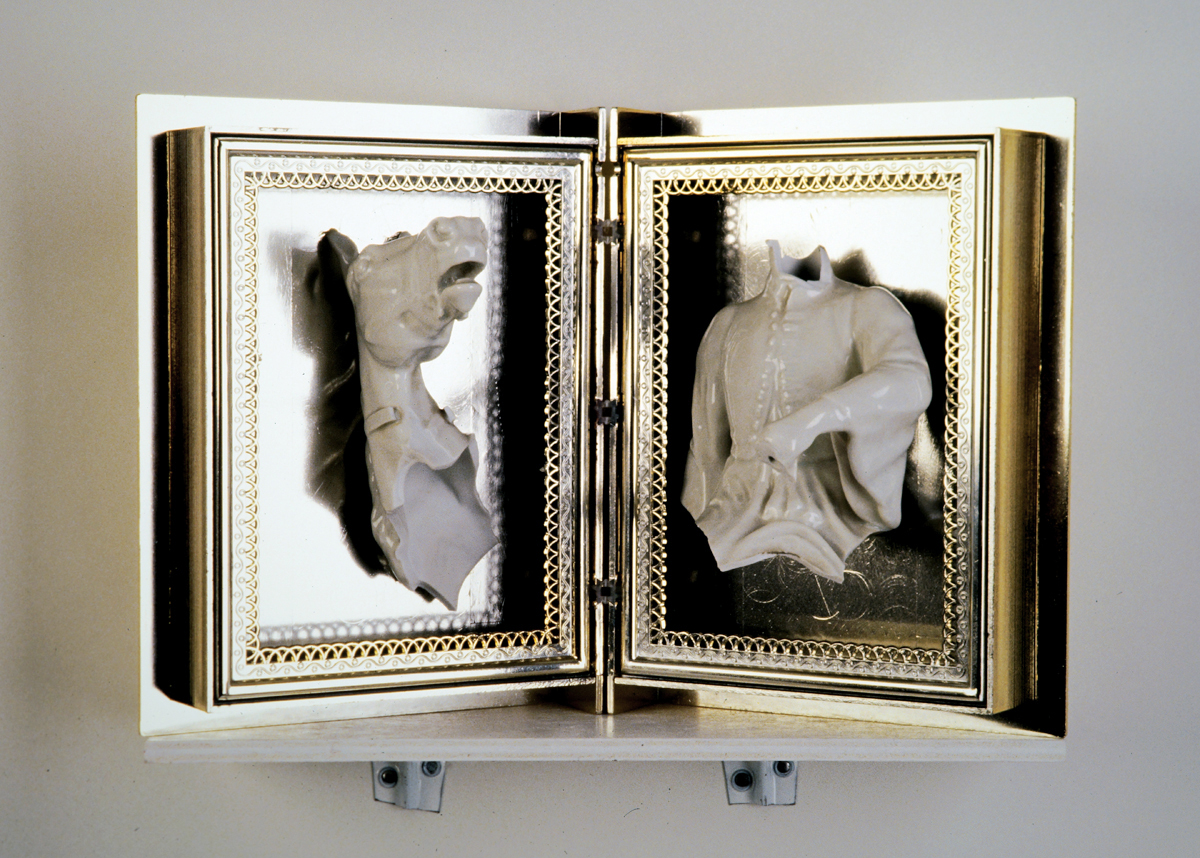
The battleground at the very bottom, figures broken off their pedestal. He collected nearly all the accessories from the local dollar store. "This is where I'm closest to reality," he said. "Kitsch cannot become art. This is why it's fake from the perspective of reality. You cannot make art out of Auschwitz. And if it is art, then it's not Auschwitz."
Untitled – (Residence Permit). B.N.'s statue ties together Heroic Memorial with the Boys triptych. A few months later, the Lord dressed in an S&M outfit will hand over this same doll to the handless Mary, who's looking up coquettishly. Here, there, and even at the object titled Nazarene: Disturbances of Conception, like in the case of Mis-se(e)d Ancestors that came before the Heroic Memorial. Terrycloth, tampon, mutilation. A fetus or an infant caught in a gesture of holding up its chin while sitting in a Duce-like pose on a throne arranged on a pedestal. A brocade covering its body, the grip of a kitchen knife placed between the carefully placed folds at the height of the genitals.
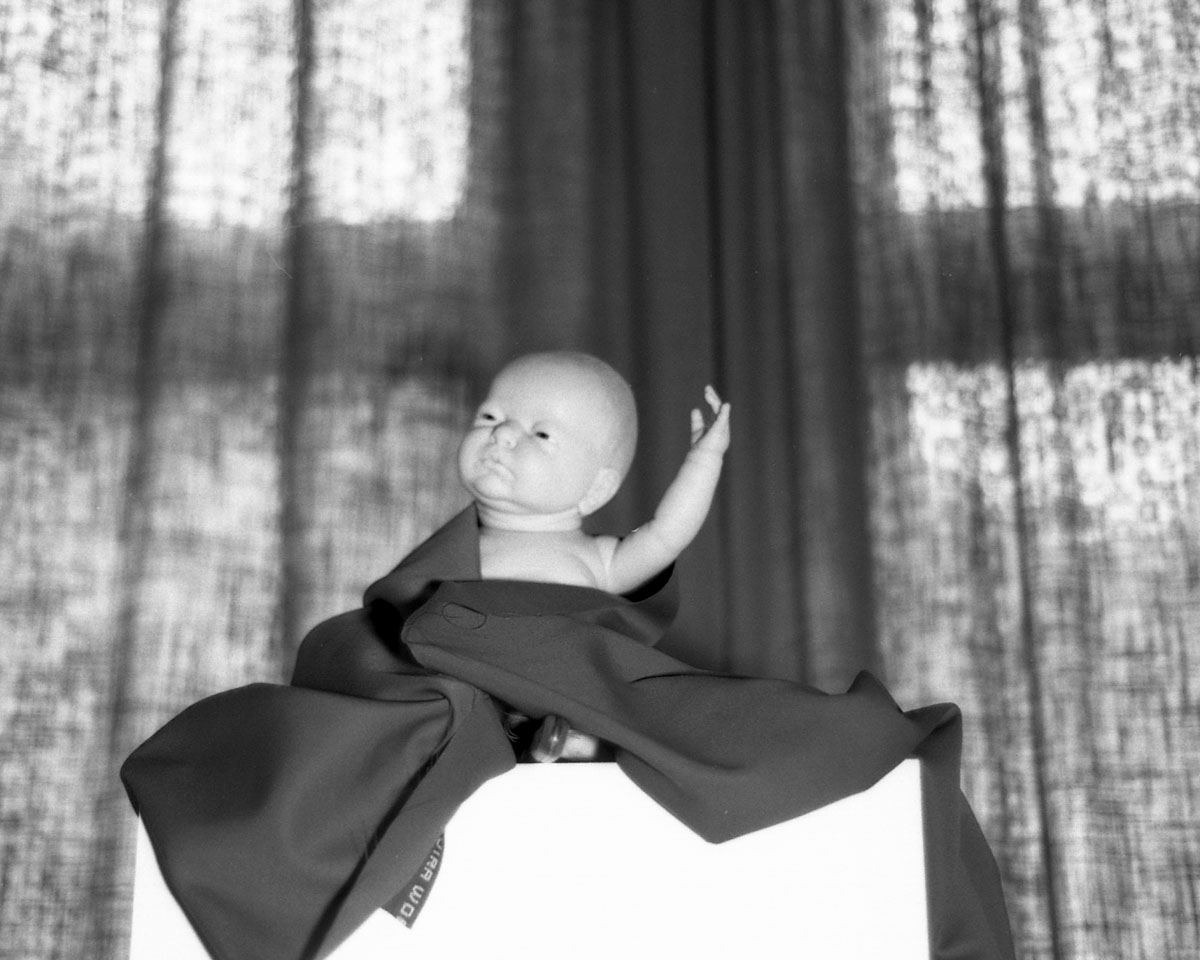
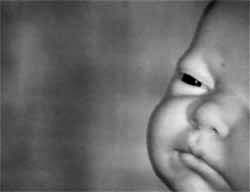
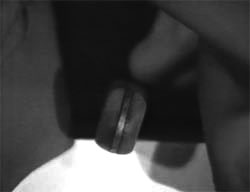
Infanticide? Murder of a fetus in the womb? Permitting residence until the blade goes in? With the light filtering in through the dark curtains, forming a cross in the background.
Boys.
The original caption of the third picture 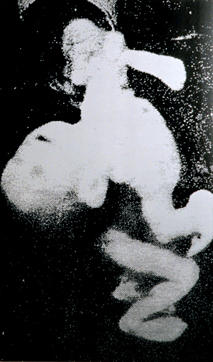 is an objective statement of fact: "Newborns don't have any chance of survival
either." In the original, long, near-Gothic shot, only one figure can be
seen in a dark, almost-blank background. One cannot determine with absolute
certainty whether this moment, this movement was preserved in a closed environment,
or outside. Because, owing to the fact that it's a picture, the photo is stone-still,
and so the figures can never be removed from the moment, from time, and yet
we still feel the momentum in it, the draught of air from the flying object,
the fall, the crash. There's nothing ominous or threatening in the details.
Rather, the face
is an objective statement of fact: "Newborns don't have any chance of survival
either." In the original, long, near-Gothic shot, only one figure can be
seen in a dark, almost-blank background. One cannot determine with absolute
certainty whether this moment, this movement was preserved in a closed environment,
or outside. Because, owing to the fact that it's a picture, the photo is stone-still,
and so the figures can never be removed from the moment, from time, and yet
we still feel the momentum in it, the draught of air from the flying object,
the fall, the crash. There's nothing ominous or threatening in the details.
Rather, the face 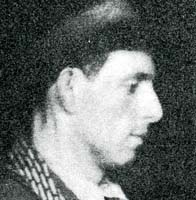 is indifferent, apathetic, perhaps a little melancholic. From his profile, his
face looks symmetrical, open, young, and handsome. The thick, knitted scarf
is indifferent, apathetic, perhaps a little melancholic. From his profile, his
face looks symmetrical, open, young, and handsome. The thick, knitted scarf
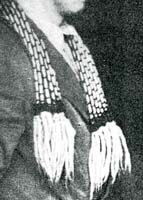 looks warm. The
pattern of it and based on how he wears it around his neck so loosely, we could
even call him sporty. There's even something playful to it, given the long knots.
In any case, it's weird, or at least he found it weird at first, that he has
such a nice scarf. The person himself doesn't look too bad or run-down, and
while his clothes look rather cheap, they don't look neglected. On second thoughts,
he found the scarf a bit much. His belt
looks warm. The
pattern of it and based on how he wears it around his neck so loosely, we could
even call him sporty. There's even something playful to it, given the long knots.
In any case, it's weird, or at least he found it weird at first, that he has
such a nice scarf. The person himself doesn't look too bad or run-down, and
while his clothes look rather cheap, they don't look neglected. On second thoughts,
he found the scarf a bit much. His belt 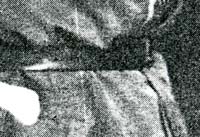 holds together a thick, short, coat-like thing. It may not be apparent from
the cut-out portion, but in the full image it's clear that the belt, that strap,
is a foreign accessory that's been put on him. This is truly the only accessory
that signals, in his environment, that his attire alludes to an emergency. His
boots
holds together a thick, short, coat-like thing. It may not be apparent from
the cut-out portion, but in the full image it's clear that the belt, that strap,
is a foreign accessory that's been put on him. This is truly the only accessory
that signals, in his environment, that his attire alludes to an emergency. His
boots 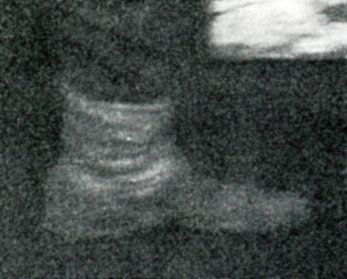 are more
of an extreme case. The quality of the printed photograph doesn't make it possible
for us to reach far-fetched conclusions, and yet the shoes convey an odd effect—probably
because of the short, sock-like, kind of wrinkled shaft, and it looks gratuitously
light. The contours of the hand and the upper arm
are more
of an extreme case. The quality of the printed photograph doesn't make it possible
for us to reach far-fetched conclusions, and yet the shoes convey an odd effect—probably
because of the short, sock-like, kind of wrinkled shaft, and it looks gratuitously
light. The contours of the hand and the upper arm 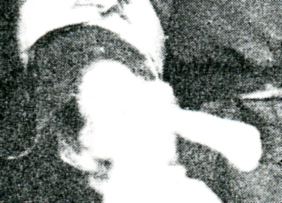 cannot be seen, but if we scrutinize the image from close up, we can clearly
see that the fingers are fully clasped around the upper arm, and even the elbow
disappears inside the man's hand, so that only the lower arm stands out, like
a thin, bare bone. The armband
cannot be seen, but if we scrutinize the image from close up, we can clearly
see that the fingers are fully clasped around the upper arm, and even the elbow
disappears inside the man's hand, so that only the lower arm stands out, like
a thin, bare bone. The armband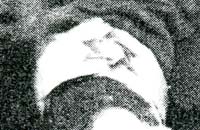 can be seen just above the hand. The armband, or the symbol on it, that is,
of course makes the image instantly didactic, yanking it in only one possible
direction. At first, he thought about editing it out. He didn't dare do it.
It was clear what was coming next.
can be seen just above the hand. The armband, or the symbol on it, that is,
of course makes the image instantly didactic, yanking it in only one possible
direction. At first, he thought about editing it out. He didn't dare do it.
It was clear what was coming next.  "No?" he asked. "Of course," he answered absently, and continued
automatically taking apart, disassembling the images. The two standing, silver-toned
photos, which were mounted on a thick, wooden sign, were held together by a
horizontal picture. Here, on the torso's abdomen, zipper-like vertebrae sutures
are the most noticeable detail
"No?" he asked. "Of course," he answered absently, and continued
automatically taking apart, disassembling the images. The two standing, silver-toned
photos, which were mounted on a thick, wooden sign, were held together by a
horizontal picture. Here, on the torso's abdomen, zipper-like vertebrae sutures
are the most noticeable detail 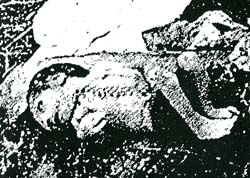 .
This is not the only thing that alerts us to the reality of the person's physical
state, however, but also the unnatural posture. It could even be the body that
was being discarded in the last picture, now among rags and trash. This motif
appears later, too, sheathed in yellow foil in one of the magical, golden boxes.
We have already seen the second picture: its face on the poster, set in the
I Love Status Quo series. The cannibal family's torso placed on the table,
the half-eaten child. Yorick laid its face
.
This is not the only thing that alerts us to the reality of the person's physical
state, however, but also the unnatural posture. It could even be the body that
was being discarded in the last picture, now among rags and trash. This motif
appears later, too, sheathed in yellow foil in one of the magical, golden boxes.
We have already seen the second picture: its face on the poster, set in the
I Love Status Quo series. The cannibal family's torso placed on the table,
the half-eaten child. Yorick laid its face 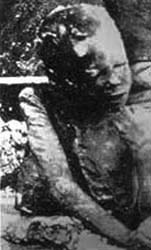 on his own face. The torso's posture was the first most apparent detail. The
head turned to the side, the arm laid across itself in a diagonal—perhaps the
photographer arranged the body like this, so that it would not fall over—the
other arm in the air, bent or broken, at the elbow. With the half-open
mouth and the leaning arm, this could even be a passionate, declamatory gesture,
as if it wanted to explain, signal, or show something, to squeeze through the
remaining part of the body, the nonexistent explanation of fate.
on his own face. The torso's posture was the first most apparent detail. The
head turned to the side, the arm laid across itself in a diagonal—perhaps the
photographer arranged the body like this, so that it would not fall over—the
other arm in the air, bent or broken, at the elbow. With the half-open
mouth and the leaning arm, this could even be a passionate, declamatory gesture,
as if it wanted to explain, signal, or show something, to squeeze through the
remaining part of the body, the nonexistent explanation of fate.
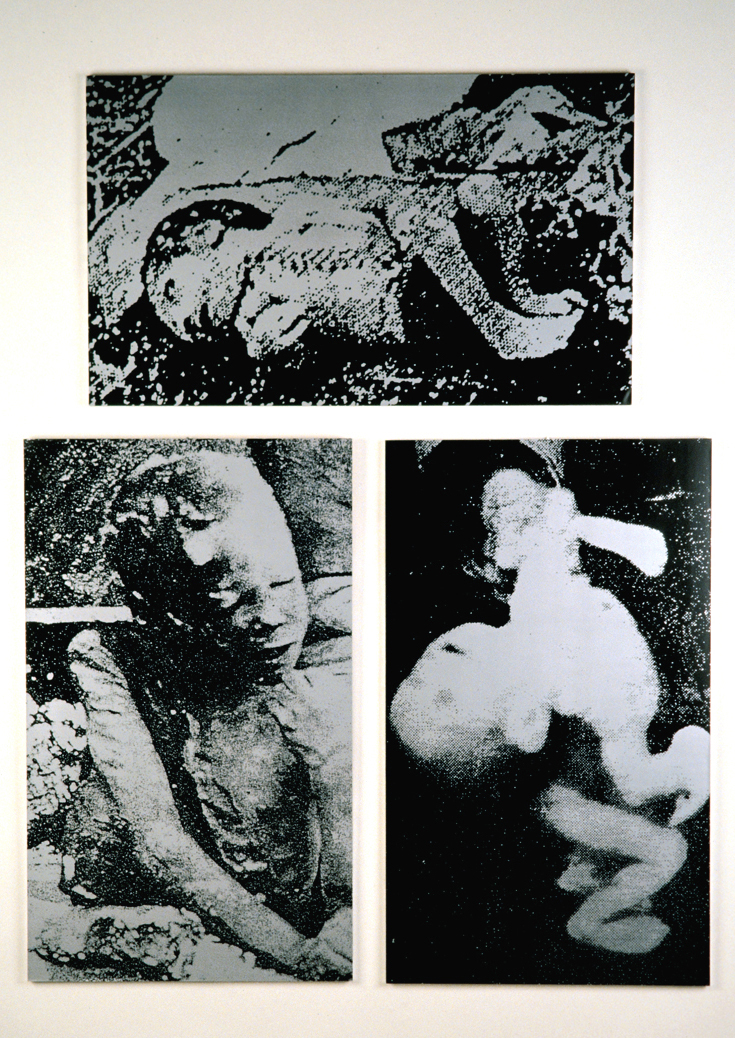
He realized during the making of the film about the exhibition that the next, natural installation environment is the window next to the Boys triptych. There is no contemporary documentation of this. However, this is where the picture of the easel painting called Kristallnacht December 31st, 1989 above the Roonstrasse was taken. (Mary was not familiar with the phrase Kristallnacht. "As if it were only an Andersen folktale," she said, enraptured.)
Dead Christening. Promise tied him to this installation only. They could hardly imagine that the original plans could be made a reality. On the contrary, consistently having to repay their debts determined both of their daily lives. He did not know every detail of Josef's life story, yet he knew his own, and this was enough to know Josef's motivations. Plans for the Big Columbarium came to fruition at the same time as for the exhibition, but because they only had the opportunity to make just a "sample" from the very first moment, the plans for the entire installation were forgotten. He only found fragments of the entire plan years later, in the Riehl estate, and he could not make exact sense of them on his own. He shuffled the drafts around, in front of himself, for days; he tried to reconstruct the meaning of the impossible calculations. Finally, he gave in and only put up on the website those assumptions and suspicions he found the least phony. "I will make a sample," said Josef with the objectivity of a tailor, "and you can continue the rest later." Looking back, it would have been absurd for Josef to have become the architect of the mausoleum, but he found the idea of someone bringing to fruition his formally pantheistic plan just as absurd. The Big Columbarium, or the Dead Christening, owes its validity to the fact that it's not closed, that it cannot be closed, and that it's perpetual. It cannot be closed in the way that mass graves cannot be closed. The original picture

lay before us for days. One morning, he marked about a two-centimeter-long segment on the picture, then a second one, then a third, and started bringing them up from the deep.
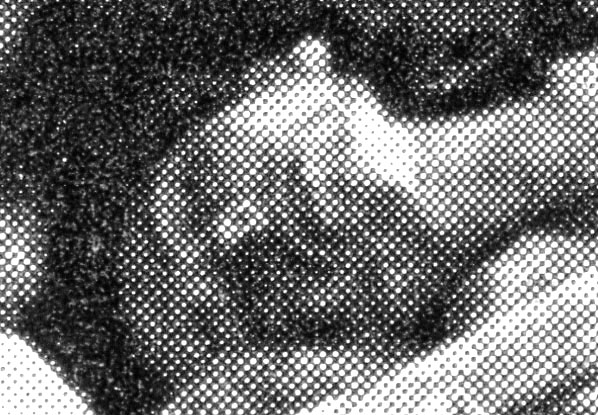
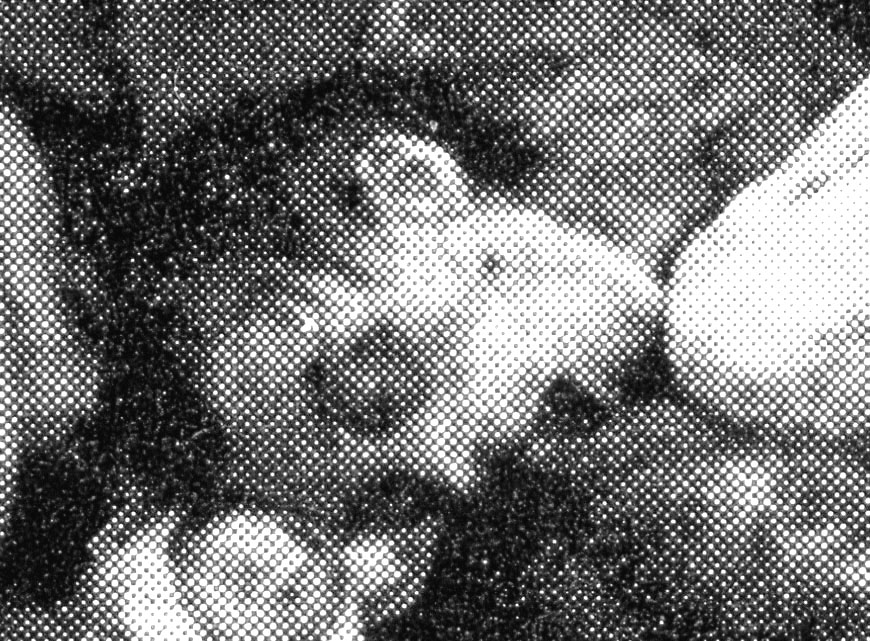
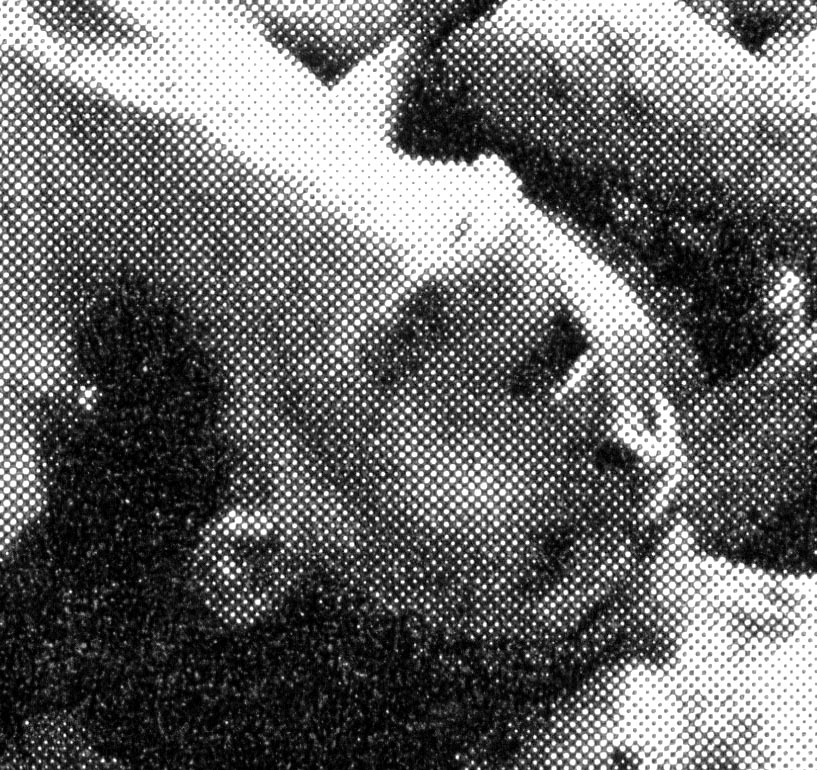
He said he would find twenty-four faces. To this, he said, that's not enough. He couldn't leave the rest of them down there. "Fine", he said, then he would find two-hundred and forty. "And what about the rest?" he asked. Josef looked at him and hissed: "Will two million and four-hundred thousand be enough?" "Ridiculous", the other spat back. "And two billion?", he yelled. "Twenty? Two hundred? Still not enough?" "No", he said. That's why he couldn't finish it. Not Josef, not him, not anyone else.
Years later in Riehl, he found an old, ragged, out of style, cardboard folder. Five different-sized, worn pieces of paper held together by rusty paperclips. The one at the top of the pile was clearly about that same morning: he could not determine who wrote it, based on the big, smeared, foreign-looking handwriting. "Four, left to right. Don't ask where they're from. Look at them. Try to imagine their lives, their stories. That's the only way and time they live. I can say that they don't stand in a nice place and only for a few minutes longer. We were looking for faces for an installation. I zoomed in on them and put them before J. 'That's all?' He asked in shock. 'That's all', I said. 'That's not enough', he said.' You can't leave the other ones down there.' 'How many do you want?' I snapped. 'A hundred?' 'And the rest?' he asked. 'Fine', I said.'Then I'll bring another thousand. A hundred thousand. Or a million. That should be enough!' 'Barely', he said. I slammed the pictures on the table irritably and left J there. Back then I didn't know I couldn't finish it because of them. In that picture with the four of them, there's a fifth one. The fifth is hiding between the waist and hip of the one on the far left. The elbow is oddly turned in, as if the shoulder were popped out of place. Head lowered, the remainder of the face blurs amidst the pixels…"
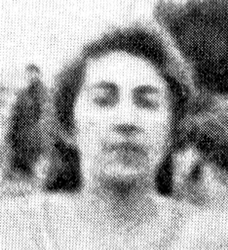
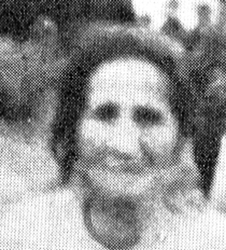
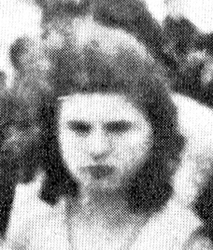
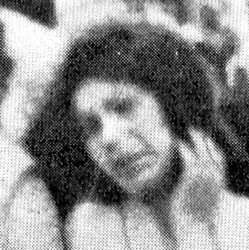
On the rest of the pages were the drafts for the Big Columbarium. The first must have been plans for the arrangement of the whole space.
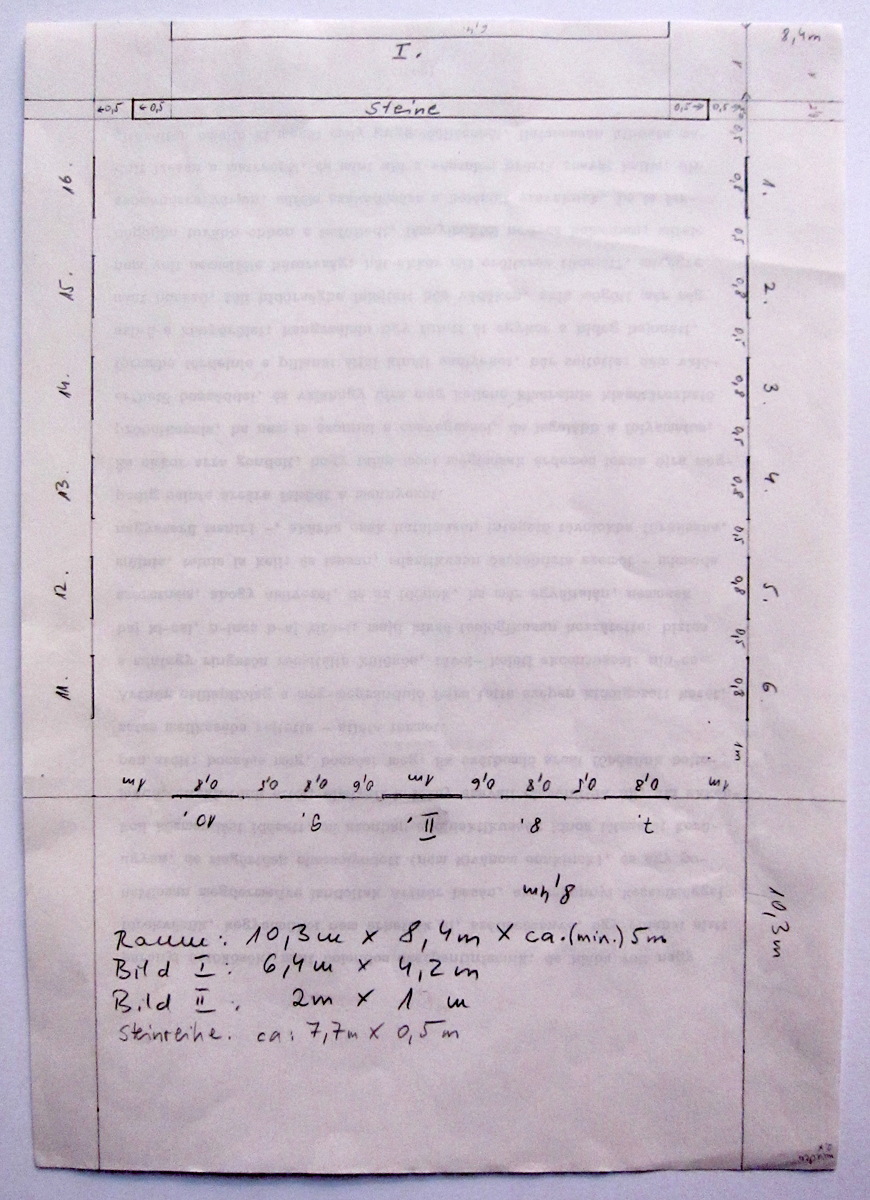
Josef had imagined an underground hall, without any structure above it, with a ramp that feels as if you've gotten down into a mass grave. The hall completely closed, with the exception of the narrow entrance. The Big Picture, 6.4 x 4.2 meters, on the spandrel wall. The "roster draft" probably relates to the structure of this. (I added the Hungarian-language addendum to it, based on the new records that have since been found.)
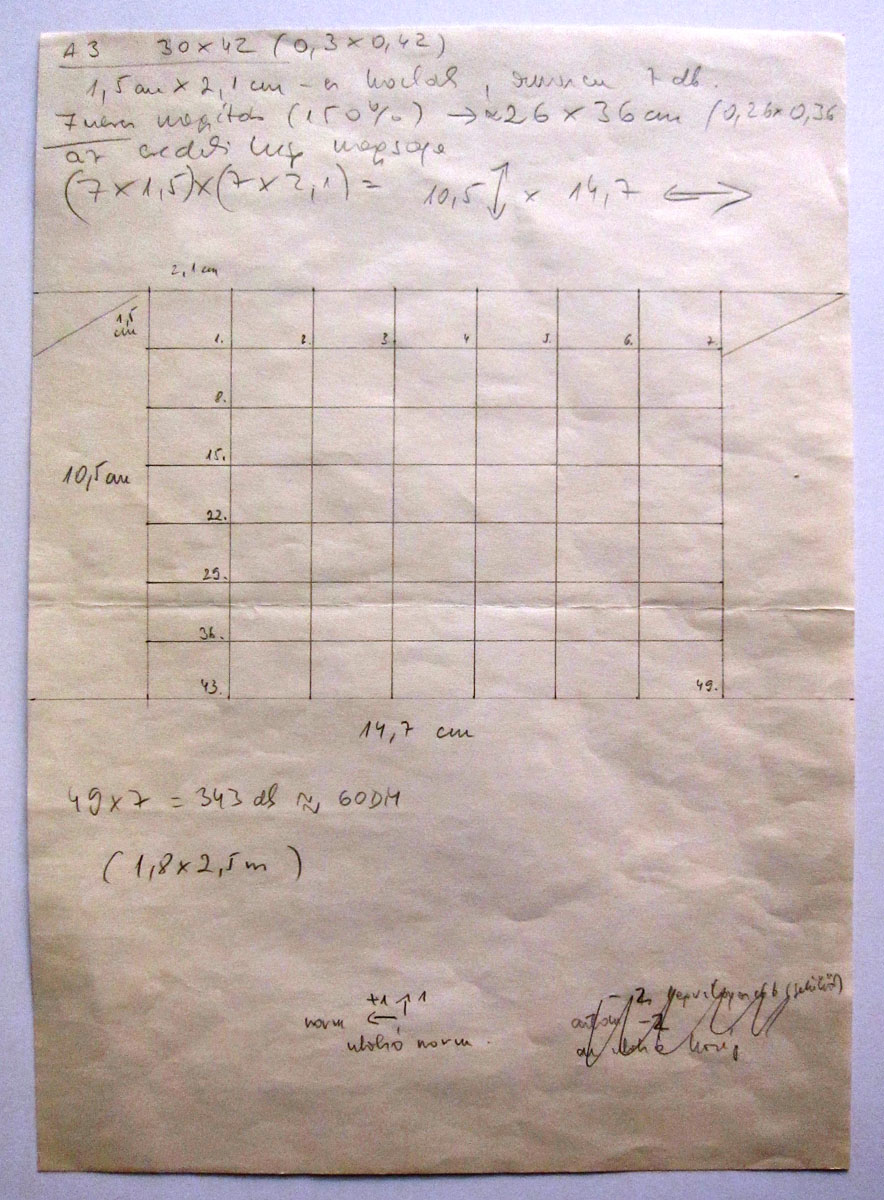
He could not make sense of the draft anymore. Perhaps it was the allocation plan of the original source picture. In the white envelope stapled to the back of the paper, he found 49, approx. 2.1 x 1.5 cm large picture segments. He glued the tiny squares, one by one, to little numbered pages that were barely bigger. The draft grid may have referred to the arrangement of these images. He wasn't able to figure out the calculations in the notes either. One of the series of numbers, for instance, went like this: 3.79 - 5.629 - 8.437 - 12.652 - 18.98 - 28.476 - 42.71. He finally arrived at the conclusion that the numbers may refer to the sequence of enlargement for individual pieces of the segment and the increasing sizes of the images. Perhaps the size of the Big Picture may also be traced from this. Based on the drafts, he was planning a meter-and-a-half high, 7.7-meter-wide "dam", stilted from pieces of rubble. Across from the Big Picture, on the opposite wall of the hall, would have stood Bild II (Picture II). The size of it is 2 x 1 meters. The notes did not specify what it represented. "Right now, I think" he wrote years later, "that this was actually the main wall, and that Bild II was nothing more than the original, the source picture that ‘projected' the pointillist Big Picture onto the opposite wall. The tables of the Dead Christening, with so-called mass grave kits would have lined up lengthwise along the wall across from the Big Picture." The third draft obviously refers to the arrangement of the Dead Christening's objects:
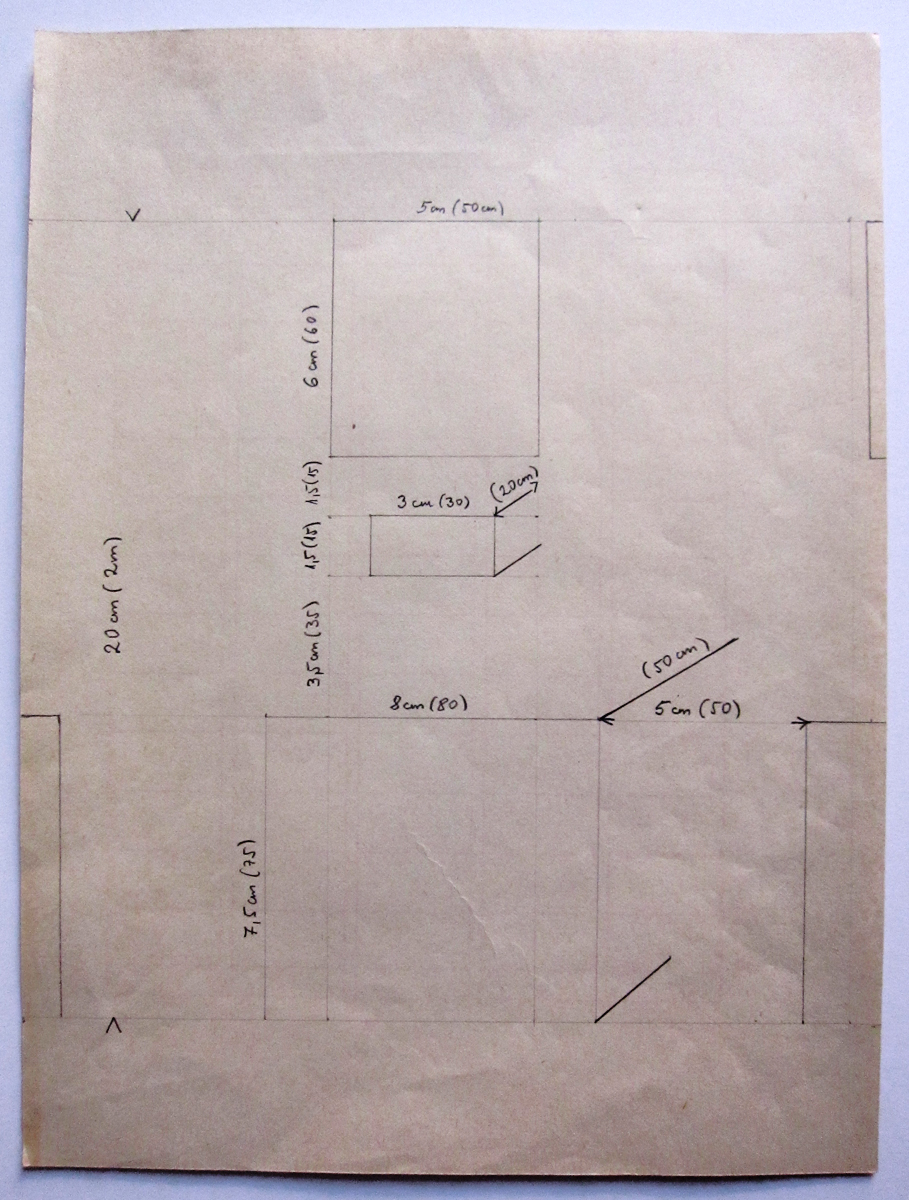
In the black, cardboard-topped notebook used during the reconstruction, he wrote: "Meanwhile, I scanned six of the 49 picture segments. This way, I might remember what J had planned on doing with them.
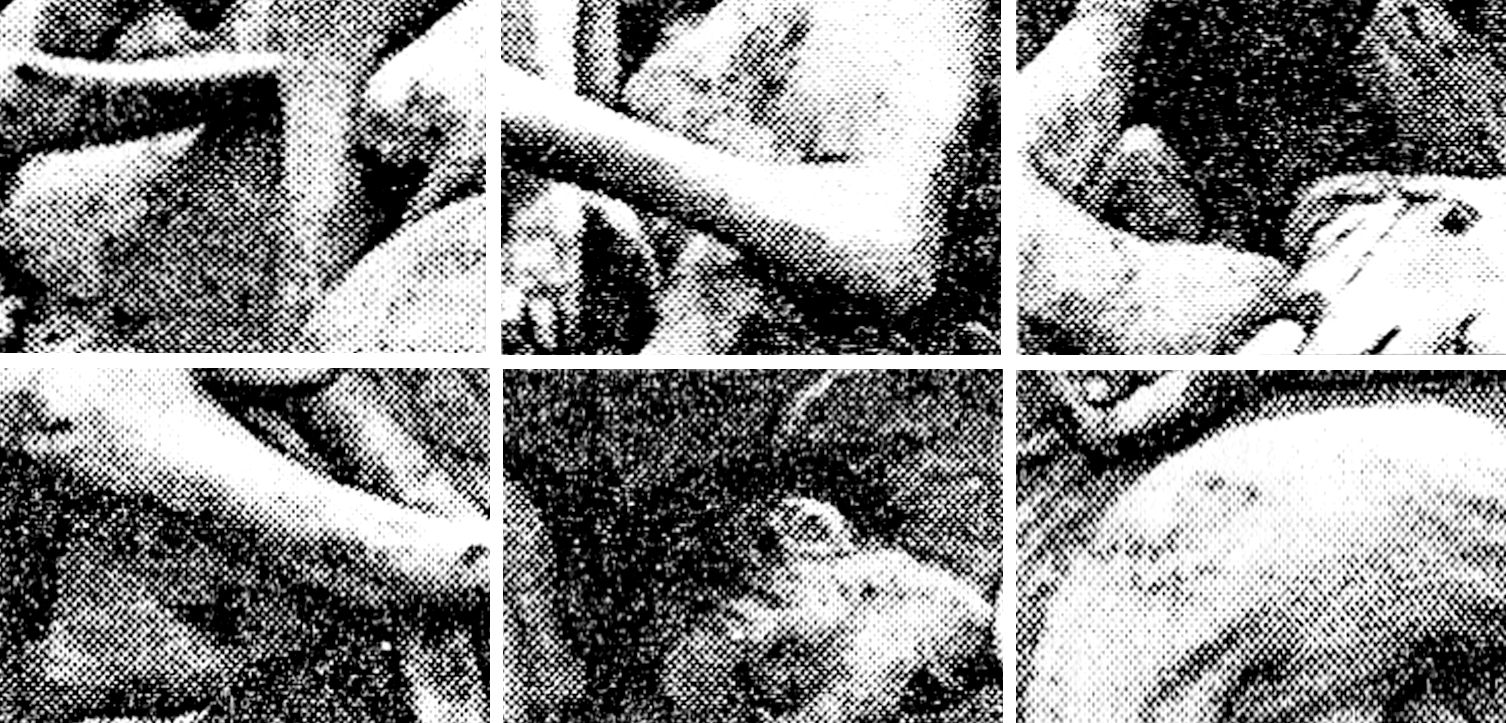
The only thing I can imagine is that these would have been the components of the Big Picture. Although, I can't find the relationship between the planned size of the Big Picture and the calculations for the pointillist grid. Perhaps I should scan all the segments in the order proposed. This kind of visualization might solve the problem. The plans for the Big Columbarium obviously have to be processed separately." He didn't get around to that, in the end, as he didn't even scan the other segments. So, we have to consider the existing drafts of the Big Columbarium as the final plan. This outcome may not have satisfied him, while Josef wouldn't have had any qualms about it.
The supposition
may be rightfully questioned, that perhaps he didn't really try to make a truly
complete, final draft, either. The following notebook entry refers
to this: "I look at the pictures over and over again so often that it's
practically constant; I'm even looking at them when I'm not. The four faces,
and of course the fifth one, the one that's hiding 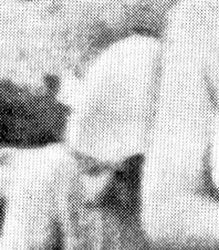 .
I want to continue them, their lives, by not giving up on them.
As long as I look at them, they are alive. While I write about them, they are
alive."
.
I want to continue them, their lives, by not giving up on them.
As long as I look at them, they are alive. While I write about them, they are
alive."
So, he considered the Dead Christening's ensemble to be the Big Columbarium's "sample". Based on the first draft of the Big Columbarium, one finds that he imagined placing 16 similar tables that can probably be traced to 16 locations. The boxes
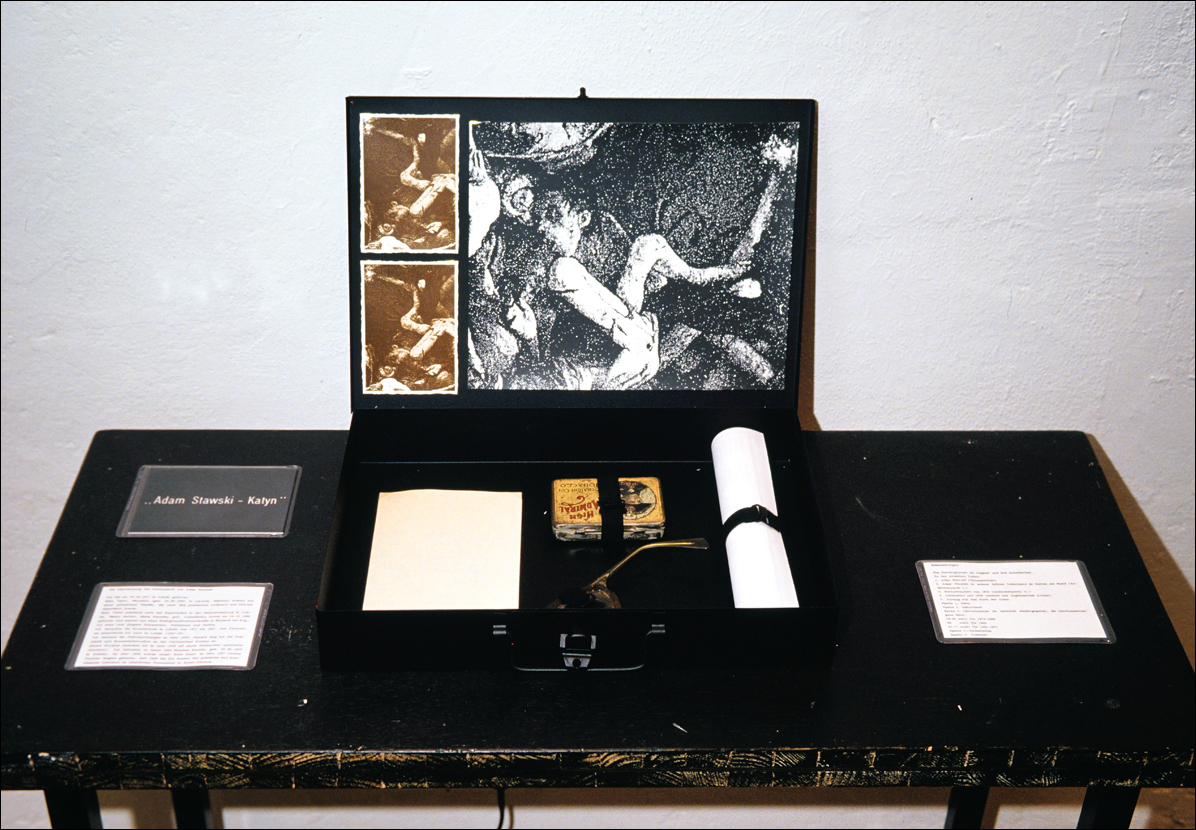
for the "mass grave kits" placed on the tables were made up of five parts. The so-called Portrait
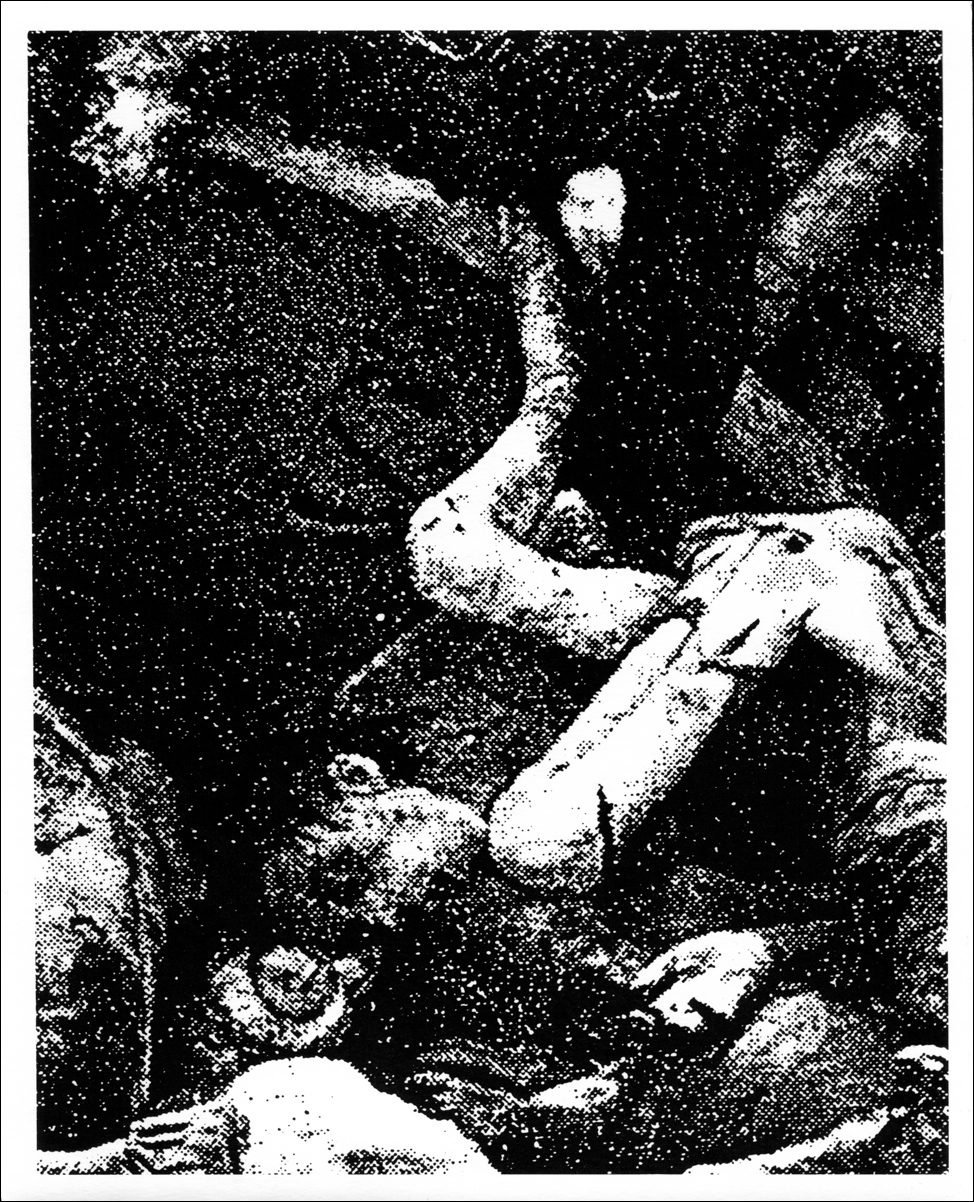
was a reproduction
of one of the source image's enlarged portions. This same motif appeared again
in a bigger version, on the wall above the desk. The 24 x 30 cm portrait was
affixed to the inside of the box's lid, which was open and leaned against the
wall. Beside it, toned brown, two 8 x 10 cm "commemorative photos".
The first: "Adam Stawski at three-years-old in the garden with a dog":
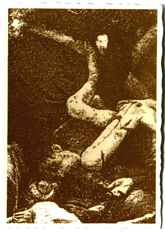 The second: "Wedding
photo from 1934":
The second: "Wedding
photo from 1934": 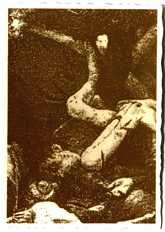 The folded-up, handwritten, original ("original") biography
The folded-up, handwritten, original ("original") biography 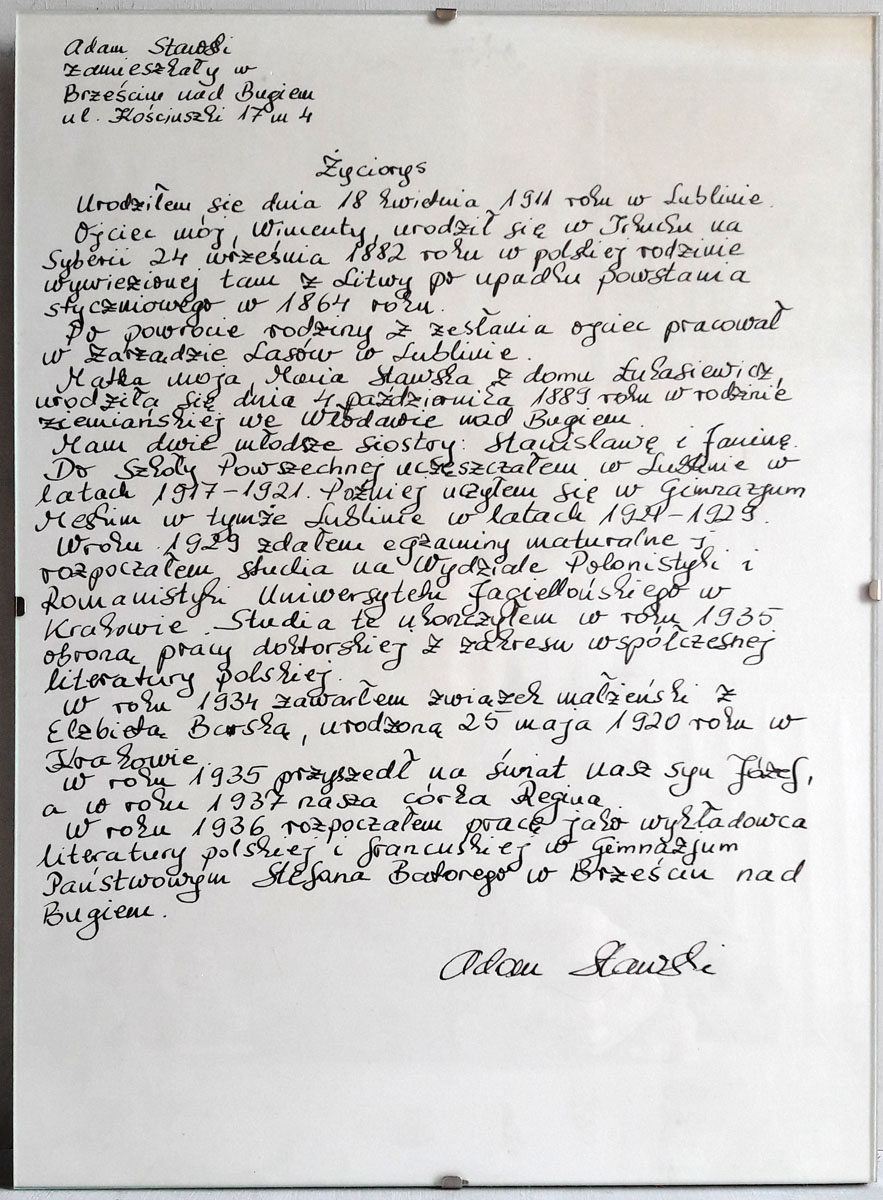 was placed inside on the left side of the box. Wrapped up beside it was a page
from the Book of the Dead
was placed inside on the left side of the box. Wrapped up beside it was a page
from the Book of the Dead 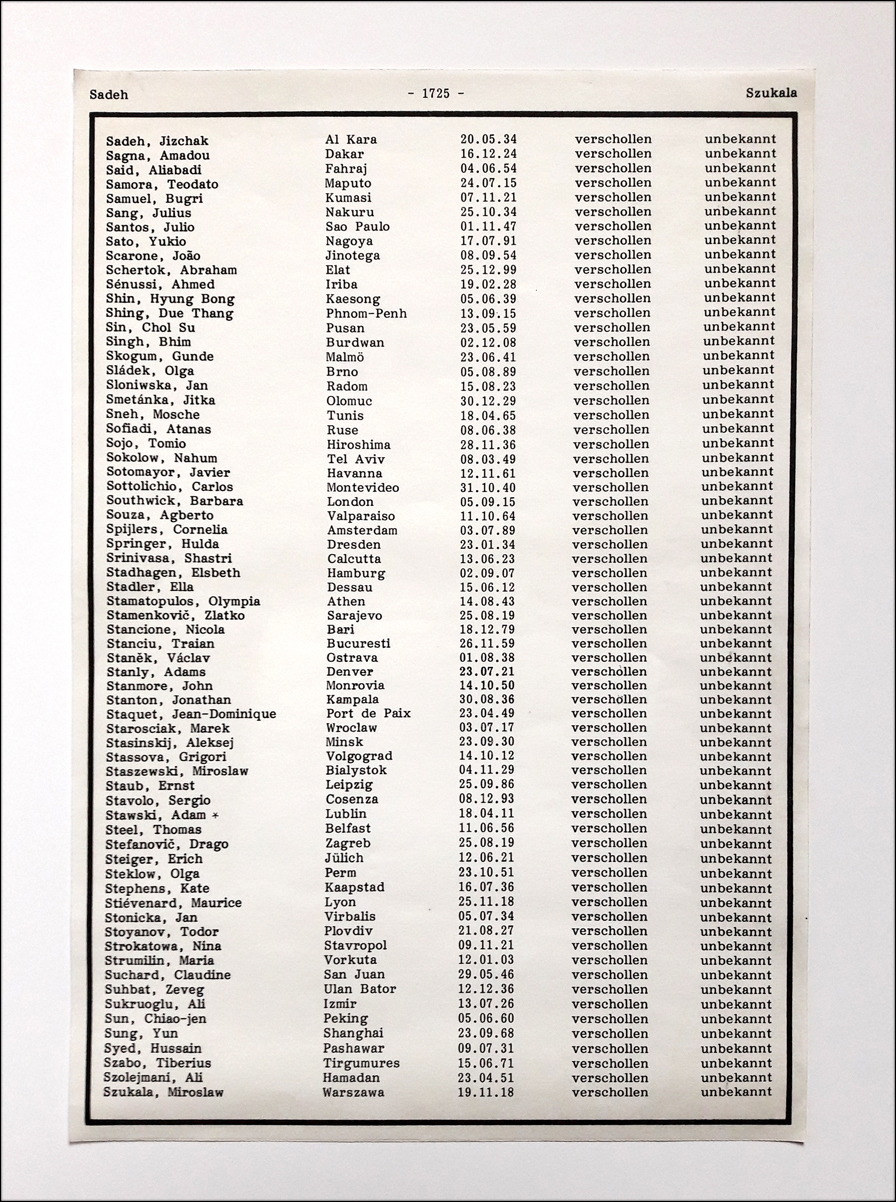 .
The roll was held together by a rubber band that closed with a clasp. Two relics
beside it. A metal box for cut tobacco and half a pair of broken glasses with
the temples missing
.
The roll was held together by a rubber band that closed with a clasp. Two relics
beside it. A metal box for cut tobacco and half a pair of broken glasses with
the temples missing 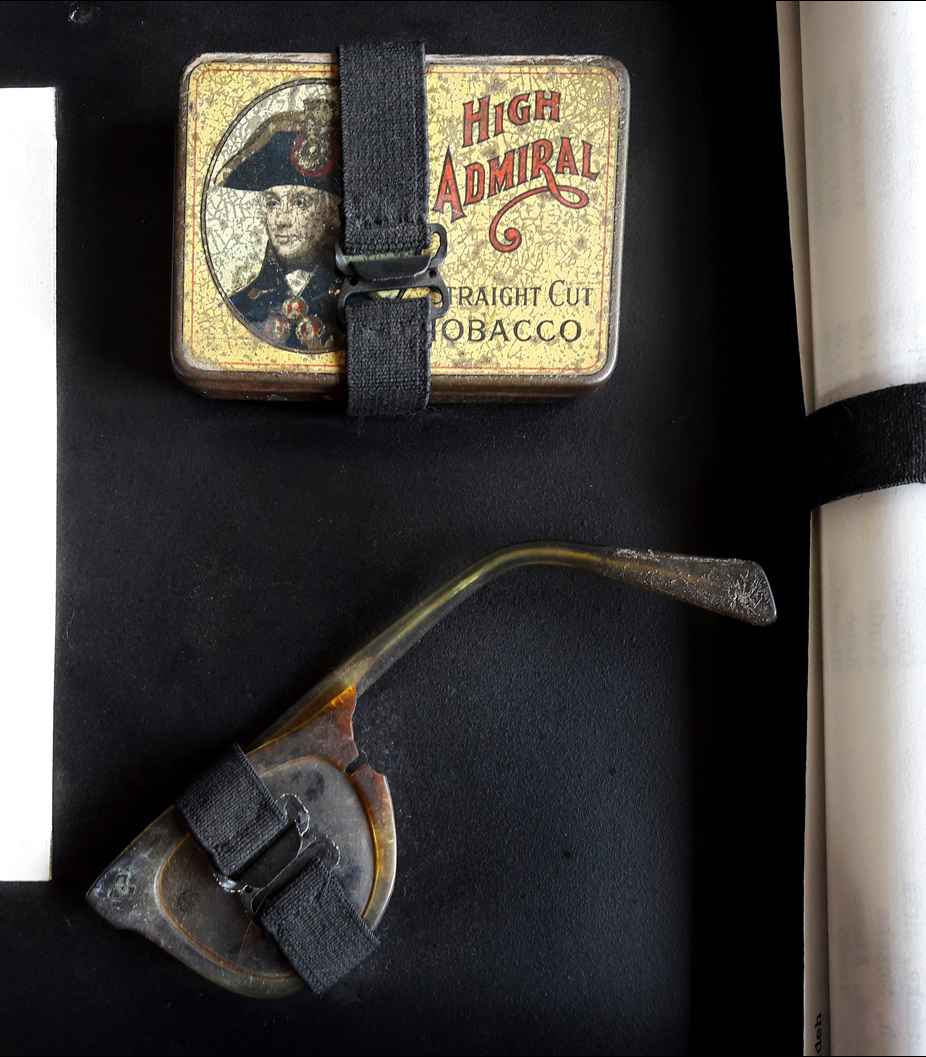 .
Next to the box, on the table, lay a black plaque, the deceased's "baptismal
papers" with the deceased's name and location of their mass grave
.
Next to the box, on the table, lay a black plaque, the deceased's "baptismal
papers" with the deceased's name and location of their mass grave 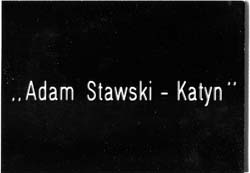 .
The German descriptions of the Dead Christening's objects
.
The German descriptions of the Dead Christening's objects 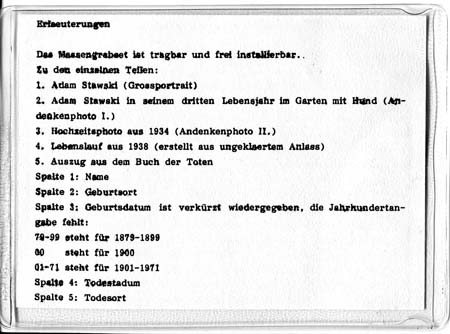 and the biography's German translation
and the biography's German translation 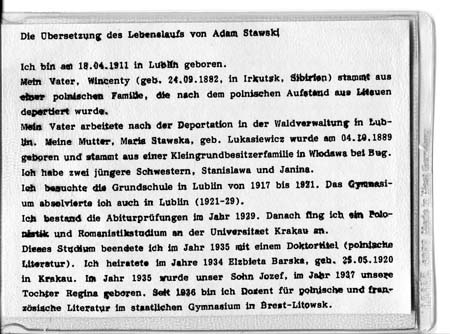 were
inside the plastic packets that were the size of the picture. Josef had bought
the box at one of the Bauhaus stores in Cologne
were
inside the plastic packets that were the size of the picture. Josef had bought
the box at one of the Bauhaus stores in Cologne 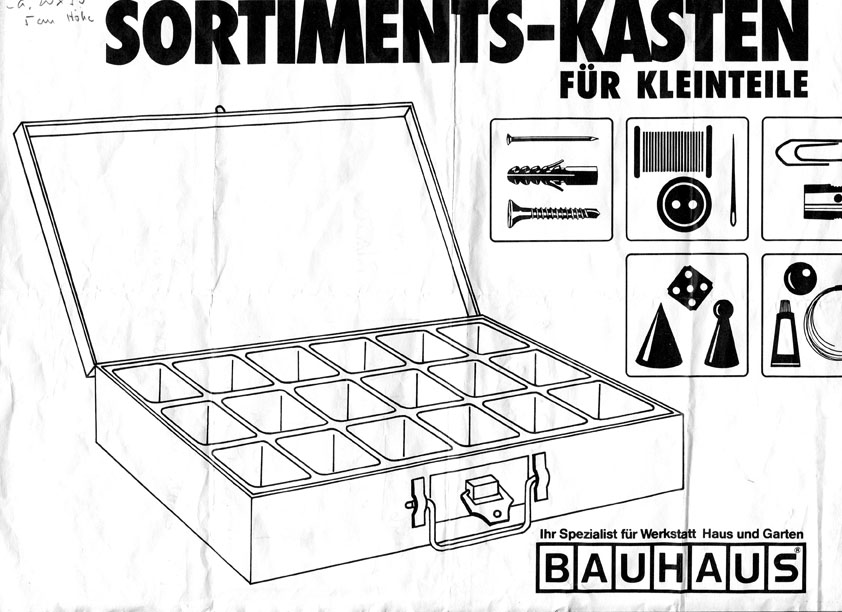 .
"The place's soul fits perfectly with the subject. Auschwitz was also created
at Bauhaus," he said. "You can't write that," he told him. "Then
don't write it," responded Josef.
.
"The place's soul fits perfectly with the subject. Auschwitz was also created
at Bauhaus," he said. "You can't write that," he told him. "Then
don't write it," responded Josef.
He ended the first black notebook with the following words: "At the time the exhibition was built, but even at the time of the lonely, two-week-long room guarding, I did not feel that the material was this homogenous. As the place starts with the burning animal victims thrown onto the bonfire, continues with the furnace grounded in material reality, with the waiting women in the fire pit, the scaly claws digging into the dias placed onto the furnace's opening, with the everyday angel-making, the cannibalism, its gas-mask-wearing mule gaze; the triumphant infant sitting on a knifeblade with a blind, glazing gaze; the dead child hanging from an unmoving swinging hand; and to finally arrive in Bergen-Belsen's apocalyptic open, filthy stomach, so that from here it can move onto the "half-space" that closes the cabinet, on the floor of the Silenced War. Cannibalism, pornography, bestiality. The title that should have been given to the exhibition is The 20th Century."
Culture
Ornamentation II. / The Silenced War. They happened to be together when
he came across the main figure of the triumphal arch's right-side relief on
page 19 of the book. He only saw the surprise on his face, he truly grew grey
from the sight. He didn't say anything, didn't even look up, just sat motionless.
It wasn't paralyzation, but rather perplexity that lay in his stillness. He
didn't understand his behavior; he stood up and stepped behind him without a
word. A fossilized gaze, distorted face, choking from his own bloodlust. He
looked at the silently screaming, mutant monster in shock. He was not familiar
with the picture, nor with the figure in the picture, though he had walked by
it and under it countless times. It's worthwhile, though, to inspect the image
calmly, a little bit at a time. The chronic, vile grimace 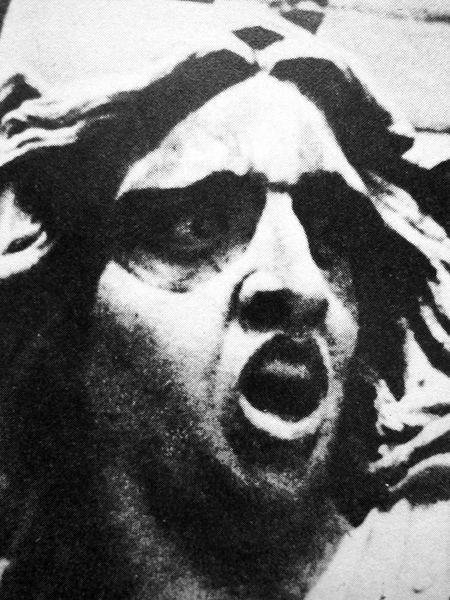 ,
the skull frozen mid-scream, the figure's surroundings. The chimaera perching
on the helmet with its tongue spitting out, its screeching
,
the skull frozen mid-scream, the figure's surroundings. The chimaera perching
on the helmet with its tongue spitting out, its screeching 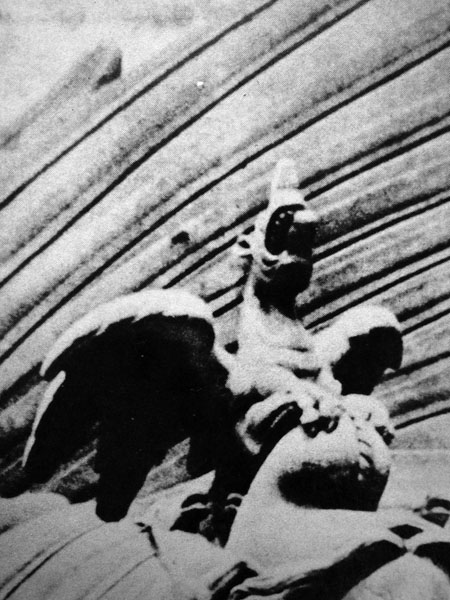 ;
the stiff arm thrown high into the air
;
the stiff arm thrown high into the air 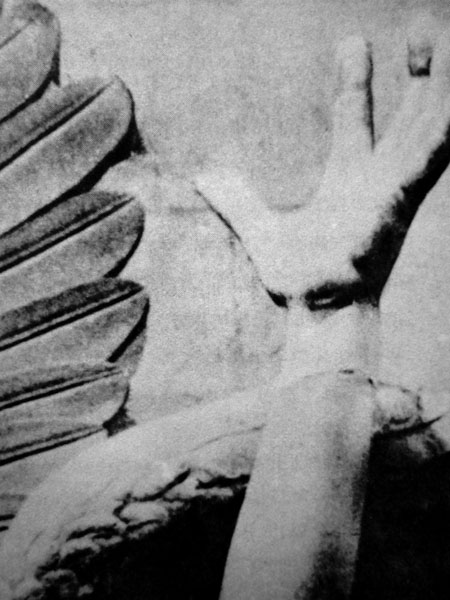 ;
the scaly upper body; the suffocatingly busy background.
;
the scaly upper body; the suffocatingly busy background.
- 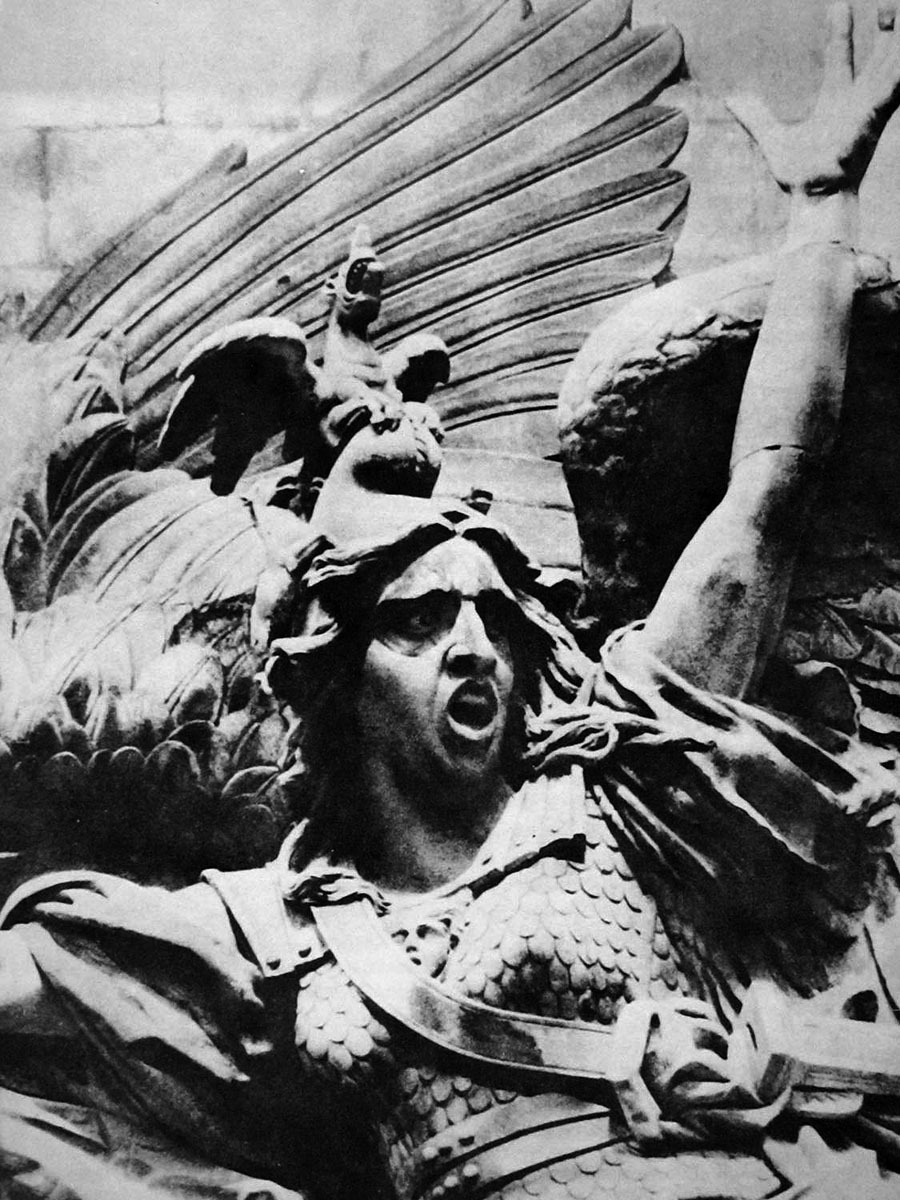
Josef went down to the Bauhaus the next day, bought the longest and thickest carpenter nail he could find, and nailed up the screaming monster's gaping mouth through the throat of one of the motorized, sucking dolls placed there for the Culture Ornamentation installation. For a moment, he definitively silenced her.
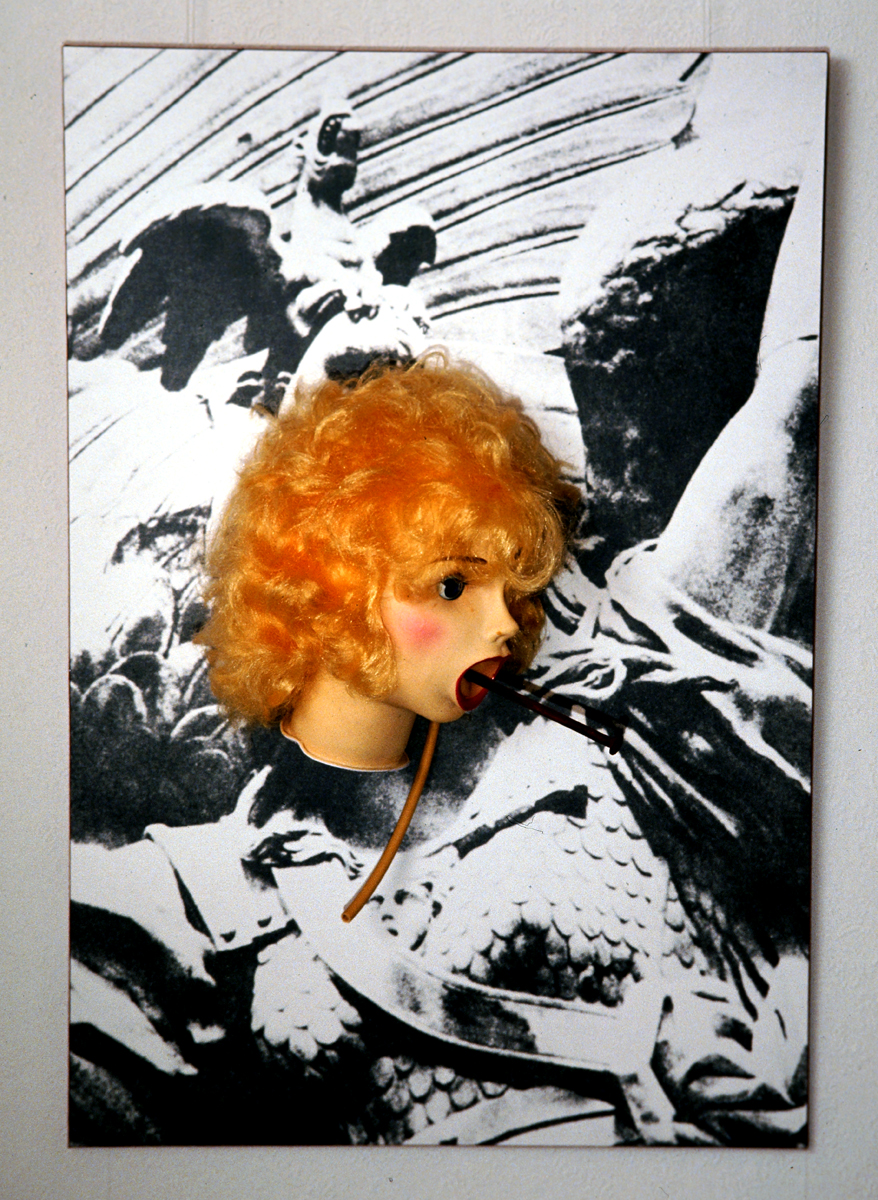
Twenty-four
years later, wandering around a second-hand bookshop, he found a book on the
League of German Girls. When he saw this photo on one of the pages, the other zombie came to mind immediately, and only when
he took a picture of the image with his phone did he see on the screen that
this one doesn't have eyes either, like a stone cannibal herself. Culture
Ornamentation II. closes off the Silenced War picture.
on one of the pages, the other zombie came to mind immediately, and only when
he took a picture of the image with his phone did he see on the screen that
this one doesn't have eyes either, like a stone cannibal herself. Culture
Ornamentation II. closes off the Silenced War picture.
The doll heads worked with batteries and were "hand operated". From the perspective of the installation, the little motors that work the mouth vibrators are important, in that when visitors came, he would turn them on. An inconsistently strong, buzzing chorus rose from the four open mouths. The rubber hand pumps could pump up the inside of the mouths; if someone tried this as well, the two sides of the face would shrink and expand to the rhythm of the pumping. They ordered the dolls from the Ehrenstrasse sex shop. When Josef explained his plans to the art-friendly owner, it turned out that they did not have such dolls at the store, but could order them to arrive from England in a matter of a few days. After the owner found out what roles the dolls would be playing, he agreed to pay the overhead costs.
The installation
stood in the so-called "half-space" that opened up from the first
room. This space was actually just one big room, the first third of which was
separated by about a two-meter-high wall. This is where they hung the dolls
and the Silenced War picture. Above the wooden space-divider, one would
find the portrait series B.N. had made of the dead. He never asked B.N. who
the photos represented. He recognized, however, the middle portrait on the spandrel
wall 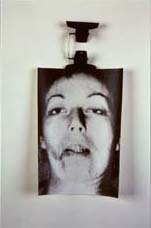 .
.
B.N.'s photo-series was in the upper space that opened up behind the divider-wall, yet visually, it blended together with the "first" space. You could step over a narrow opening without a door, into the apartment's last space behind the wall. This is where issues of Edition Nekrophil stood on shelves, as well as those objects and installations that could not fit into the "one and a half" sized room near the entrance: The so-called Magical Boxes and The German (Economic) Miracle Memorial.
Josef had actually decided when they started building the exhibition that he would place the golden boxes and the The German (Economic) Miracle Memorial behind the wall of Culture Ornamentation II in the "one and a half" sized room. He found the Wirtschaftswunder (German economic miracle) memorial to be "too documentarist" compared to the other installations, too much of a "local interest". And he looked at the golden boxes as functional objects, since they had to be operated. He thought - although he really didn't like this kind of speculation - that the visitors' preoccupation with the boxes would intervene with their contemplating other parts of the exhibition. Almost immediately after the end of the exhibition, the boxes actually disappeared without a trace. This didn't really bother anyone. Back then, it was entirely normal for literal underground exhibitions to spring up for hours, days, sometimes weeks, often in basements, and afterwards the objects would simply be lost, vanish, scatter, break, or just become part of another exhibition. When once an intern at the local tabloid asked Josef if he didn't mind destroying what he had built—since he'd demolished one of his works in a construction container immediately after the exhibition, as there was no space to store it—he said, why would he mind, when nothing would happen to these "art objects" that wouldn't necessarily happen to them after ten or a hundred years anyway? At most, he just shortened the time between their formation and destruction. In essence, it didn't much matter if there were five minutes or five thousand years between the two end points.
He gladly took part in the documentation process, but only as an outsider, a foreigner. It already became clear while the exhibition was being built, that once he set an object in what he thought would be its permanent place, he side-stepped it right away, even in his mind. And he never came back to it. "Every gesture has just a one-time reality, the moment of its creation. Everything else is fiction. As far as art is concerned, I am only interested in reality," he said, and immediately added in apology: "Excuse me for getting carried away, but I'm already really drunk. The constrictor muscles never work right under such conditions."
He placed the three golden boxes on a table.
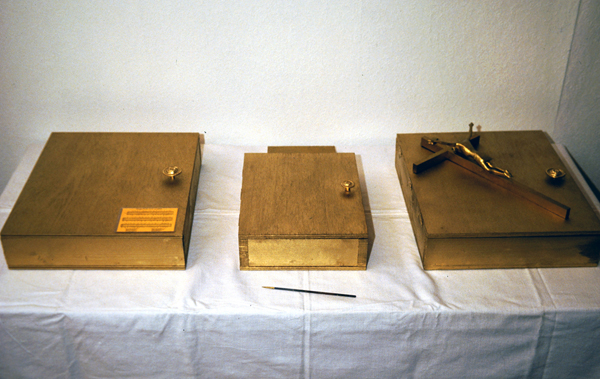
The smaller,
middle box was the Babytrap. This is what the needle-pointed steel rod
referred to. This was needed to use the cheap mousetrap. The inch-long, naked
plastic doll was laid onto the wooden foot, so that the spring-loaded metal
frame would crash down onto its neck. As a response to the hit, the doll would
turn on and thereby start the large coin-sized jukebox affixed behind it. They
had affixed a similar, small jukebox on the inside lid of the box named Bon
Appétit - Morgen Kinder wird's was geben. When the mousetrap would snap
shut though, the jukebox would not play Christmas music like it did when the
lid of the Bon Appétit box would close. Nailed to the wooden foot of
the mousetrap lay a doll with an open stomach, in a golden frame 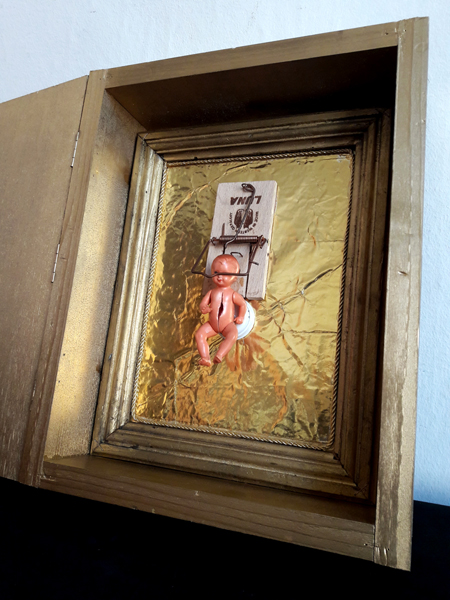 ,
to the other side of which he'd mounted a motif of the Boys triptych,
covered in yellow foil.
,
to the other side of which he'd mounted a motif of the Boys triptych,
covered in yellow foil.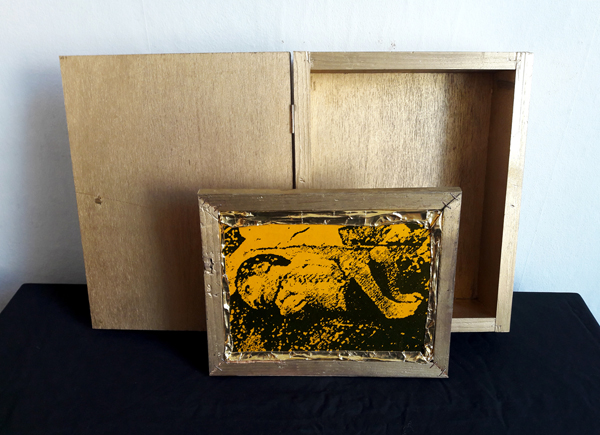 .
The plastic doll's open stomach maybe refers to the vertebrae stitches running
down like a zipper on the other side of the frame.
.
The plastic doll's open stomach maybe refers to the vertebrae stitches running
down like a zipper on the other side of the frame.
The crucifix
(My God / Mein Gott) on the lid of the right-hand-side box on the table,
with the ventrally nailed Christ, did not originally belong to the cabinet.
He made this immediately after his arrival, for an unfortunate two-day group
exhibition that had just opened that day. They asked him to make something for
the exhibition, and out of respect and friendly solidarity, he did not decline
the request. It was as if the Christ, laid onto the box on his stomach, was
incessantly staring into the inside of the box. He had constructed the crates
himself, and he had acquired all the furnishings locally. For the Bon Appétit
- Morgen Kinder wird's was geben box, he bought three oval wooden frames
at Kaufhof, spray-painted them gold, and put the cannibal family portraits inside
them. He glued recipes cut out from women's magazines onto the cardboard that
closed the back of the frames 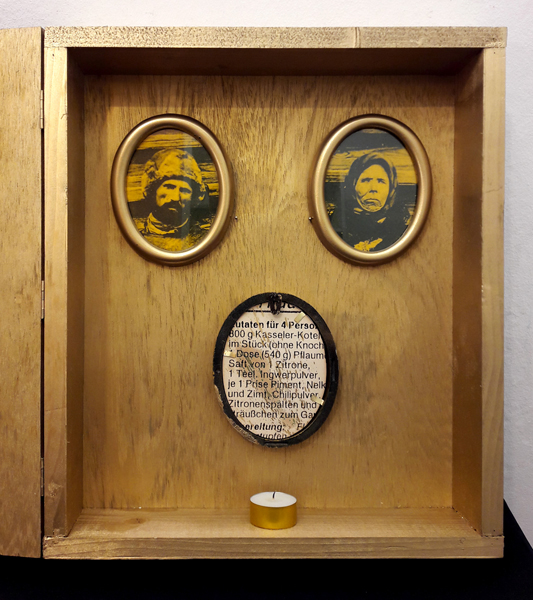 .
He placed a tea candle below the portrait of the half-eaten child
.
He placed a tea candle below the portrait of the half-eaten child 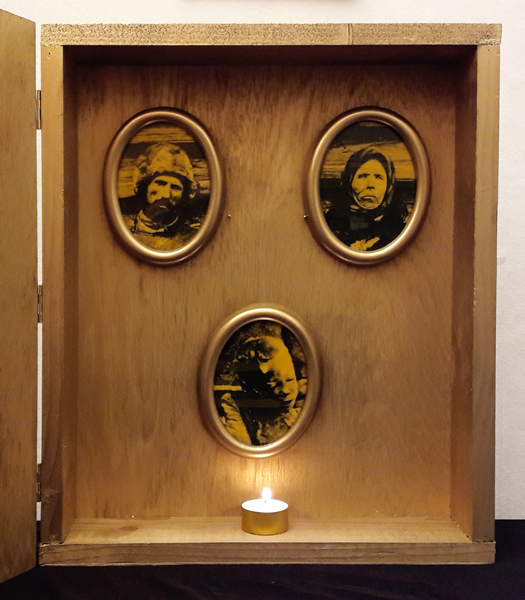 ,
which at first lit up the faces, and then smoked the child once the paraffin
melted, or the four-person ragu recipe belonging to it, depending on which side
he'd hung it up by that day. The box was accompanied by the lyrics of
a song playing when the lid of its crate was closed: "Morgen Kinder wird's
was geben..." This popular Christmas song first appeared in 1795 in a book
titled Songs of the Heart's Education. "Morgen, Kinder, wirds was
geben! / Morgen werden wir uns freun! / Welche Wonne, welches Leben / Wird in
unserm Hause seyn; / Einmal werden wir noch wach, / Heysa, dann ist Weihnachtstag"...
"Tomorrow, kids, will be a big day! / Great joy awaits us tomorrow! / What
wonder, what merriment, / that will envelop our house; / Only one more morning
/ and hey, Christmas Eve will be here…"
,
which at first lit up the faces, and then smoked the child once the paraffin
melted, or the four-person ragu recipe belonging to it, depending on which side
he'd hung it up by that day. The box was accompanied by the lyrics of
a song playing when the lid of its crate was closed: "Morgen Kinder wird's
was geben..." This popular Christmas song first appeared in 1795 in a book
titled Songs of the Heart's Education. "Morgen, Kinder, wirds was
geben! / Morgen werden wir uns freun! / Welche Wonne, welches Leben / Wird in
unserm Hause seyn; / Einmal werden wir noch wach, / Heysa, dann ist Weihnachtstag"...
"Tomorrow, kids, will be a big day! / Great joy awaits us tomorrow! / What
wonder, what merriment, / that will envelop our house; / Only one more morning
/ and hey, Christmas Eve will be here…" 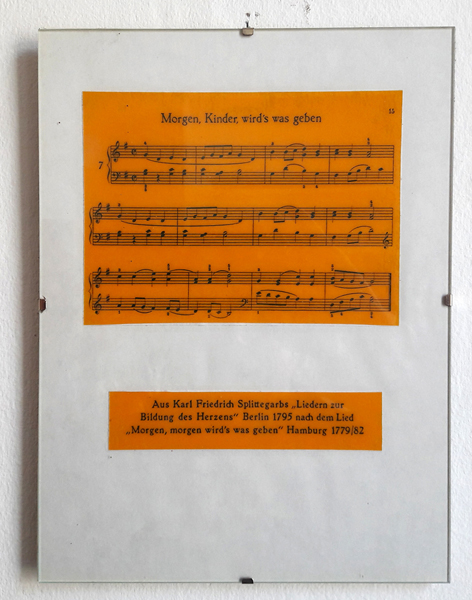
He bought
the accessories to the box titled Bon Appétit – Last Supper at the Turkish
kitsch bazar, where he was practically a regular. He bought the Baroque frame
together with the Last Supper's trivial reproduction. He placed the half-eaten
child's portrait in the copy's place 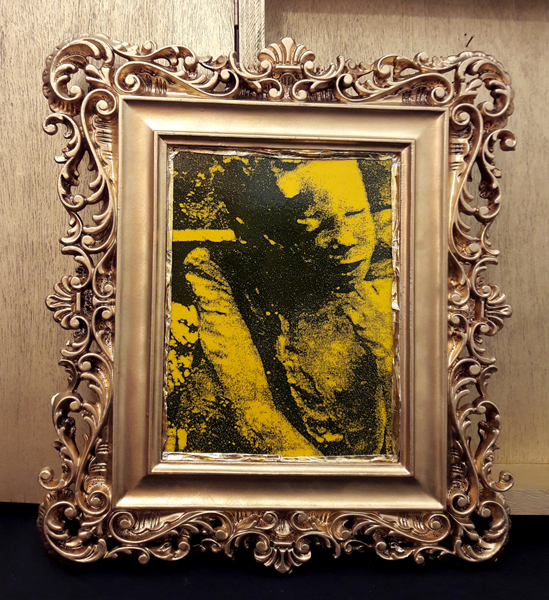 and mounted the Last Supper on the back of the frame. He pasted a glass
plate on the copy and wrote "Bon Appetit" on it, in gold ink.
and mounted the Last Supper on the back of the frame. He pasted a glass
plate on the copy and wrote "Bon Appetit" on it, in gold ink.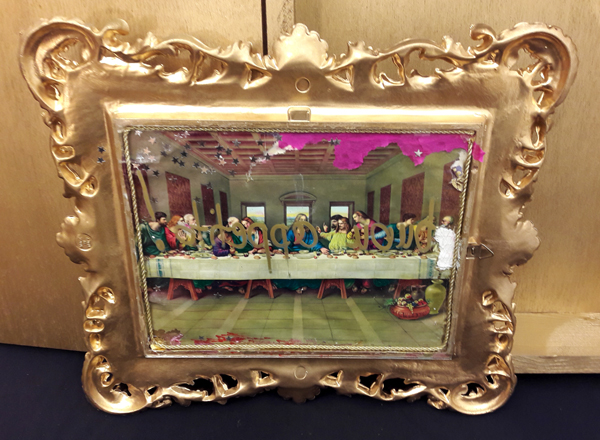
The
Deutsche Wunder Memorial refers to the post-WWII "German Economic
Miracle". The foundational motif of the installation is a plate 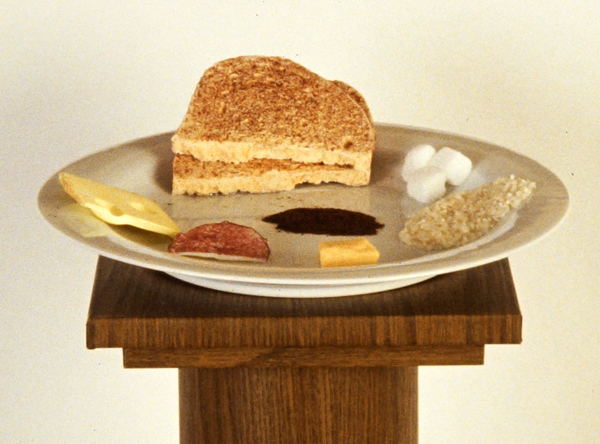 that splits the visual space of the setup in two. Up above, in the oak-patterned
frame
that splits the visual space of the setup in two. Up above, in the oak-patterned
frame 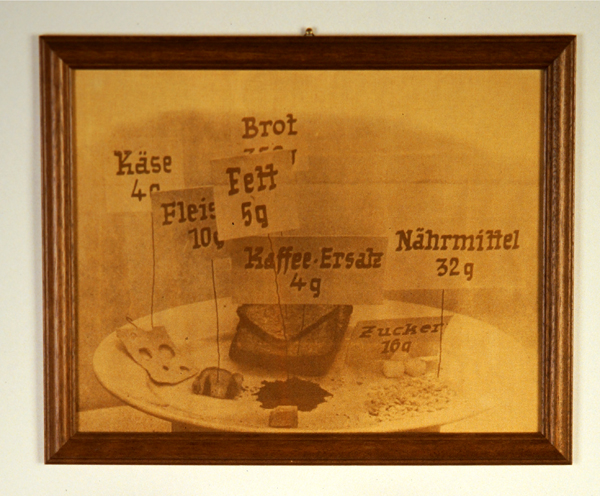 ,
an illustration of the early post-WWII food rations can be seen. From our modern
perspective, it's an astoundingly exact picture of a society that Josef was—presumably—not
very familiar with. On the plate is a single ration,
made partly of molded plastic, partly of real food, like for instance the sugar
cubes, the coffee, or the rice. The column covered in wallpaper reflects the
favored motif of typical German apartments, the oak-patterned furnishings. Normal
people's homes. "Deutsche Innenarchitektur", he said satisfactorily,
imitating the barking "grossdeutsche" tone after finishing
the wallpapering of the column. And, as if he were merely patting an animal's
flank, he slapped the side of the column.
,
an illustration of the early post-WWII food rations can be seen. From our modern
perspective, it's an astoundingly exact picture of a society that Josef was—presumably—not
very familiar with. On the plate is a single ration,
made partly of molded plastic, partly of real food, like for instance the sugar
cubes, the coffee, or the rice. The column covered in wallpaper reflects the
favored motif of typical German apartments, the oak-patterned furnishings. Normal
people's homes. "Deutsche Innenarchitektur", he said satisfactorily,
imitating the barking "grossdeutsche" tone after finishing
the wallpapering of the column. And, as if he were merely patting an animal's
flank, he slapped the side of the column.
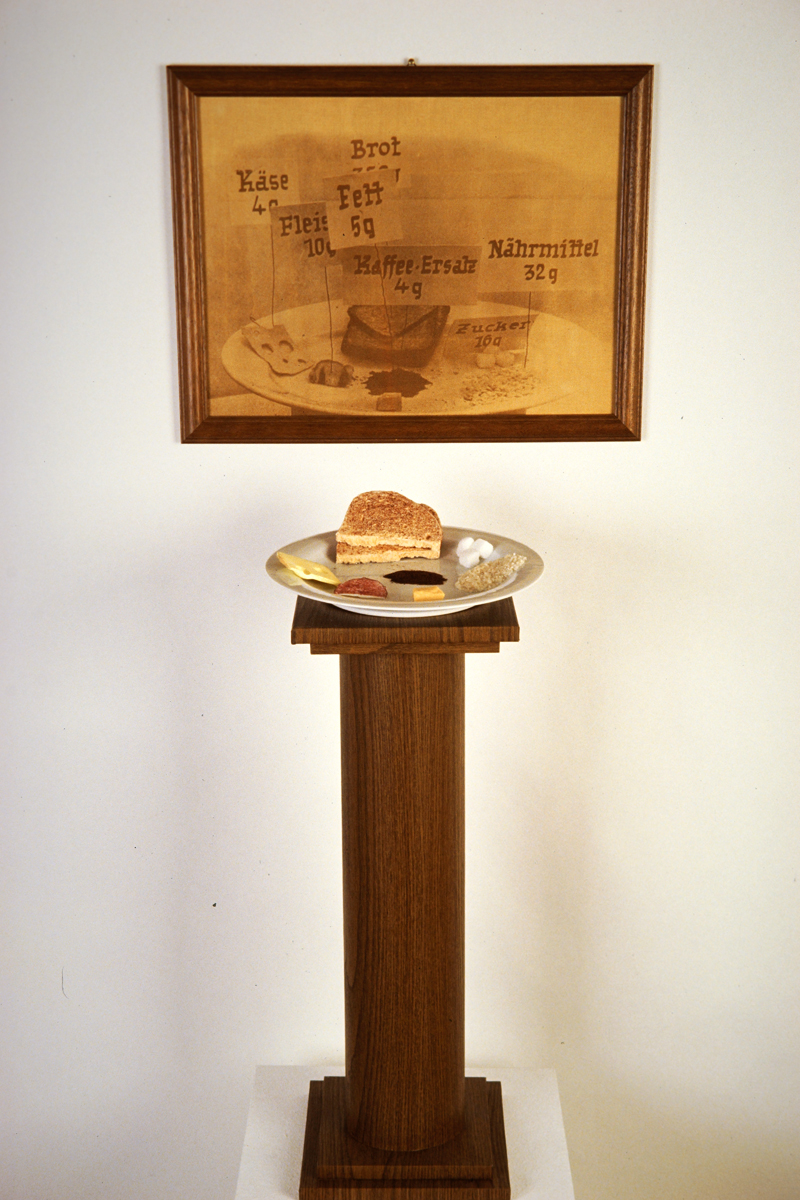
Several
so-called "satellite works" were made at the same time as the genesis
of the bizarre cabinet's exhibition. The installation titled Gotteszirkulation
or Doll Corner ![]() ,
the Cologne Kristallnacht
,
the Cologne Kristallnacht ![]() ,
the object titled My God, and the White Book
,
the object titled My God, and the White Book ![]() have
already come up tangentially. Photos of Nazarene, The Boy, the
Angelic Greeting and the other "satellite works", in some cases
simply drafts, can be found on this website, which documents the estate. He
originally wanted to write about these in this text as well, but finally he
decided to only connect the two "white books" to the exhibition's
materials. There were multiple reasons for this. One was that the two books'
main theme was already in the edition's room, and he actually worked on those
books throughout the duration of his stay there. The White Book, in its
original form, was the typical conceptual art idea of a native Hungarian poet,
who had already been writing for years in German, named Csaba Mánfai. A completely
white, blank book, on the cover of which they'd printed the acronym for Humane
Gesellschaft für Geistige Nekrophilie—the letters HGGN—and the imprint on
one of the final pages. After this, Cs. M. passed around the copies. That is,
he made them to be passed around, mostly to artist friends, so that everyone
could create their own copy, however they liked. This is how Josef got ahold
of two copies. The Kreuzbuch / Cross Book
have
already come up tangentially. Photos of Nazarene, The Boy, the
Angelic Greeting and the other "satellite works", in some cases
simply drafts, can be found on this website, which documents the estate. He
originally wanted to write about these in this text as well, but finally he
decided to only connect the two "white books" to the exhibition's
materials. There were multiple reasons for this. One was that the two books'
main theme was already in the edition's room, and he actually worked on those
books throughout the duration of his stay there. The White Book, in its
original form, was the typical conceptual art idea of a native Hungarian poet,
who had already been writing for years in German, named Csaba Mánfai. A completely
white, blank book, on the cover of which they'd printed the acronym for Humane
Gesellschaft für Geistige Nekrophilie—the letters HGGN—and the imprint on
one of the final pages. After this, Cs. M. passed around the copies. That is,
he made them to be passed around, mostly to artist friends, so that everyone
could create their own copy, however they liked. This is how Josef got ahold
of two copies. The Kreuzbuch / Cross Book 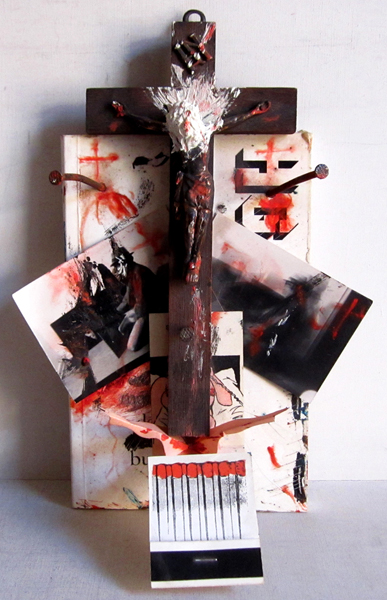 was probably only filled with pictures; that is, he never saw him write anything
in it. If he was working on the Kreuzbuch, there were regulary a pair
of scissors and glue with him; he never once saw a writing utensil in his hand
then.
was probably only filled with pictures; that is, he never saw him write anything
in it. If he was working on the Kreuzbuch, there were regulary a pair
of scissors and glue with him; he never once saw a writing utensil in his hand
then.
Although he was interested in what the other was doing, he always sensed a featureless,
shy gesture in his actions, and this prevented him from asking about projects
that were in progress. When he saw the need for it, Josef actually readily opened
up, and when he didn't, he likely had good reasons not to. Just as he had good
cause for nailing three long and thick nails into the book at some point. He
hammered the nail in through the vertical end of the wooden crucifix. At the
same time, the end of the crucifix held down an open, erotically themed sleeve
of matches. He got the matches in the city's only large-scale brothel, as a
sort of promotional gift. If he opened it, he'd see a naked, cartoon woman with
her legs spread open.
Josef placed the vertical end of the cross between this and hammered in the
lower nail here 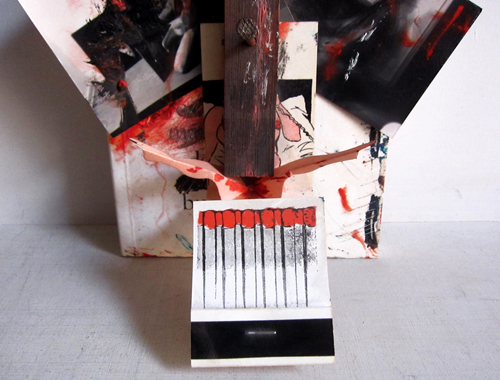 .
Where the ends of the cross met, at eye-level, he spilled a white blob of paint
.
Where the ends of the cross met, at eye-level, he spilled a white blob of paint
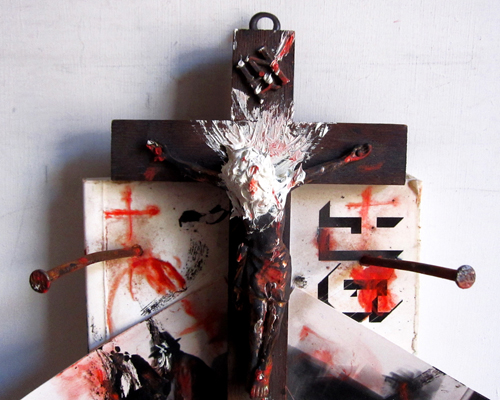 ,
and placed two photos below the vertical end, from the cycle called Josef
Scatters His Now-Useless Seed which, as it turned out, had been created
much earlier
,
and placed two photos below the vertical end, from the cycle called Josef
Scatters His Now-Useless Seed which, as it turned out, had been created
much earlier 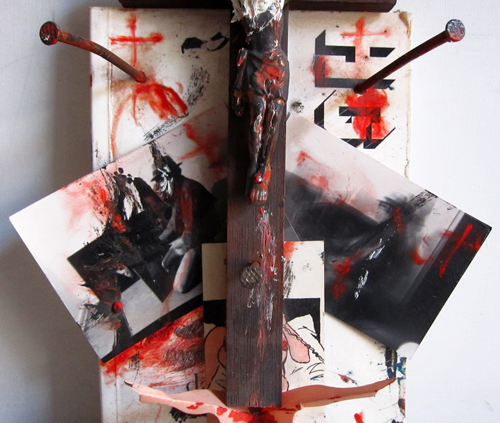 .
.
The other
book, which they finally put into the directory of objects, under the title
of White Book, originally carried the title Book of Banalities.
The first double-page of the book references this. This was undoubtedly his
most personal work. He mostly worked on it when he couldn't go out onto the
street. He couldn't step out of the downstairs apartment at that time either;
Mary would maintain the connection between the first and third floor. "The
black man is here again," said Josef, "I cannot get away from him."
Mary had a key to the apartment upstairs, but once she rang the doorbell, she
stopped at the door and knew, at that moment, exactly what would happen. She
completed it as if it, too, were part of the message. The other completed it
as someone who receives a message. K knew about these kinds of visits, but they
weren't against her will. "You know," she said, "I always know
he's up because I always have an orgasm at the same time as her." Josef
did not hide the fact he was in love with K and that he was chiefly writing
the White Book about her, and that's why he needed pictures of K. He
ordered the photos as if from an agency. "Let there be one of her pussy,
too, of the flesh," he said. What exactly Josef did with the pictures he
didn't know, because he never asked, and before anyone could leaf through them,
he glued the cut ends of the pages together. There are only pictures of the
double page title, an inner page, and one of the final double pages. It is no
longer possible to find out when he took them and why. The title comes
from an entry between the two photos glued to the inside of the title page:
Book of Banalities – Double Portrait. The one at the top is a part of
the Big Columbarium's source image, while the first is an upper body
of a Barbie doll 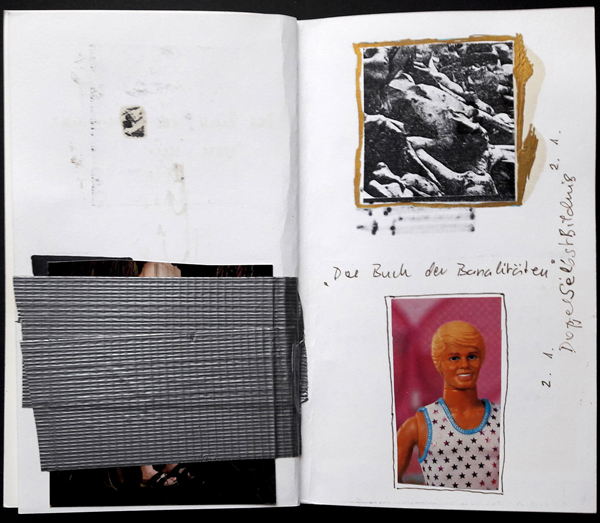 .
He was attracted to the Barbies in a lusty and murderous kind of way. At the
start of the project, he'd bought a bag of Barbie dolls and doll parts at the
nearby weekend flea market. He turned their limbs all night, carved into them
below their skirts and blouses, twisted their necks; later he wanted to build
the Triumph Column out of them based on the Traianus Column. The
figures on the relief that spiralled upward would have been deformed Barbie
torsos, tethered to a three-meter tall cardboard cylinder from a carpet store.
"Vertical mass grave," he said. Several more notes he made for the
White Book remained. In one of them, he wrote in his native language:
"Yesterday, I visited Denmark in my sleep, the city I lived in for twenty-six
years. On Gardener Street. We were standing on the balcony. Me, Mary, and the
two kids. Everything was grey and dusty with debris from the constant wind,
just like in real life. Nohr, the older one, suddenly says: Papa, don't die.
At that moment, my other son Mads climbs up onto the windowsill and stands there."
Mary did not want kids, actually, which is why Josef distinctly wanted some
of the pictures depicting a pregnant K. "You know," he once said,
when they were sitting on the upstairs apartment's balcony, staring musingly
at the huge sycamores nearby with subservient foilage, "the truth is I
would make a terrible writer. My sentences would be like a rough, over-used
towel. I'll leave the words up to you," he said and laughed. He laughed
too, and only realized much later that without this sentence, he probably would
never have gotten to M. Klein or to the other Josef waking up to the sound of
a grasshopper in his throat. Another note for the White Book: "Three
in the morning. I've been working for hours. The dark curtains closed. Yes,
I'm here. But why are you so certain of that? Yes, you're here. But where?"
Josef didn't know German well—with Mary, too, he spoke in English, and
he always mixed English and German. Likely, this is why he wrote the English
"who" in the German text instead of "where" (wo). "Ja,
du bist da. Aber who?" Then he crossed out the "h" and wrote
one more sentence on the paper: "You know it is hardest around three in
the morning?" Years later, it was from these notes that he figured out
that Josef had had an affair with K. "Yesterday or the day before that,"
he wrote, "I was a woman when I went to see K. And I knew that Gabriel,
the beautiful Gabriel, was wickedly jealous. I felt him as he was washing the
dishes. He carved his fist into every opening. At night, we licked my wife together.
It was infuriating. Meanwhile, the newscast was on in the background. I felt
like a war correspondent. My dick was rock hard. I love you, Germany!"
The other inner "page" of the White Book that is photographed
is a primary motif of a later installation, the Dachau Nuptials
.
He was attracted to the Barbies in a lusty and murderous kind of way. At the
start of the project, he'd bought a bag of Barbie dolls and doll parts at the
nearby weekend flea market. He turned their limbs all night, carved into them
below their skirts and blouses, twisted their necks; later he wanted to build
the Triumph Column out of them based on the Traianus Column. The
figures on the relief that spiralled upward would have been deformed Barbie
torsos, tethered to a three-meter tall cardboard cylinder from a carpet store.
"Vertical mass grave," he said. Several more notes he made for the
White Book remained. In one of them, he wrote in his native language:
"Yesterday, I visited Denmark in my sleep, the city I lived in for twenty-six
years. On Gardener Street. We were standing on the balcony. Me, Mary, and the
two kids. Everything was grey and dusty with debris from the constant wind,
just like in real life. Nohr, the older one, suddenly says: Papa, don't die.
At that moment, my other son Mads climbs up onto the windowsill and stands there."
Mary did not want kids, actually, which is why Josef distinctly wanted some
of the pictures depicting a pregnant K. "You know," he once said,
when they were sitting on the upstairs apartment's balcony, staring musingly
at the huge sycamores nearby with subservient foilage, "the truth is I
would make a terrible writer. My sentences would be like a rough, over-used
towel. I'll leave the words up to you," he said and laughed. He laughed
too, and only realized much later that without this sentence, he probably would
never have gotten to M. Klein or to the other Josef waking up to the sound of
a grasshopper in his throat. Another note for the White Book: "Three
in the morning. I've been working for hours. The dark curtains closed. Yes,
I'm here. But why are you so certain of that? Yes, you're here. But where?"
Josef didn't know German well—with Mary, too, he spoke in English, and
he always mixed English and German. Likely, this is why he wrote the English
"who" in the German text instead of "where" (wo). "Ja,
du bist da. Aber who?" Then he crossed out the "h" and wrote
one more sentence on the paper: "You know it is hardest around three in
the morning?" Years later, it was from these notes that he figured out
that Josef had had an affair with K. "Yesterday or the day before that,"
he wrote, "I was a woman when I went to see K. And I knew that Gabriel,
the beautiful Gabriel, was wickedly jealous. I felt him as he was washing the
dishes. He carved his fist into every opening. At night, we licked my wife together.
It was infuriating. Meanwhile, the newscast was on in the background. I felt
like a war correspondent. My dick was rock hard. I love you, Germany!"
The other inner "page" of the White Book that is photographed
is a primary motif of a later installation, the Dachau Nuptials 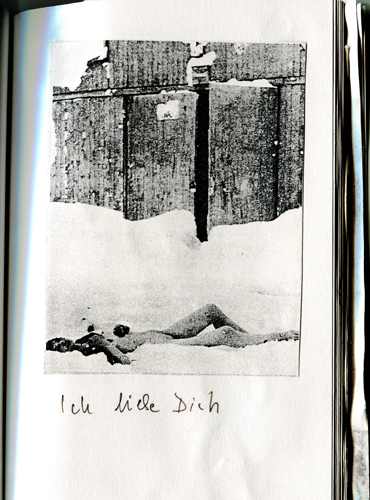 .
"Naked body lying in the snow before wooden barracks. The body is on its
back, its left knee drawn up, its head a little off to the side, it looks out
of the picture with half-open eyes. I walk toward it involuntarily. It doesn't
seem decayed; I can feel the flesh under the skin. I reach out my hand and touch
it, hesitantly. Dry, it feels like nothing. The door to the barracks open. A
black, figureless blotch. That's how I remember it. For a long time, I didn't
know what bothered me about the face. Simply a circumstance, but I didn't know
which one. At first, I thought of the still, filmy stare. Later I realized that
the long, thick nose bothers me. That's what uglies the features. My sight never
adjusted to this abnormality. Never. I lean forward—my face nearly touches my
face's shadow. I close my eyes and yearn to feel the body close to me, to feel
its skin on my skin." This is how he finished the text he added years later:
"The next day, we painted the whole building snow-white. The balconies,
the railings, the roof, even the weedy-grassy land surrounding the house, and
then we celebrated a secret wedding at one of the city's renovated, stylish
restaurants." And he simply burned the last pages
.
"Naked body lying in the snow before wooden barracks. The body is on its
back, its left knee drawn up, its head a little off to the side, it looks out
of the picture with half-open eyes. I walk toward it involuntarily. It doesn't
seem decayed; I can feel the flesh under the skin. I reach out my hand and touch
it, hesitantly. Dry, it feels like nothing. The door to the barracks open. A
black, figureless blotch. That's how I remember it. For a long time, I didn't
know what bothered me about the face. Simply a circumstance, but I didn't know
which one. At first, I thought of the still, filmy stare. Later I realized that
the long, thick nose bothers me. That's what uglies the features. My sight never
adjusted to this abnormality. Never. I lean forward—my face nearly touches my
face's shadow. I close my eyes and yearn to feel the body close to me, to feel
its skin on my skin." This is how he finished the text he added years later:
"The next day, we painted the whole building snow-white. The balconies,
the railings, the roof, even the weedy-grassy land surrounding the house, and
then we celebrated a secret wedding at one of the city's renovated, stylish
restaurants." And he simply burned the last pages  .
.
This was
about where he was in the text when he decided to pick up the notes he'd written
for the object titled Cologne Kristallnacht December 31st, 1989, and
unwrapped the picture panel. They watched the New Year's Eve fireworks from
behind the balcony door, as they did every year. That's where the picture was
taken from 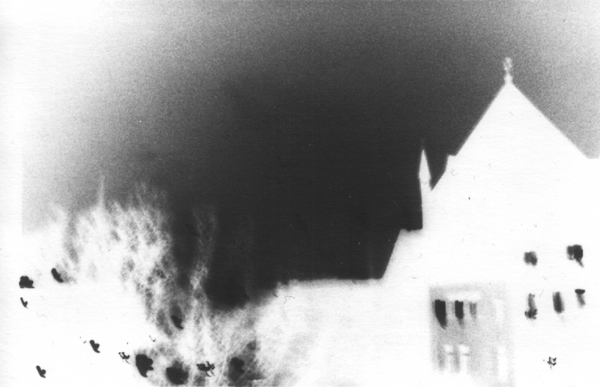 ,
and not from the first-floor window. Just the three of them: him, Josef, and
K stared at the crystal rainfall. Mary had escaped to the apartment's innermost
corner and hid there from the ear-splitting noise, like some frightened dog.
He decided to put Kristallnacht into the text, too, because he suddenly
felt like the entire Cologne exhibition, but even his later work, had the same
surface as the photo affixed to the wooden panel. Josef saw two indispensable
motifs of the so-called normal person's furnishings in the oak tree
styled furnitures and the white, sawdust wallpaper
,
and not from the first-floor window. Just the three of them: him, Josef, and
K stared at the crystal rainfall. Mary had escaped to the apartment's innermost
corner and hid there from the ear-splitting noise, like some frightened dog.
He decided to put Kristallnacht into the text, too, because he suddenly
felt like the entire Cologne exhibition, but even his later work, had the same
surface as the photo affixed to the wooden panel. Josef saw two indispensable
motifs of the so-called normal person's furnishings in the oak tree
styled furnitures and the white, sawdust wallpaper 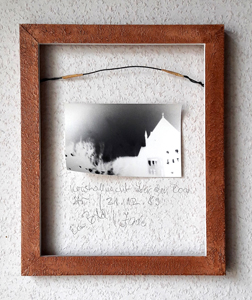 .
This is what gives all of his work its homogenous background that holds it all
together: The characters of all his installations do business in front of this
wall. Lots of normal, decent people - all zombies. A few years before
the installation, he wrote the following in a letter to Mary: "…I don't
know of a more exalted figure than the news-stand clerk, the postal worker,
or the plumber. Have you watched them at work yet?
Have you seen their horrific tools? Their twisting movements, frightening, completely
unprovoked grimaces? Or how they speak?! Why do you think you're safe in their
company? Do you know all they're capable of? You wouldn't believe my story of
their most absurd excesses. And if you were to see them at their home in their
safe, everyday habitats. Why do you think I'm perverted, aberrant?" His
draft notebooks were full of pieces of furniture that had a simple, middle-class
feel to them. Most of them were small commodes
.
This is what gives all of his work its homogenous background that holds it all
together: The characters of all his installations do business in front of this
wall. Lots of normal, decent people - all zombies. A few years before
the installation, he wrote the following in a letter to Mary: "…I don't
know of a more exalted figure than the news-stand clerk, the postal worker,
or the plumber. Have you watched them at work yet?
Have you seen their horrific tools? Their twisting movements, frightening, completely
unprovoked grimaces? Or how they speak?! Why do you think you're safe in their
company? Do you know all they're capable of? You wouldn't believe my story of
their most absurd excesses. And if you were to see them at their home in their
safe, everyday habitats. Why do you think I'm perverted, aberrant?" His
draft notebooks were full of pieces of furniture that had a simple, middle-class
feel to them. Most of them were small commodes 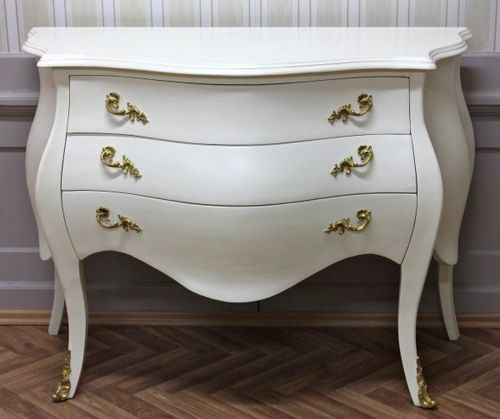 ,
vanities, nightstands
,
vanities, nightstands 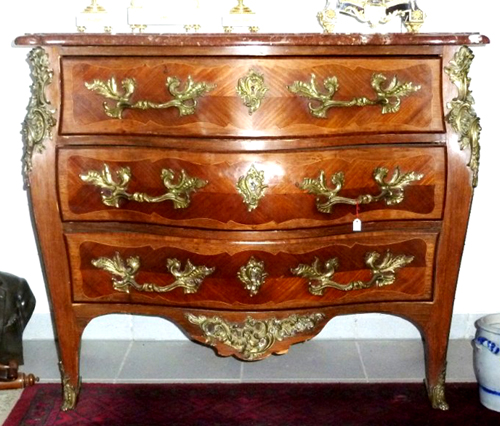 ,
and cabinets. On them, portraits, in sweet frames, of good folks beaming
,
and cabinets. On them, portraits, in sweet frames, of good folks beaming ![]() ,
bright-faced and clear-eyed
,
bright-faced and clear-eyed  .
Then the same themes in a zoom-out, making apparent the surroundings
of the still-lifes on the wall beside the furniture, with the original images
that belong to the portraits .
.
Then the same themes in a zoom-out, making apparent the surroundings
of the still-lifes on the wall beside the furniture, with the original images
that belong to the portraits .  ,
,
 . "All
flawless crystals," he said.
. "All
flawless crystals," he said.
Part 2
After
the Cologne Exhibition
Josef, Mary, and Yorick's direct collaboration was entirely restricted to the cabinet's compilation. The concepts of the five installations in the two years following the Cologne exhibition were probably solely Josef's. The installation titled Disturbances of Conception, which was erected at Bizarre Christmas, was a direct continuation of the cabinet. By then, they had already left the country for good, but Josef made a few more drafts before they left. This was the first work he erected entirely without Josef's presence, together with K. All three were still alive at the time of setting up the Entnetzung installation, but he only stayed in touch with Josef. At first, he tried to write down for Josef the apocalyptic surroundings of the former Soviet barracks of Hellerau, but Josef quickly cut him off, and from then on, he practically dictated the tasks with extreme precision, in a place and medium that he did not know at all. The White House, built as well in abandoned Soviet barracks, he already converted alone without Josef's direct instructions. When plans for a possible mausoleum came up during a long phone call that happened much earlier, it's likely that neither of them thought he would actually build a mausoleum in Potsdam, and that he would "meet" Mary there, for the last time, in a half-dilapidated hangar. And this is also where he saw the girl lying in the snow, the Dachau Nuptial bride, who ended up in quite a bizarre environment, at the Frankfurt Ars Erotica. The Identifikationssuch(t) then, is truly just his work. If Josef had still lived, he may have seen it as the start of a new era. Instead, it was the definitive conclusion of a process.
Disturbances of Conception was the first one he installed, without Josef's personal presence, together with K. They rented the "Lord's" S&M outfit from the basement level specialist store near the event. It was impossible to meet with the owner in person, so they only connected by phone. At first, she was not very trusting, although the recommender was the store's secret, or not-so-secret, S&M party photographer. She finally agreed to the rental, but they couldn't even take the price tags off the outfits. They simply tucked them in, so they wouldn't be hanging out. Luckily, nothing got damaged during the exhibition, they returned everything on time, and never worked again with Mrs. Katschtaler. Some years later, though, they learned from the Bild newspaper, that Mrs. K had been murdered. According to the rumours, it was because Mrs. K had started chatting to the media about her clients, among them one of the neighbouring city's police chiefs. This epilogue probably would've pleased Josef, but by then he was nowhere to be found. Before the exhibition, though, they had spoken regularly by phone, so the installation was actually created with his 'remote' direction.
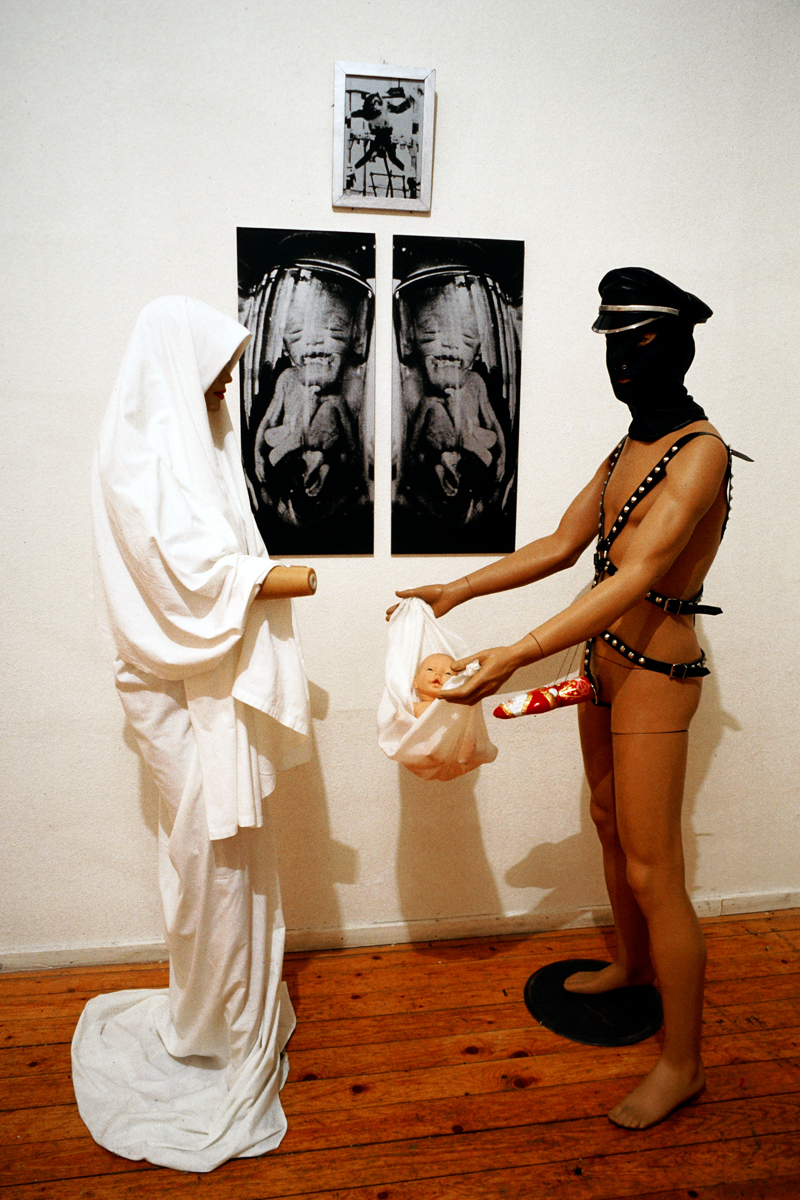
K had set
up the two main figures in the installation. The Lord hands over the
gift, the infant, to Mary looking up with a coquettish Lolita gaze,![]() reaching for the child, but her hand is missing so she has nothing to take the
gift with
reaching for the child, but her hand is missing so she has nothing to take the
gift with ![]() .
This is what the German title refers to: The etymology of Empfangen/Empfängnis,
which is in accordance with the Hungarian language's logic of conceive/conception.
The infant is a figure of the Bizarre Cabinet; he sat on the throne on
the pedestal in a purple robe, with a kitchen knife stabbed between his legs
.
This is what the German title refers to: The etymology of Empfangen/Empfängnis,
which is in accordance with the Hungarian language's logic of conceive/conception.
The infant is a figure of the Bizarre Cabinet; he sat on the throne on
the pedestal in a purple robe, with a kitchen knife stabbed between his legs
![]() . The tonality
and technique of the three pictures, set up like an altar
. The tonality
and technique of the three pictures, set up like an altar ![]() behind
the two main figures, refers to Bizarre Cabinet, too, to the three
panel images
behind
the two main figures, refers to Bizarre Cabinet, too, to the three
panel images![]() arranged beside the infant. Josef had already been out of Germany a long time,
one had to work rather quickly, and so there was not much time to interpret
what was discussed. The "twins" in the spirit bottle are clearly a
further interpretation of the disturbances of the ideal conception, or something
along similar lines. In hindsight, he viewed the crucifix as short-circuiting
the beginning and the end
arranged beside the infant. Josef had already been out of Germany a long time,
one had to work rather quickly, and so there was not much time to interpret
what was discussed. The "twins" in the spirit bottle are clearly a
further interpretation of the disturbances of the ideal conception, or something
along similar lines. In hindsight, he viewed the crucifix as short-circuiting
the beginning and the end  .
The three levels fit together as though they were creating a circle. The first
is the arm extending the bundle, and the stump across from it that cannot accept
it; the second is the smiling and snarling twins in the spirit bottle and the
crucified creature above them, the monkey-god. Reverse evolution, negative evangelism.
The only "outside" idea was the Lord's Santa penis
.
The three levels fit together as though they were creating a circle. The first
is the arm extending the bundle, and the stump across from it that cannot accept
it; the second is the smiling and snarling twins in the spirit bottle and the
crucified creature above them, the monkey-god. Reverse evolution, negative evangelism.
The only "outside" idea was the Lord's Santa penis ![]() ,
which K and Nicole G peeled with practiced movements
,
which K and Nicole G peeled with practiced movements ![]() ,
after which B bit off the bald head that stood out
,
after which B bit off the bald head that stood out ![]() ,
then spat out the half-eaten chocolate bits onto the floor. B's story is clearly
already present in this act.
,
then spat out the half-eaten chocolate bits onto the floor. B's story is clearly
already present in this act.
Dresden-Hellerau
and Potsdam. Two apocalyptic locations. Once they arrived in the Eastern sector,
he knew there would be trouble. Torn-up ditches for a hundred kilometers in
place of the road; monster machines jerking back and forth; smoking, incandescent
traffic. Warlike congestion, dirt, trash at the non-existent rest-stops. Fat,
wailing retirees in Thälmann hats on the broken-down, Eastern tourist bus. They
ate from yellowish, purplish, bland tin boxes and pissed and shat on the whole
area around the ostentatiously blue-colored, plastic portable toilets. He was
traveling with B.N., who considered the chaos and the badly dressed, rollicking
ragtag as a folklorist spectacle. Once they crossed the non-existent border,
he called Josef, and told him that he actually wasn't going to take this on
again, he didn't want to bear it. Josef, of course, didn't understand what he
was talking about; absentmindedly, all he said was, to do as he wished. Perhaps
this is what sobered him up out of hysteria, to realize what it was he wished
him to do. That hysteria is not the adequate response to the place, but what
he would build with Josef, or without him. He knew that Josef didn't have any
personal experience of political dictatorships, yet he still trusted him, limping
toward Dresden, not much later towards the Potsdam barracks' cataclysm. Unfortunately
for him, they put him up for the first two days with the one-time Communist
Führer's brown-noser, who was a feminist activist with a kapo face and lips
perpetually pressed to a thin line, who hissingly cursed the colonizing, West
German police state. Already at the breakfast table he stared silently at the
face pale with hate, and tried not to vomit into the cracked, white ceramic
plate the half-dozen mixed cereals that made up their organic breakfast. Luckily,
K arrived the next day. They moved to Hellerau, into a barrack near the former
theatre building 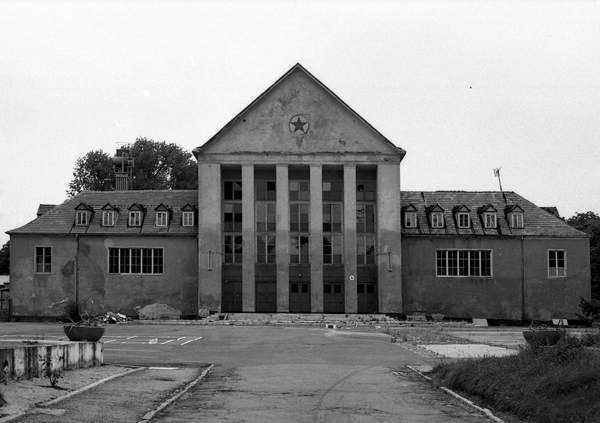 .
After the war, they threw out all the furniture from the monumental building,
painted several-story-high, primitive propaganda murals, and made the barracks
their headquarters. The building was in an undoubtedly dangerous condition,
yet the organizers, taking advantage of the anarchist situations at the
start of the Revolution, freely allowed for most of the festival's events to
take place, either in the building, or in the square in front of it. At first,
they looked around the building with B.N., so they could find room for the installation
they were planning with K. B.N. chose a windowless, upstairs room with a ceiling
about five meters high, that was like a huge, dark, empty loft with an even
'inner' height. This is where B.N. hung the taut ropes from which he hung the
black and white photographs—about the size of smaller posters—of men's,
women's and children's portraits who had died
violent deaths
.
After the war, they threw out all the furniture from the monumental building,
painted several-story-high, primitive propaganda murals, and made the barracks
their headquarters. The building was in an undoubtedly dangerous condition,
yet the organizers, taking advantage of the anarchist situations at the
start of the Revolution, freely allowed for most of the festival's events to
take place, either in the building, or in the square in front of it. At first,
they looked around the building with B.N., so they could find room for the installation
they were planning with K. B.N. chose a windowless, upstairs room with a ceiling
about five meters high, that was like a huge, dark, empty loft with an even
'inner' height. This is where B.N. hung the taut ropes from which he hung the
black and white photographs—about the size of smaller posters—of men's,
women's and children's portraits who had died
violent deaths  .
To the left of the room's entrance was a space separated by a tightly braided,
thick wire-mesh fence. This is where K placed the twisted, coiled, black
wooden statues that functioned as headstones
.
To the left of the room's entrance was a space separated by a tightly braided,
thick wire-mesh fence. This is where K placed the twisted, coiled, black
wooden statues that functioned as headstones 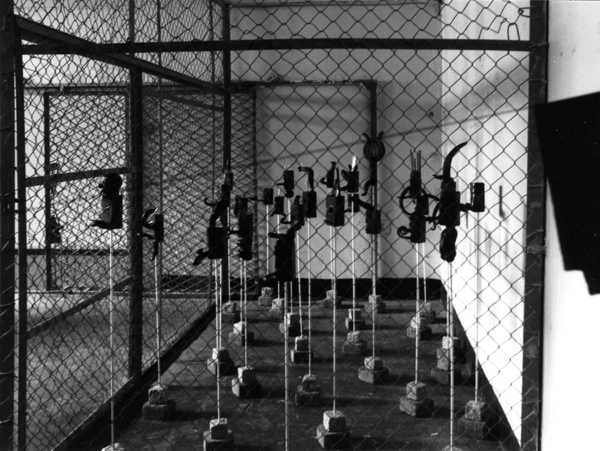 ,
and this is where she crawled naked, like a white, big-bellied animal, with
her fingers sunk in the holes, between the wire cage's inner walls. As it later
turned out, this cordoned-off part was the barracks' prison. Then we went back
to the ground floor and walked the side wings' long, empty hallways, where unmarked
wooden doors opened on either side. These spaces' original functions could not
be determined anymore, because they had been stripped down to the bone. Only
the bare, damaged, graffitied walls remained. Not a single piece of furniture
anywhere, only small, left-behind relics could sometimes be found on
the broken or lumpy hardwood floor
,
and this is where she crawled naked, like a white, big-bellied animal, with
her fingers sunk in the holes, between the wire cage's inner walls. As it later
turned out, this cordoned-off part was the barracks' prison. Then we went back
to the ground floor and walked the side wings' long, empty hallways, where unmarked
wooden doors opened on either side. These spaces' original functions could not
be determined anymore, because they had been stripped down to the bone. Only
the bare, damaged, graffitied walls remained. Not a single piece of furniture
anywhere, only small, left-behind relics could sometimes be found on
the broken or lumpy hardwood floor 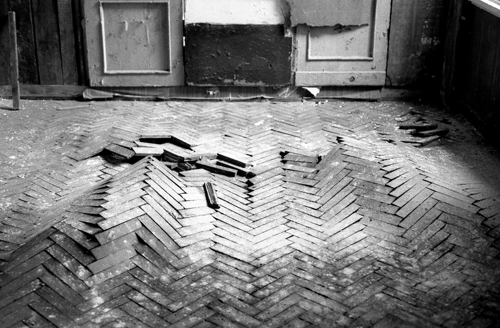 .
At the end of one of the hallways, we happened upon an area that consisted of
several rooms. There must have been a changing room and a bathroom because
the walls were covered in yellow tiles and one of the inner rooms had multiple
showers and a built-in bathtub. The shower-heads had either been taken out or
broken, for only dark holes and deformed parts signaled they had once been there.
It wasn't possible to picture the entire space's arrangement anymore. Stepping
through the door, one entered a roomy, square shaped space. Across the way,
about four meters from the space's end, thick, transparent glass tiles closed
off the end of the space. A common wall stood to the side. In the inner, L-shaped
space, one could step in through a door-less opening, between the two walls.
They closed off this opening from the inside, by dragging a cast iron tub
.
At the end of one of the hallways, we happened upon an area that consisted of
several rooms. There must have been a changing room and a bathroom because
the walls were covered in yellow tiles and one of the inner rooms had multiple
showers and a built-in bathtub. The shower-heads had either been taken out or
broken, for only dark holes and deformed parts signaled they had once been there.
It wasn't possible to picture the entire space's arrangement anymore. Stepping
through the door, one entered a roomy, square shaped space. Across the way,
about four meters from the space's end, thick, transparent glass tiles closed
off the end of the space. A common wall stood to the side. In the inner, L-shaped
space, one could step in through a door-less opening, between the two walls.
They closed off this opening from the inside, by dragging a cast iron tub 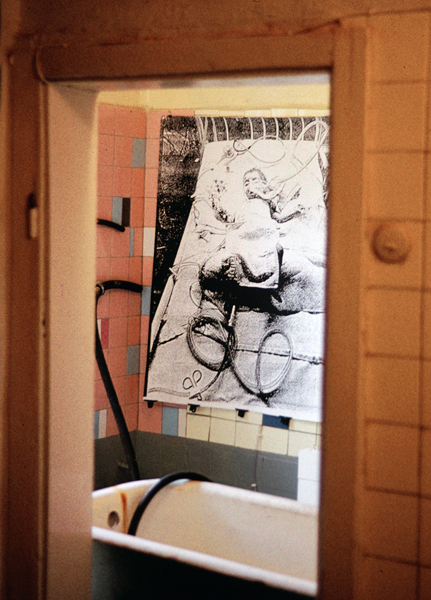 over from a different space, so that no one could access the back zone. Behind
the glass wall, they placed three constantly running screens that played
only white noise and emitted a sizzling sound
over from a different space, so that no one could access the back zone. Behind
the glass wall, they placed three constantly running screens that played
only white noise and emitted a sizzling sound 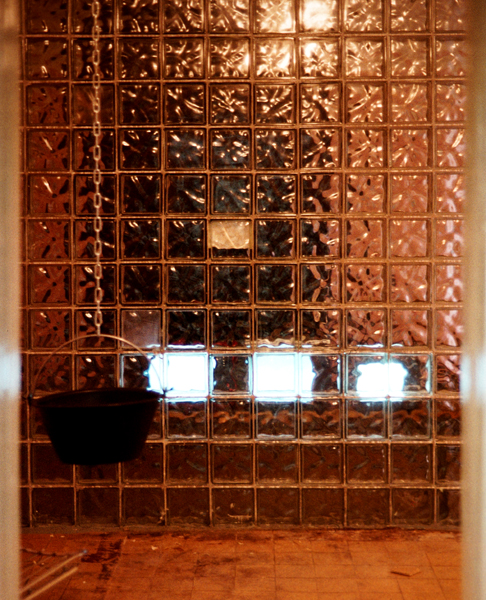 .
The bathroom was not behind the glass wall, but behind a stone wall, because
that's where the built-in tub was, and next to it several dented showers
filled with trash and dried faeces. In front of the wall, across from the opening,
on the curved edge of the tub, probably on the side where the head would rest,
blueish, purplish dried blood covered the tiles. It was as if a tall, wide body
had been slammed against the stones. According to members of the former Stasi
forces who patrolled the area, young wild boars would wander onto the practice
shooting range behind the building, and the soldiers would kill them with machine
guns, and hang them from the bathroom walls, so they would bleed out. This is
probably how the dry, table-sized sheet of blood got onto the tiles. This is
where we hung up the approximately two-meter-tall, one-and-a-half-meter wide,
black and white photo that was blown up to a greater size, already in
Cologne
.
The bathroom was not behind the glass wall, but behind a stone wall, because
that's where the built-in tub was, and next to it several dented showers
filled with trash and dried faeces. In front of the wall, across from the opening,
on the curved edge of the tub, probably on the side where the head would rest,
blueish, purplish dried blood covered the tiles. It was as if a tall, wide body
had been slammed against the stones. According to members of the former Stasi
forces who patrolled the area, young wild boars would wander onto the practice
shooting range behind the building, and the soldiers would kill them with machine
guns, and hang them from the bathroom walls, so they would bleed out. This is
probably how the dry, table-sized sheet of blood got onto the tiles. This is
where we hung up the approximately two-meter-tall, one-and-a-half-meter wide,
black and white photo that was blown up to a greater size, already in
Cologne 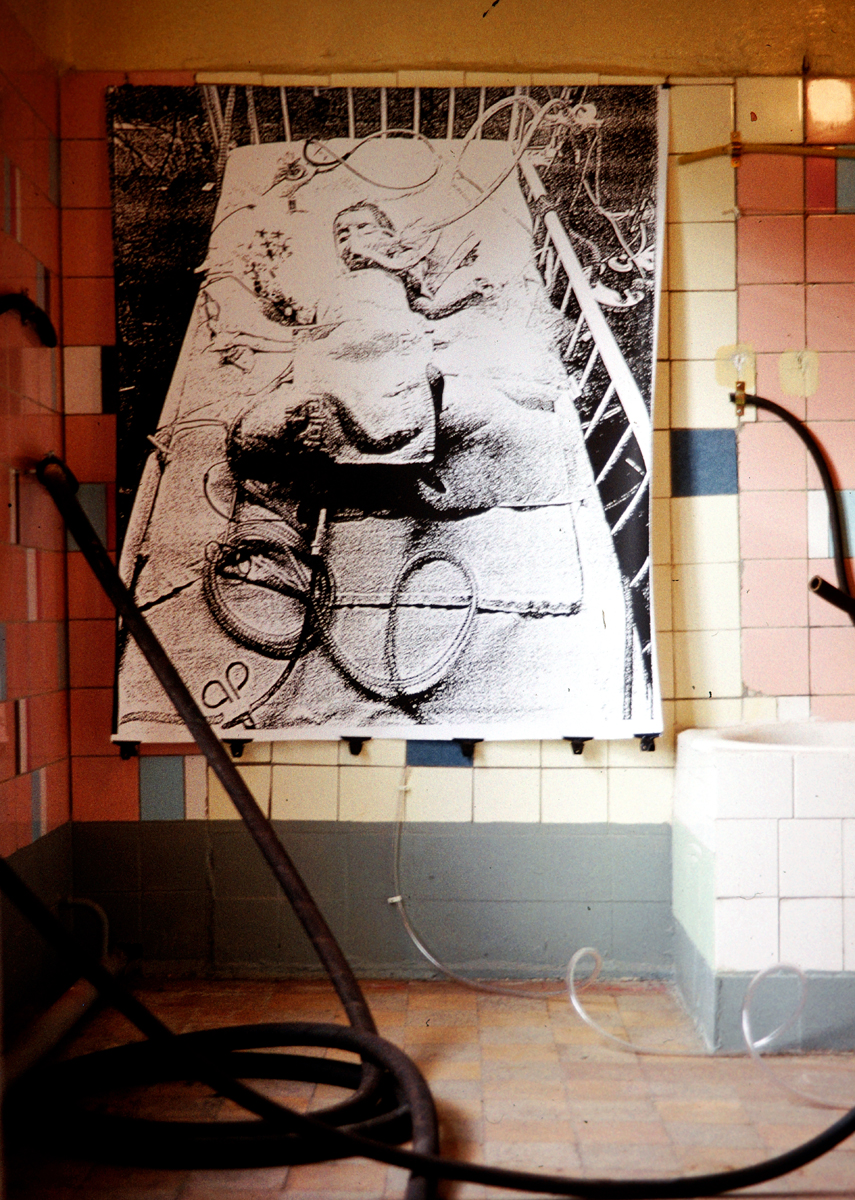 .
The photo shows a propped-up infant in an intensive care unit,
and the industrial rubber hoses connected to the picture were the continuation
of the medical apparatuses
.
The photo shows a propped-up infant in an intensive care unit,
and the industrial rubber hoses connected to the picture were the continuation
of the medical apparatuses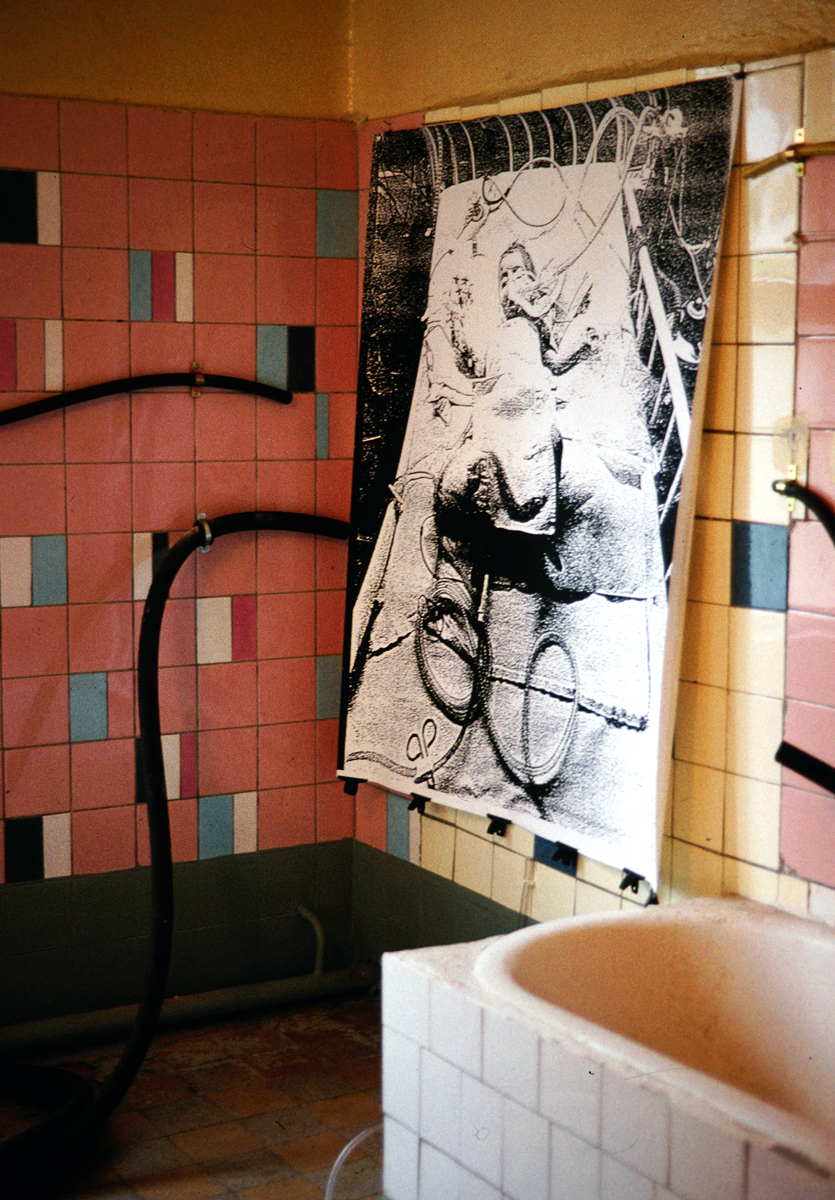 .
The perpetually working monitors cracked and crackled at full volume behind
the wall. The popping crunches and the bluish white flashes gave the feeling
of wide, silvery blades slapping the glass bricks from the inside. The iron
rail that ended up on the right-hand side wall in the foyer, was the one they
had also used several months earlier, in the exhibition titled Installed
Rituals. The rail with the butcher hooks hanging from it was a furnishing
of a middle-class interior room. Instead of an empty, black plastic bucket,
this time they hung a black iron ball on a chain from it
.
The perpetually working monitors cracked and crackled at full volume behind
the wall. The popping crunches and the bluish white flashes gave the feeling
of wide, silvery blades slapping the glass bricks from the inside. The iron
rail that ended up on the right-hand side wall in the foyer, was the one they
had also used several months earlier, in the exhibition titled Installed
Rituals. The rail with the butcher hooks hanging from it was a furnishing
of a middle-class interior room. Instead of an empty, black plastic bucket,
this time they hung a black iron ball on a chain from it
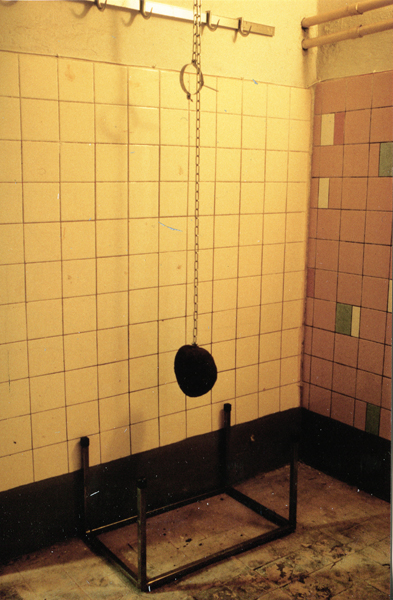 .
In front of it, they placed a metal table and a chair frame with its legs sticking
up in the air. Josef would have clearly been satisfied with the installation.
"I've never witnessed such an inconsolable, ‘meaningless,' nihilistic space.
In Hellerau, we erected one of the stage images of negative existence. Exactly
where we were. And where we came from." Entnetzung. This is why he could
not have turned around half way down the freeway under construction.
.
In front of it, they placed a metal table and a chair frame with its legs sticking
up in the air. Josef would have clearly been satisfied with the installation.
"I've never witnessed such an inconsolable, ‘meaningless,' nihilistic space.
In Hellerau, we erected one of the stage images of negative existence. Exactly
where we were. And where we came from." Entnetzung. This is why he could
not have turned around half way down the freeway under construction.
"At
last, this is where space, text, and image meet. Strange that I originally wrote:
‘I fell asleep with the conviction that I would never write again.' Fifteen
years later, I remembered as though I had written: 'I woke up with the conviction
that I would never write again.' Which step do I need to take, then? In Potsdam,
I met with Mary again and for the last time. This is where I irretrievably realized
that all my following gestures could only be redemption. That's why I wanted
to leave something of my body behind at the house. And this is why Potsdam became
the location of the secret nuptials, the Dauchau Honeymoon" he wrote
in his first set of notes about the Potsdam project. Not long after Dresden-Hellerau,
he wrote a few lines to Josef. He mentioned the Potsdam invitation, too, but
had not yet decided then whether he'd accept. Several weeks later, he received
a picture from Josef without any commentary. It was as if it had just been a
page ripped from a book. When he took it out of the large cardboard envelope
and looked at it for the first time, he thought how a person doesn't just lay
down naked in the snow, willingly 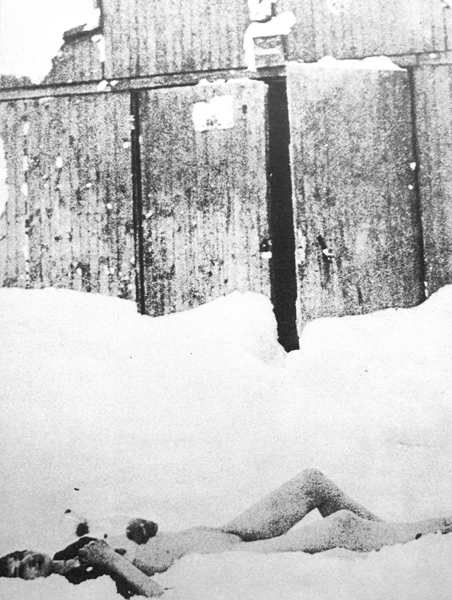 .
Then, about how, in contrast to the situation, she was disproportionately
well nourished. These were his exact thoughts, which he wrote in the Potsdam
notebook. Later, with a red pen, he added: "Can the dead have a situation?"
When he re-read the notes later, while processing them, he was once again taken
aback by his word usage, just as he'd been upon seeing the image for the first
time. As if he'd committed a secret crime by thinking the word "disproportionate"
in regard to a situation in which the word disproportionate totally loses all
meaning. When he mentioned this uncomfortable thought interlude to Josef, he
only responded: "Why does it matter what kind of words we use when language
itself is invalid?" The whole thing actually started off like a convivial
family trip. They loaded up the car with all kinds of personal belongings, buckled
up the kids in the back seat for the trip, which they didn't know how long it
would last, and went on their way. They arrived in the city late at night,
to the organizers' apartment. The organizers were no longer up to riding with
them to the other side of the city, to their arranged lodgings, so they all
slept in a crowded hall, which had been converted into a night-time sanctuary,
and resembled a theater storage room. The following day, they got a hellish
loft room in Babelsberg, next to some lake or river, from which swarms of hungry,
aggressive mosquito commandos poured in at night. Every day, at dawn, he went
out to the field and hung around giddily with B.N. in the smothering
heat, until late into the night. K usually joined them around noon, after dropping
the kids off in the city. Hellerau was actually just a larger collection of
buildings, while the Potsdam barracks was a regular city's architecture, somewhat
like the Zone scenery from Tarkovsky's film, Stalker. A pestilent odour emanated
from the infected ground that was ruptured and torn up everywhere. In some
places, greenish-brown coated lakes had formed. The rundown, several-story-high
buildings that once housed officers, decayed among them
.
Then, about how, in contrast to the situation, she was disproportionately
well nourished. These were his exact thoughts, which he wrote in the Potsdam
notebook. Later, with a red pen, he added: "Can the dead have a situation?"
When he re-read the notes later, while processing them, he was once again taken
aback by his word usage, just as he'd been upon seeing the image for the first
time. As if he'd committed a secret crime by thinking the word "disproportionate"
in regard to a situation in which the word disproportionate totally loses all
meaning. When he mentioned this uncomfortable thought interlude to Josef, he
only responded: "Why does it matter what kind of words we use when language
itself is invalid?" The whole thing actually started off like a convivial
family trip. They loaded up the car with all kinds of personal belongings, buckled
up the kids in the back seat for the trip, which they didn't know how long it
would last, and went on their way. They arrived in the city late at night,
to the organizers' apartment. The organizers were no longer up to riding with
them to the other side of the city, to their arranged lodgings, so they all
slept in a crowded hall, which had been converted into a night-time sanctuary,
and resembled a theater storage room. The following day, they got a hellish
loft room in Babelsberg, next to some lake or river, from which swarms of hungry,
aggressive mosquito commandos poured in at night. Every day, at dawn, he went
out to the field and hung around giddily with B.N. in the smothering
heat, until late into the night. K usually joined them around noon, after dropping
the kids off in the city. Hellerau was actually just a larger collection of
buildings, while the Potsdam barracks was a regular city's architecture, somewhat
like the Zone scenery from Tarkovsky's film, Stalker. A pestilent odour emanated
from the infected ground that was ruptured and torn up everywhere. In some
places, greenish-brown coated lakes had formed. The rundown, several-story-high
buildings that once housed officers, decayed among them 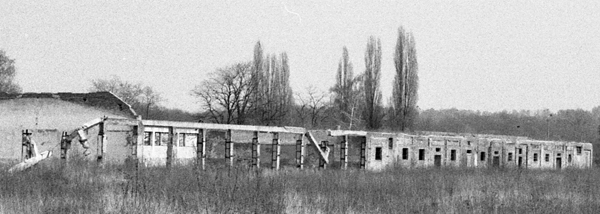 ;
the looted barracks, bunkers, underground catacombs, empty hangars
;
the looted barracks, bunkers, underground catacombs, empty hangars 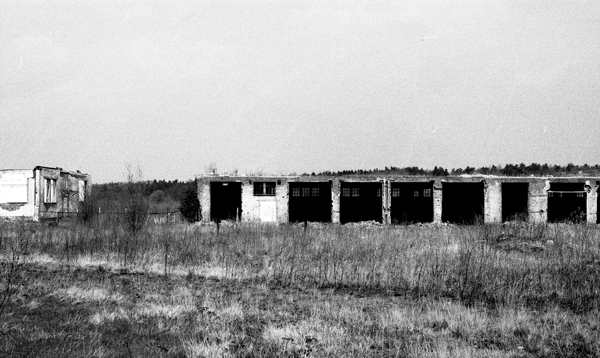 ;
halls stripped to bricks; collapsed, gigantic trains of unknown functions. Finally,
they chose a building the size of a family house
;
halls stripped to bricks; collapsed, gigantic trains of unknown functions. Finally,
they chose a building the size of a family house 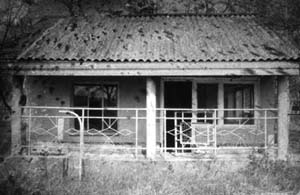 ,
that may once have been used as offices, near the waterlogged tank-washing pit.
He didn't call Josef, because he knew he could only rely on himself here. On
the first day, they cleaned the trash from the house, and for the next
three days they plastered, built walls, and then painted the outside
of the whole house with whitewash
,
that may once have been used as offices, near the waterlogged tank-washing pit.
He didn't call Josef, because he knew he could only rely on himself here. On
the first day, they cleaned the trash from the house, and for the next
three days they plastered, built walls, and then painted the outside
of the whole house with whitewash 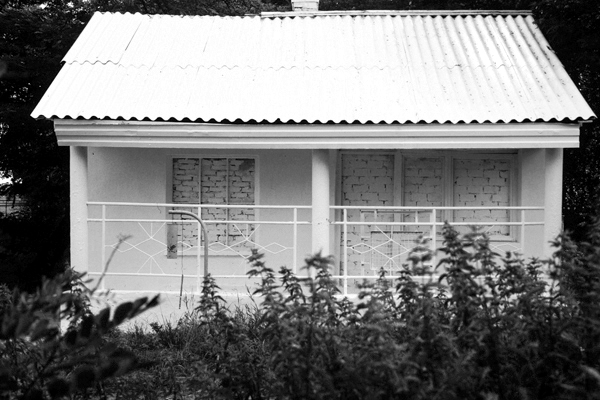 ,
the roof, the porch, the surrounding trees, bushes, and even the ground
,
the roof, the porch, the surrounding trees, bushes, and even the ground 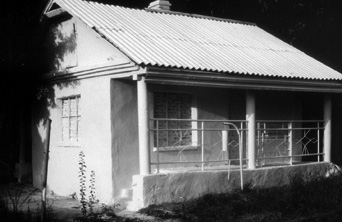 .
There was only one opening they didn't wall up: the narrow door opening in the
back of the building. In front of it, they put up a double light filter, made
of cloth, and brought the accessories inside. Enlarger, paint rollers, plastic
plates, industrial drying appliances, electronic cables, dividers, liquid emulsions
and developer by the canisters, and a few more things that were absolutely necessary
to physical survival. Then he undressed to his underwear and moved into the
house. After half an hour, the thermometer gave out. It could not measure the
heat anymore, and if there had also been a humidity-measuring device in the
house, that surely would have given out, too. He turned on the red safelights
in the almost hermetically sealed building and started painting the smooth walls
with liquid emulsion from paint rollers that had been prepared just for this
purpose. He created several meter-long surfaces of the same size, as if he was
just making large panel images for an exhibition. Once done, he set up and turned
on the dryers, then lay down on the floor, on his back. His entire body perspired
continuously, and the perspiration mixed with the excreting chemicals. He stared
at the thick, reddish, whirling darkness for a while, then closed his eyes.
He lost all track of time; he had no idea how many hours he had been working,
or for how many hours he had already been lying on the ground in the walled-up
house. Apart from the laboratory clock, he had no other way to tell time. Sometimes
he got up, checked on the state of the emulsion, and then either walked around
for a little while longer or lay back on the ground. He thought it might be
morning outside, when he set up the enlarger for the image and started enlarging
the first picture onto the emulsive surfaces. He had brought six black and white
negatives from the photos taken at the zone. Some of them he lit for 40-45 minutes,
then poured developer into plastic buckets and covered the emulsive surfaces
with a clean paint roller. Sometimes he paused, as he couldn't determine the
quality of the image slowly developing before him, through the curtain of sweat
descending around his eyes. At these times, he would take one of the safelights
in his hands, and lean and wobble around the image, like a ghost. He was essentially
unconscious by the time he enlarged the last image. All he felt, opaquely, was
that a foreign machine was working inside him, and completing for him the obviously
necessary movements. He let go of his consciousness completely, or perhaps his
consciousness let go of him, but in either case, he came back to himself when
the paint roller dropped at his feet, with a loud bang. He looked at the object
before him, in disbelief for a second, then looked at the image and sensed it
was done. From somewhere, deep in the well of the dark space, he grabbed a chair,
dragged it to the room's center, and collapsed onto it. He stared at the pictures
looming around him, the reddish, vibrating light, and while he felt everything
around him, it was as though he was in an entirely different dimension from
where his body was staying, or, to be more exact, where his body could be found.
This new state of physical exhaustion he had reached paralyzed him, as well
as the fever caused by soaking his body in polluted, chemical sweat, and the
absolute certainty that the Dachau girl had not left his side for one second.
At first, he thought he wanted not only her fluids, the dimming light in her
eyes, her smoldering skin, but her life itself, that he wanted to bury her,
wall her in, alive, and that's why he was incapable of moving. He dropped his
jaw to his chest and started sinking with ease into the gelatinous medium of
resignation. Only at the very last second, he realized, and not due to cowardice
or instinct, that he wanted the exact opposite, not to leave her there, not
to let her decompose in this corrosive darkness, but to take her with him, out
of this house, the incandescent ice, the desert snow, because she didn't want
to suffocate, as she was, after all, a young, youthful girl, it took just once
glance at her exposed body to realize this; she was not so beautiful now perhaps,
and yet she was still desirable, and could be loved, even as a corpse.
.
There was only one opening they didn't wall up: the narrow door opening in the
back of the building. In front of it, they put up a double light filter, made
of cloth, and brought the accessories inside. Enlarger, paint rollers, plastic
plates, industrial drying appliances, electronic cables, dividers, liquid emulsions
and developer by the canisters, and a few more things that were absolutely necessary
to physical survival. Then he undressed to his underwear and moved into the
house. After half an hour, the thermometer gave out. It could not measure the
heat anymore, and if there had also been a humidity-measuring device in the
house, that surely would have given out, too. He turned on the red safelights
in the almost hermetically sealed building and started painting the smooth walls
with liquid emulsion from paint rollers that had been prepared just for this
purpose. He created several meter-long surfaces of the same size, as if he was
just making large panel images for an exhibition. Once done, he set up and turned
on the dryers, then lay down on the floor, on his back. His entire body perspired
continuously, and the perspiration mixed with the excreting chemicals. He stared
at the thick, reddish, whirling darkness for a while, then closed his eyes.
He lost all track of time; he had no idea how many hours he had been working,
or for how many hours he had already been lying on the ground in the walled-up
house. Apart from the laboratory clock, he had no other way to tell time. Sometimes
he got up, checked on the state of the emulsion, and then either walked around
for a little while longer or lay back on the ground. He thought it might be
morning outside, when he set up the enlarger for the image and started enlarging
the first picture onto the emulsive surfaces. He had brought six black and white
negatives from the photos taken at the zone. Some of them he lit for 40-45 minutes,
then poured developer into plastic buckets and covered the emulsive surfaces
with a clean paint roller. Sometimes he paused, as he couldn't determine the
quality of the image slowly developing before him, through the curtain of sweat
descending around his eyes. At these times, he would take one of the safelights
in his hands, and lean and wobble around the image, like a ghost. He was essentially
unconscious by the time he enlarged the last image. All he felt, opaquely, was
that a foreign machine was working inside him, and completing for him the obviously
necessary movements. He let go of his consciousness completely, or perhaps his
consciousness let go of him, but in either case, he came back to himself when
the paint roller dropped at his feet, with a loud bang. He looked at the object
before him, in disbelief for a second, then looked at the image and sensed it
was done. From somewhere, deep in the well of the dark space, he grabbed a chair,
dragged it to the room's center, and collapsed onto it. He stared at the pictures
looming around him, the reddish, vibrating light, and while he felt everything
around him, it was as though he was in an entirely different dimension from
where his body was staying, or, to be more exact, where his body could be found.
This new state of physical exhaustion he had reached paralyzed him, as well
as the fever caused by soaking his body in polluted, chemical sweat, and the
absolute certainty that the Dachau girl had not left his side for one second.
At first, he thought he wanted not only her fluids, the dimming light in her
eyes, her smoldering skin, but her life itself, that he wanted to bury her,
wall her in, alive, and that's why he was incapable of moving. He dropped his
jaw to his chest and started sinking with ease into the gelatinous medium of
resignation. Only at the very last second, he realized, and not due to cowardice
or instinct, that he wanted the exact opposite, not to leave her there, not
to let her decompose in this corrosive darkness, but to take her with him, out
of this house, the incandescent ice, the desert snow, because she didn't want
to suffocate, as she was, after all, a young, youthful girl, it took just once
glance at her exposed body to realize this; she was not so beautiful now perhaps,
and yet she was still desirable, and could be loved, even as a corpse.
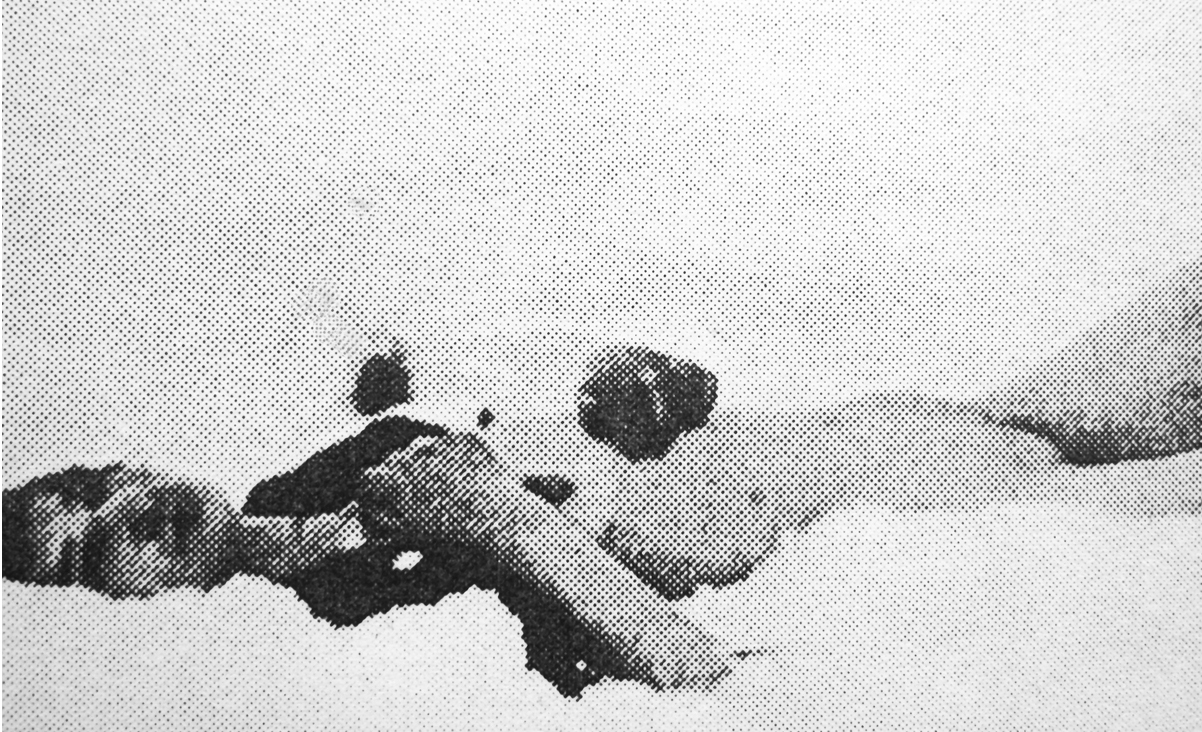
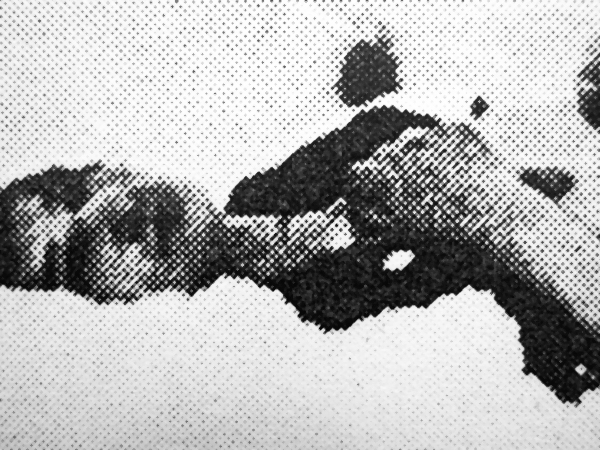
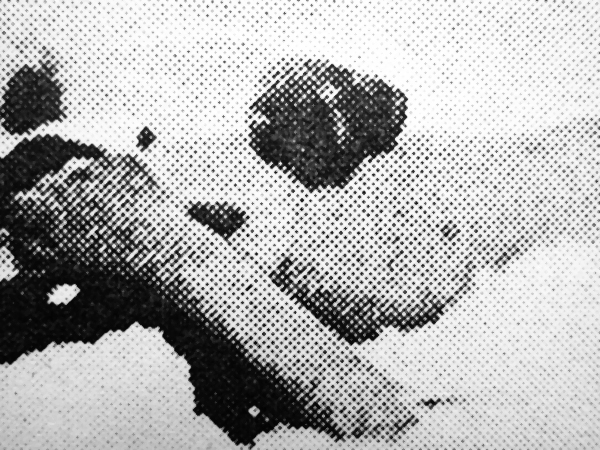
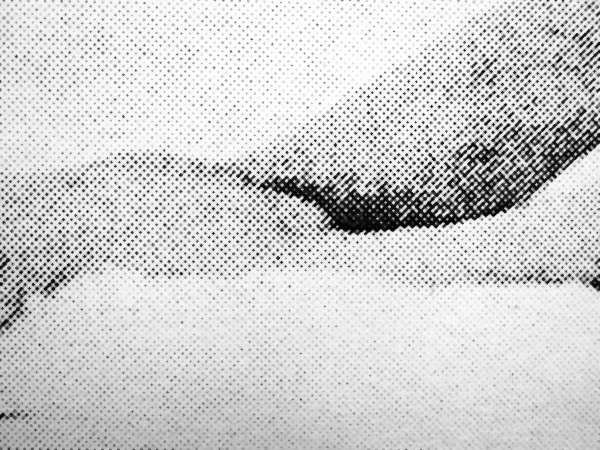
Finally, he stood up and started pacing around the dark, with uncertain steps. He completely lost his sense of direction. He had no idea which corner of the building he was in, which way the exit may be. He quietly muttered to himself, and it was as though he was gesticulating, too, like an imbecile, but he was only searching with outstretched arms in the dark, for the exit, until one of his hands finally got caught in one of the inner light filter's cloth curtains. He bent it towards himself a bit, and tried screaming into the empty darkness in the hope his voice would carry to outside the building. Nothing happened for a while, but then he thought he heard B.N.'s voice, which he suddenly drew strength from, and yelled out, probably a little too loudly, that he had finished. B. signaled that everything was alright, and he meanwhile started passing the furniture, tools, and accessories outside. When he staggered out of the house, he recoiled for a moment, from the sharp, cutting, white light shining into his eyes. He stripped off his pants and started pouring onto himself from tin buckets left before the opening, filled with a mixture of rain and ground water, retrieved from a ditch behind the house. Then they walled up the final opening as well, took down the light filter that served no further purpose, and left the house to its fate. On the freeway to Cologne the following night, he thought about how the house might be demolished: whether it would simply be bulldozed and stomped into the ground, or if one of the crew members would wonder about the building's snow white outer walls, the walled-up windows and doors, and at first knock with curiosity on the sarcophagus's walls, trying to figure out the meaning of the bonging noise, then carefully open up one of the walls, and suddenly see one of the pictures, but before he could truly be amazed, the sight would already be de-forming, vanishing in the dark, before his eyes, because he had only projected the images onto the wall, as opposed to fixing them there. "Not a single picture can remain. Not a single one," he once wrote in the black notebook. It's impossible to find out from the notes, by now, whether these were Josef's words, or his own thoughts.
Arc Erotica, Frankfurt. 4-5-square-meter-tall shaft-like booths. One could reach them through a long, narrow, completely closed hallway. He had no idea what their original function might have been. The space didn't have a door; its entrance was a narrow opening. There was a sudden left turn at the end of the hallway, then a right turn after two steps, and the opening was right there. He couldn't remember, anymore, who he had developed the picture with, only that they stood there, above a plastic bucket, pushing the photographic paper into the developer. It was like drowning newborn kittens. Then he nailed the top of the picture onto the white wall, high enough so that if he were to let it hang down, the girl would be lying on the table.
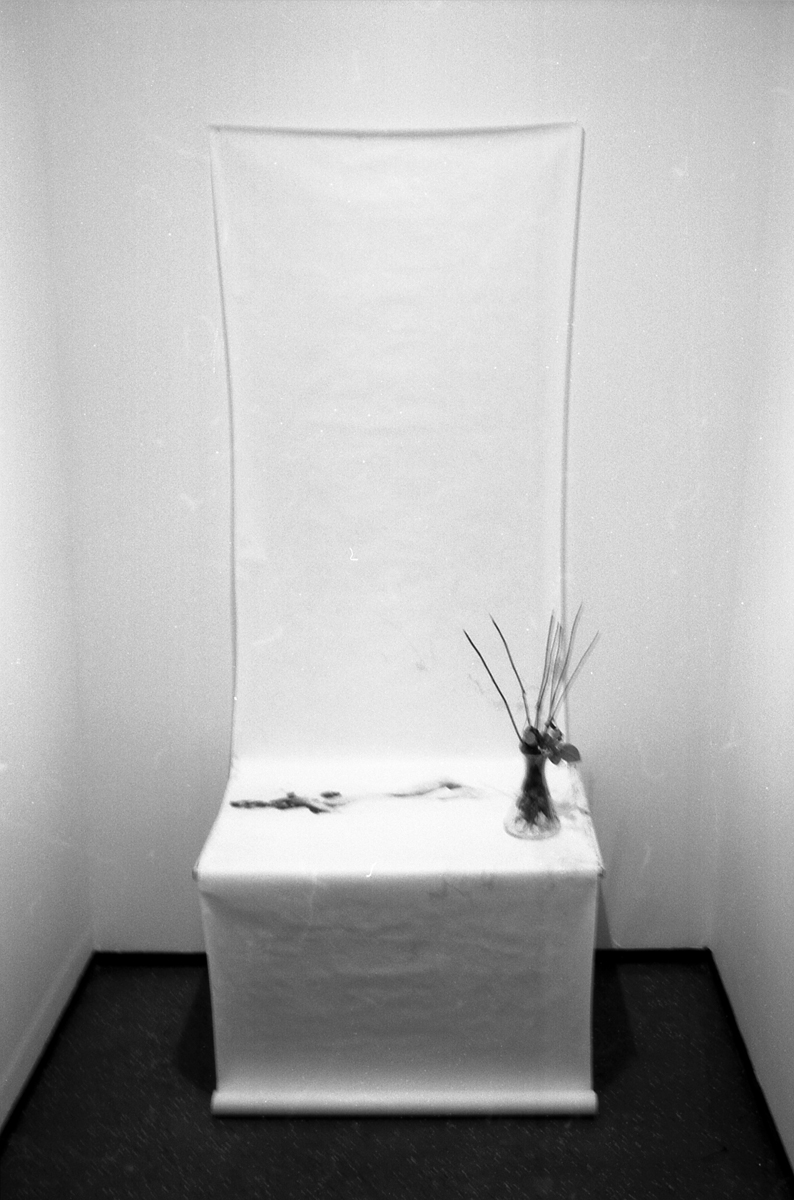
B. N. arrived somewhat later. He took one glance at the image and asked what the title was. White Wedding, he said. B. went out, and quickly came back with a bouquet of fresh roses and a glass vase. He stuffed the bouquet into the vase, with its stems sticking out at the top, and left.
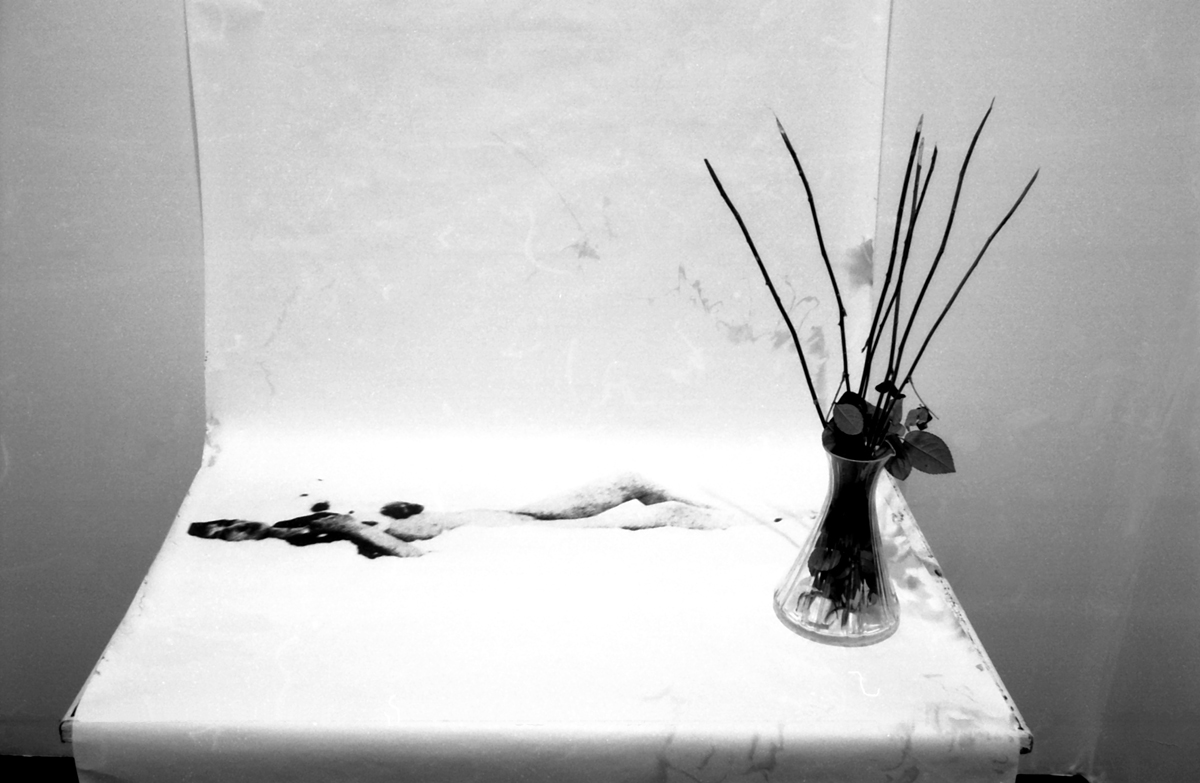
Josef called right before the exhibition's opening. It was likely one of their last conversations. He told him he'd brought the Dachau girl to Frankfurt. "Good", he said. He also told him she was lying there on the table. Everything was white: the walls, the pictures, the body, the snow, as if it was truly a wedding. "But I can't touch her," he said. "No one is expecting this from you," Josef said. All afternoon and night he sat in the booth with the girl in the hot, motionless snowstorm. A weightless silence surrounded him, a soft, pliant aether, protection, as if someone had stuffed the space between his existence, and his surroundings, with a cotton-like substance. Then someone suddenly called him. At least that's how he understood the sounds he'd heard, so he stood up and tried to leave the booth, but he couldn't find the exit. He stumbled and turned, raised his chin up as though he were blind, and squinted blankly into the whiteness. He fumbled with his hands, hesitantly, in the air, then dropped his arms and stood still. He thought he'd gone blind. Obviously, snow blindness, white blindness. Then someone took his hand and led him out of the booth.
When
he arrived in Bedburg-Hau, he knew it would be his last project with Josef.
He just didn't know yet that Josef was dead. They traveled for hours on empty
freeways, then took one of the exits. The road wound this way and that, through
the empty, one-road towns. No object or plant moved, as if an airtight
dome had crashed onto the countryside. Then they arrived at the tall, fenced-off
reserve 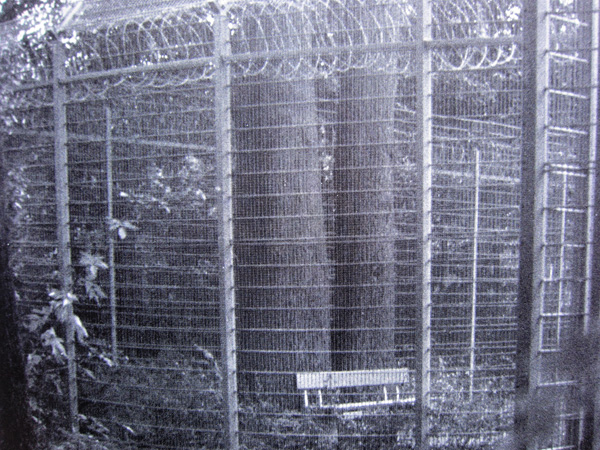 .
They drove past the main entrance's vaulted open stone gates, parked the
car and got out. It was as if they'd stepped into a film noir
version of a Grimm folktale. Among scraggy, atrophied trees and torn
underbrush, gloomy, catatonic buildings, dirt roads or trails littered with
crushed stones that seemingly led nowhere
.
They drove past the main entrance's vaulted open stone gates, parked the
car and got out. It was as if they'd stepped into a film noir
version of a Grimm folktale. Among scraggy, atrophied trees and torn
underbrush, gloomy, catatonic buildings, dirt roads or trails littered with
crushed stones that seemingly led nowhere 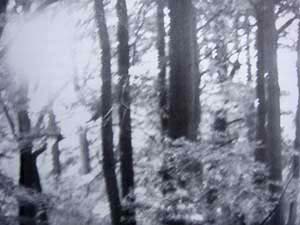 .
They looked around, squinted, but couldn't see the sky from anywhere; they couldn't
see it, yet it was there, swirling above them, but so uniformly grey it didn't
divide the space. They wandered without purpose, three of them in three separate
directions, when suddenly, a "dry", middle-aged woman appeared from
the greyness, greeted them in a scratchy voice and led them to one of the nearby
buildings. Once they arrived at the gate, he knew he couldn't expect to find
anything good here
.
They looked around, squinted, but couldn't see the sky from anywhere; they couldn't
see it, yet it was there, swirling above them, but so uniformly grey it didn't
divide the space. They wandered without purpose, three of them in three separate
directions, when suddenly, a "dry", middle-aged woman appeared from
the greyness, greeted them in a scratchy voice and led them to one of the nearby
buildings. Once they arrived at the gate, he knew he couldn't expect to find
anything good here 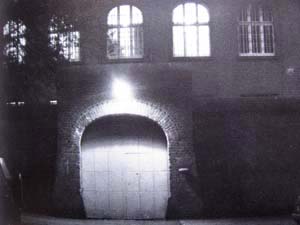 .
They stepped into a tall, ice-cold, stone market hall. All the spaces in the
hall were already taken, the woman said impassively. Hallways and rooms of various
sizes opened up from the market hall. The doors were all open; all the rooms
were occupied with someone doing something, mostly middle-aged women similar
in constitution to the woman leading them. They moved silently and purposefully,
as if they were nurses in daily life, plain-clothed but still on duty.
They did their work intently, neither aware of each other, nor themselves. K
finally got a space for her statues in the hall, after all. She and R
got two former wardrooms next to each other. "Will this suffice?"
asked the woman. "It's perfect," J said, but only looked around the
room after saying so. He liked the space, the barred windows that faced the
stunted trees
.
They stepped into a tall, ice-cold, stone market hall. All the spaces in the
hall were already taken, the woman said impassively. Hallways and rooms of various
sizes opened up from the market hall. The doors were all open; all the rooms
were occupied with someone doing something, mostly middle-aged women similar
in constitution to the woman leading them. They moved silently and purposefully,
as if they were nurses in daily life, plain-clothed but still on duty.
They did their work intently, neither aware of each other, nor themselves. K
finally got a space for her statues in the hall, after all. She and R
got two former wardrooms next to each other. "Will this suffice?"
asked the woman. "It's perfect," J said, but only looked around the
room after saying so. He liked the space, the barred windows that faced the
stunted trees 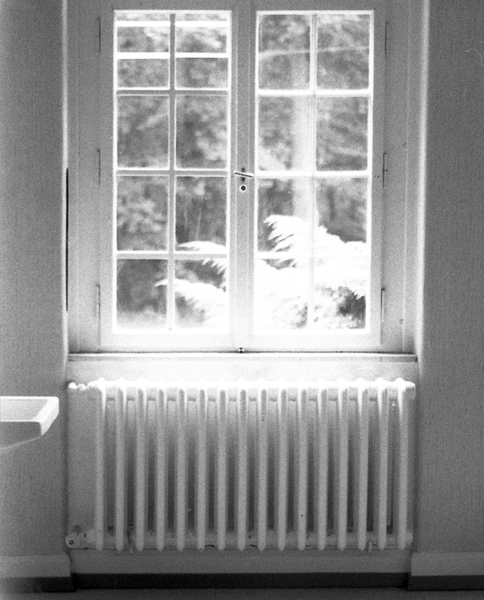 ,
the trough-shaped sink mounted on the wall at the end of the empty room, the
filthy wallpaper, the greyed linoleum that looked like stiff skin. He knew that
Josef would like the place, too, but he didn't think about him anymore, and
he never would again. He went back to the car, helped the others unpack, then
grabbed a large, but not too heavy, closed cardboard box, and took it into the
building. At first, he put it down in the hallway, took from it a
name plate without a frame, and hung it up on a nail, where the room number
must once have been. Later he had no idea anymore where the name came
from: Marie-Louise Panderella. For a while he thought it may have come from
R's collection, who had tried to read the names of patients who died at the
institution off the broken, faded tombstones behind the house
,
the trough-shaped sink mounted on the wall at the end of the empty room, the
filthy wallpaper, the greyed linoleum that looked like stiff skin. He knew that
Josef would like the place, too, but he didn't think about him anymore, and
he never would again. He went back to the car, helped the others unpack, then
grabbed a large, but not too heavy, closed cardboard box, and took it into the
building. At first, he put it down in the hallway, took from it a
name plate without a frame, and hung it up on a nail, where the room number
must once have been. Later he had no idea anymore where the name came
from: Marie-Louise Panderella. For a while he thought it may have come from
R's collection, who had tried to read the names of patients who died at the
institution off the broken, faded tombstones behind the house 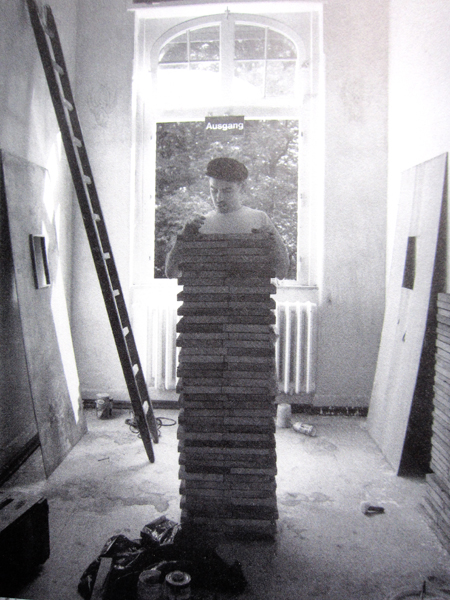 .
He later found the actual list of names in a document, but this name
was not part of it. He never visited Bedburg-Hau after the exhibition. Later,
he didn't even remember when he took down the pieces, or where they ended up.
Twenty years later, he himself was surprised when, while cleaning out one of
the outer warehouses, he found two big boxes with the complete installation
and a few fragmentary drafts. Up until then, he had thought that only a few
low-quality, black and white photos, taken on location, remained of the room
interior. The original installation plan, titled Identifikationssuch(t),
was prepared for a long, narrow hallway and used up all the Szondi test portraits.
In a later note he wrote: "I think I truly understood the point of the
installation when I tried to imagine the original plan. The long, narrow, horizontal
hallway that looked like a shaft, which was so narrow that images on the opposite
wall were barely visible, so the spectator was constantly facing the impossibility
of seeing, and so looks almost compulsively for new perspectives and positions,
so that she can see the images somehow, while she drifts, escapes to one of
the hallway's ends, from where she can suddenly see the entire installation's
axis. From this perspective she cannot see a single image, yet she can intuitively
recognize the entire installation's rhythm, dynamic, and correlation."
He found the following concrete information for the panel images and the installation
plans: "Corridor Installation. The entire installation consists of 96 pictures.
The size of the mirrors is 17 x 24 cm, their thickness 4 mm. The width of the
foils is 18 cm. The size of the small images (that is, the panels) is 5.7 x
8 cm. The distance between the big and small pictures which belong together
is one centimeter. The distance between the picture pairs is two centimeters."
A series of numbers also appears in the fragmentary, handwritten note: 14, 47,
6, 42, 39, 34, 21, 48, 44, 19 – reserve: 3, 12. The numbers clearly refer to
the series of numbers for the cards of the Szondi test. Based on the pictures,
ten large and ten small images were lined up along each of the long walls of
the room, across from each other. The large images on the wall with the sink
featured figures of the Szondi test,
.
He later found the actual list of names in a document, but this name
was not part of it. He never visited Bedburg-Hau after the exhibition. Later,
he didn't even remember when he took down the pieces, or where they ended up.
Twenty years later, he himself was surprised when, while cleaning out one of
the outer warehouses, he found two big boxes with the complete installation
and a few fragmentary drafts. Up until then, he had thought that only a few
low-quality, black and white photos, taken on location, remained of the room
interior. The original installation plan, titled Identifikationssuch(t),
was prepared for a long, narrow hallway and used up all the Szondi test portraits.
In a later note he wrote: "I think I truly understood the point of the
installation when I tried to imagine the original plan. The long, narrow, horizontal
hallway that looked like a shaft, which was so narrow that images on the opposite
wall were barely visible, so the spectator was constantly facing the impossibility
of seeing, and so looks almost compulsively for new perspectives and positions,
so that she can see the images somehow, while she drifts, escapes to one of
the hallway's ends, from where she can suddenly see the entire installation's
axis. From this perspective she cannot see a single image, yet she can intuitively
recognize the entire installation's rhythm, dynamic, and correlation."
He found the following concrete information for the panel images and the installation
plans: "Corridor Installation. The entire installation consists of 96 pictures.
The size of the mirrors is 17 x 24 cm, their thickness 4 mm. The width of the
foils is 18 cm. The size of the small images (that is, the panels) is 5.7 x
8 cm. The distance between the big and small pictures which belong together
is one centimeter. The distance between the picture pairs is two centimeters."
A series of numbers also appears in the fragmentary, handwritten note: 14, 47,
6, 42, 39, 34, 21, 48, 44, 19 – reserve: 3, 12. The numbers clearly refer to
the series of numbers for the cards of the Szondi test. Based on the pictures,
ten large and ten small images were lined up along each of the long walls of
the room, across from each other. The large images on the wall with the sink
featured figures of the Szondi test,
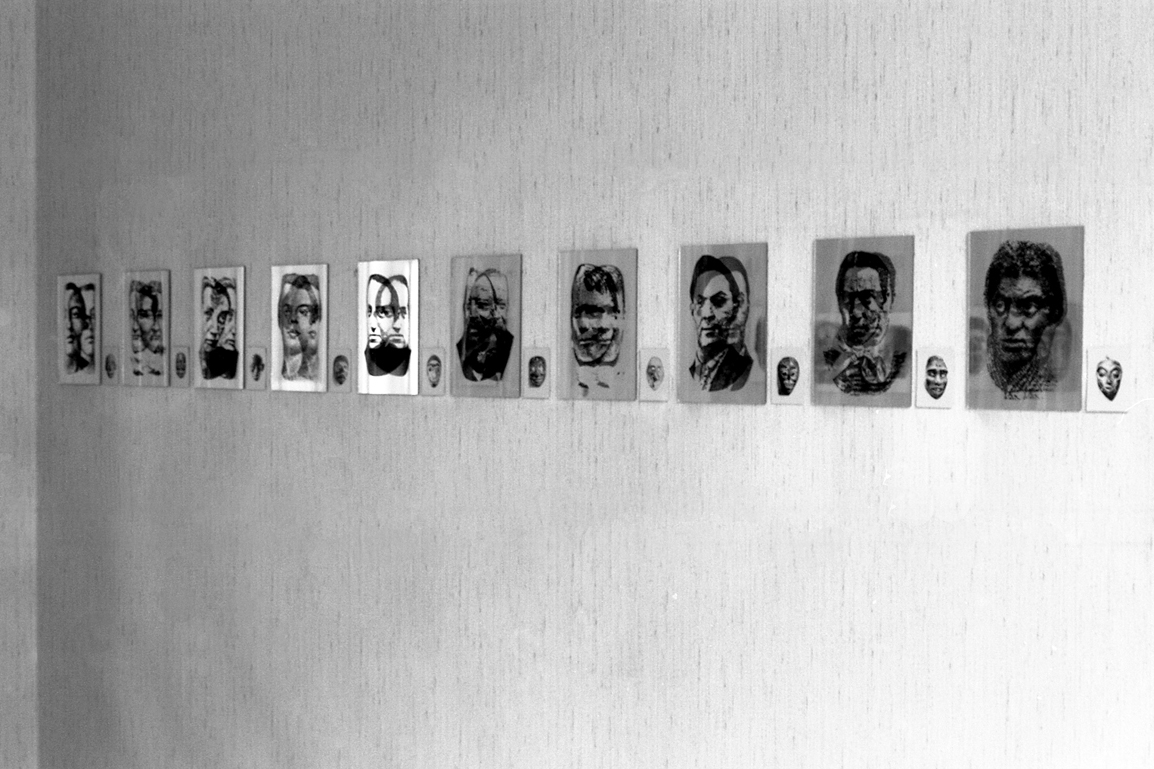
while the images on the wall opposite represented African masks.
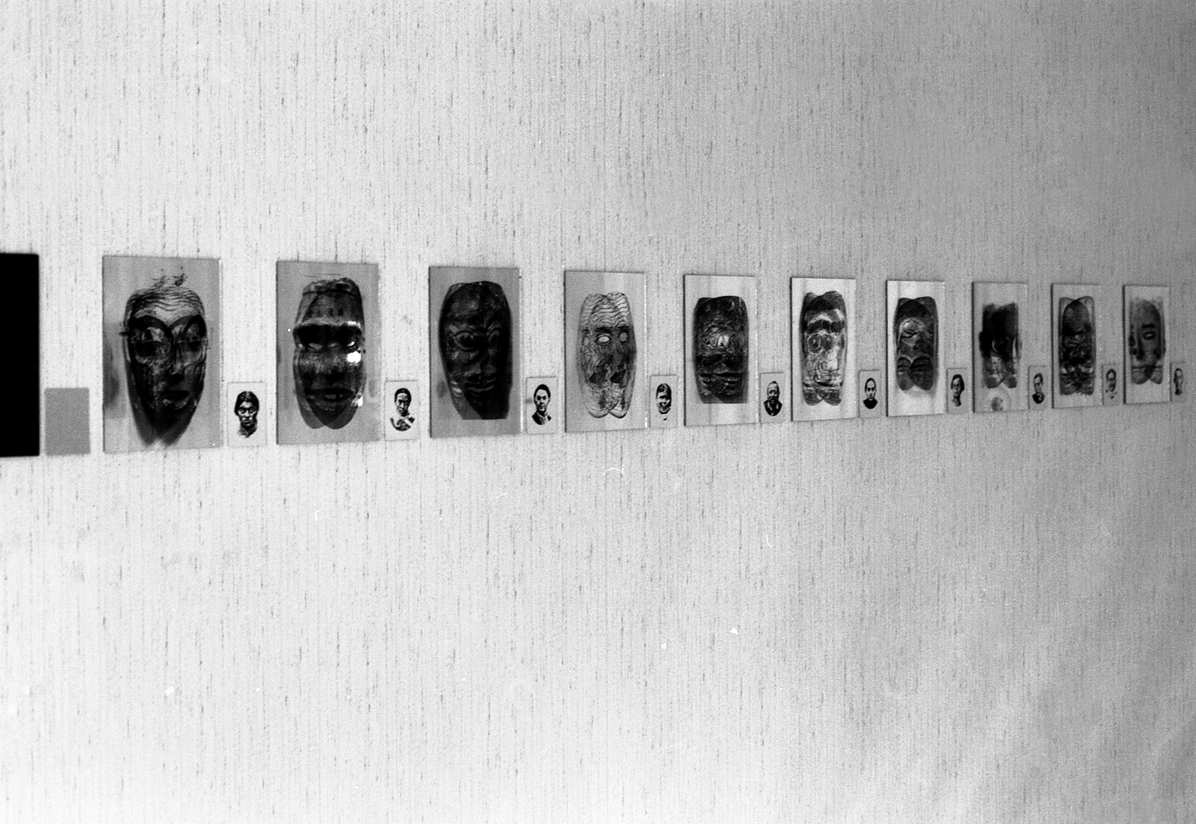
For every large image, a small image had been ordered to match the adequate corresponding facial expression to it from the opposite series.
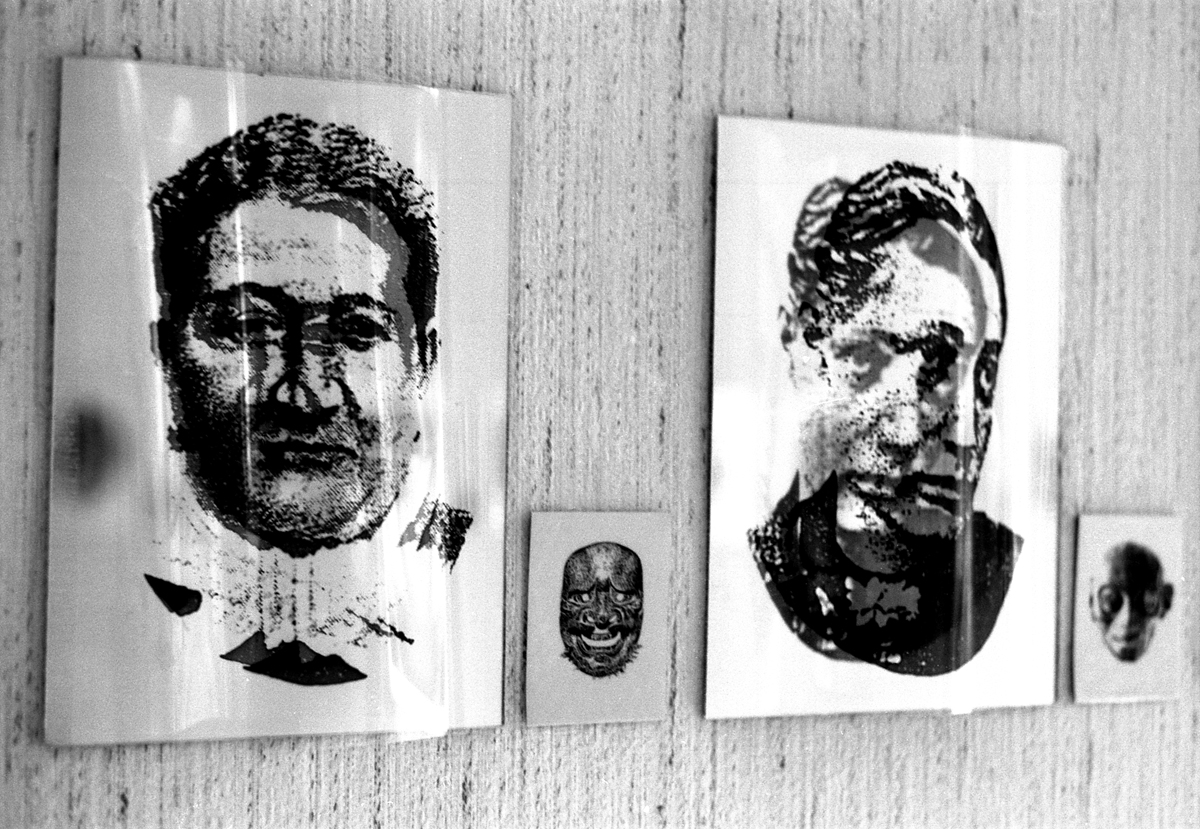
He glued the portraits copied onto the foils onto the mirrors, longways. Since the foils were wider than the mirrors, every portrait protruded forward at an approximately similar angle.
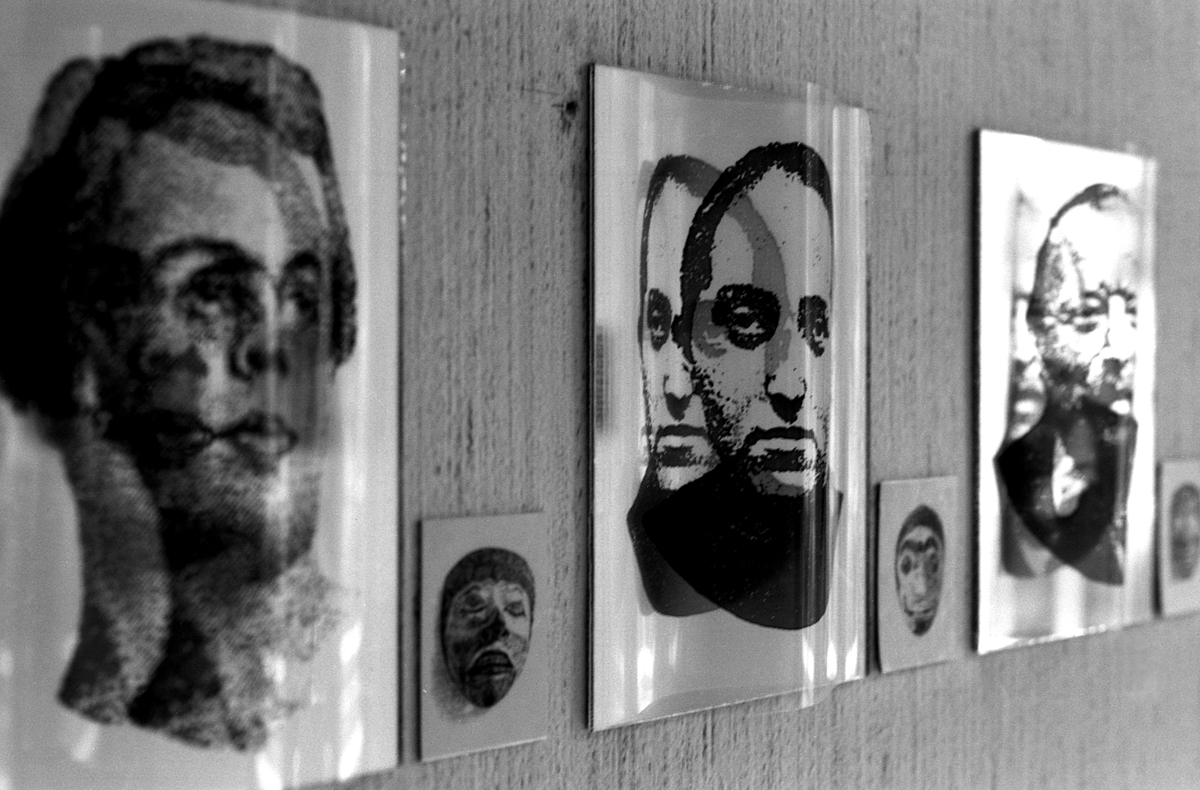
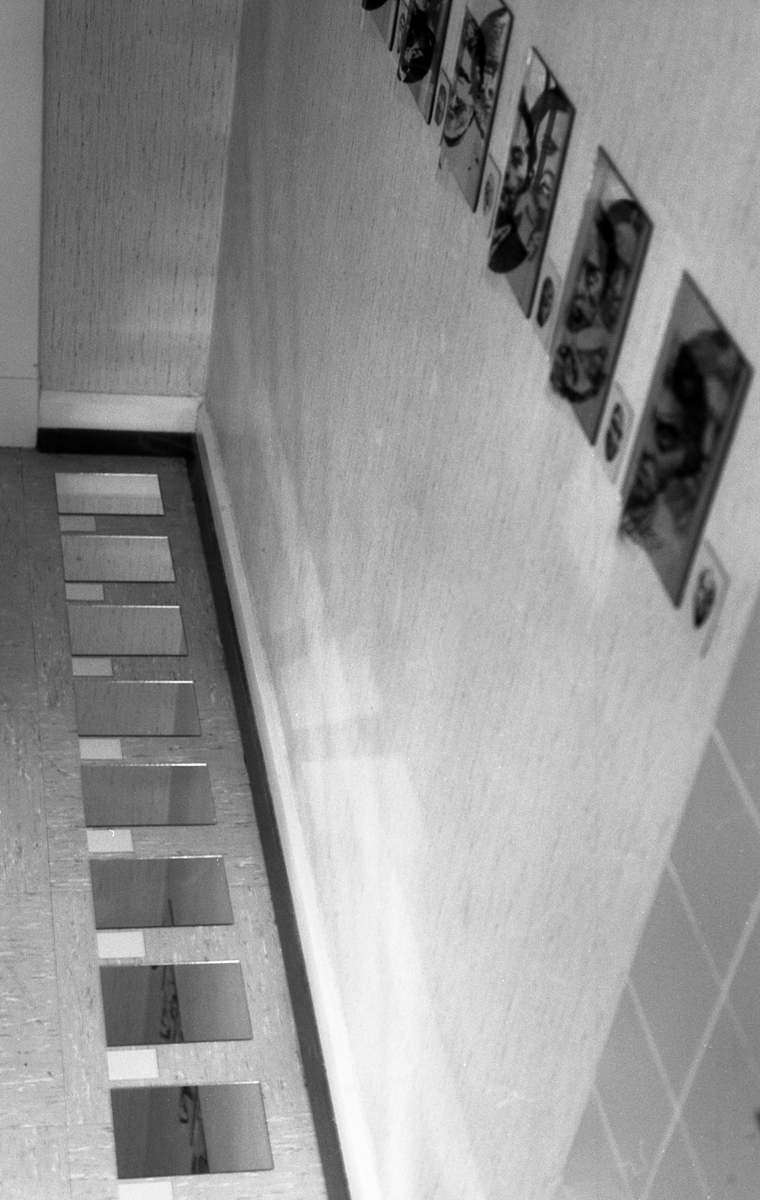
The portraits of the Szondi test did not continue above the sink. There was water in the sink, as if it was a continuation of the mirrors.
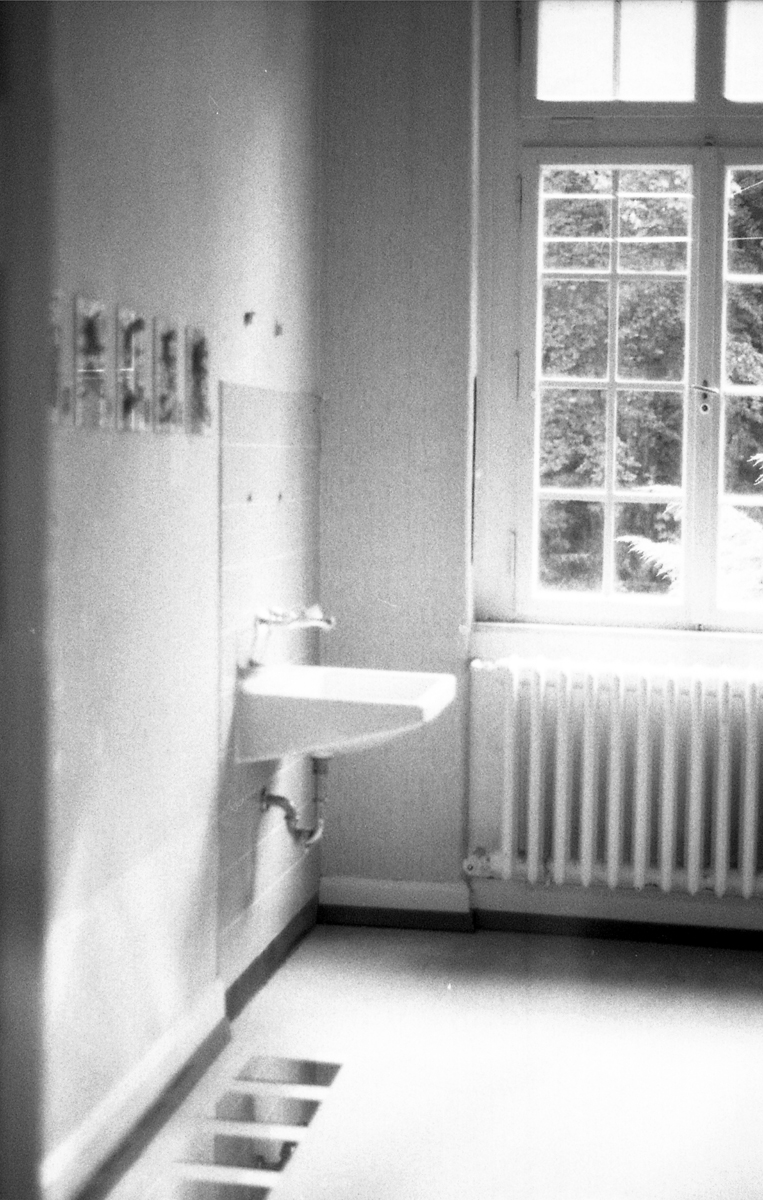
When he was finished with the ward's furnishings, he packed up his tools, stepped out of the place and, without turning back, closed the door. He felt neither the time nor the space behind himself, like waking up out of a dream. His last hazy memory was of the click of the lock's tongue.
Late at night, he went back from Bedburg alone. He was already sitting in the cold, dark car, like in an unlit deep sea submarine, when his phone went off, on the seat beside him. He didn't want to pick it up, didn't even take his hands off the wheel, that's how he glanced at it. He stared at the screen with exhausted, dimwitted shock. It was Josef's old New York number. He was still as he stared at the numbers lit up on the screen, then he picked up. "Hi, I'm Jeff!", a stranger's cheery voice squawked into the phone. "Jeff?" he asked in shock, elongating the "e" sound, but before he could continue, all the person said was: "Oh, sorry, wrong number," and hung up.
It was night
when he arrived in Cologne. He just paced around the apartment. He took off
his clothes and fell into a deep sleep. At some point, he dreamt that Josef
finally did, in fact, go up to the third floor and stayed there. Only the black
person remained downstairs, like a shadow, an impression. Forever. Or at least
until he'd wake up again.
1990 / September 18, 2005. / November 26, 2017 //
generously
supported by TOTalJoy 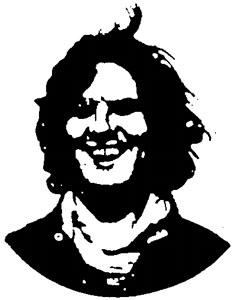
b a c k to group15november.com // to interment.de